
DEFINED
CONTRIBUTION
PLANS
403(b) Investment
Options, Fees, and
Other Characteristics
Varied
Report to the Chairman, Committee on
Education and Labor, House of
Representatives
March 2022
GAO-22-104439
United States Government Accountability Office
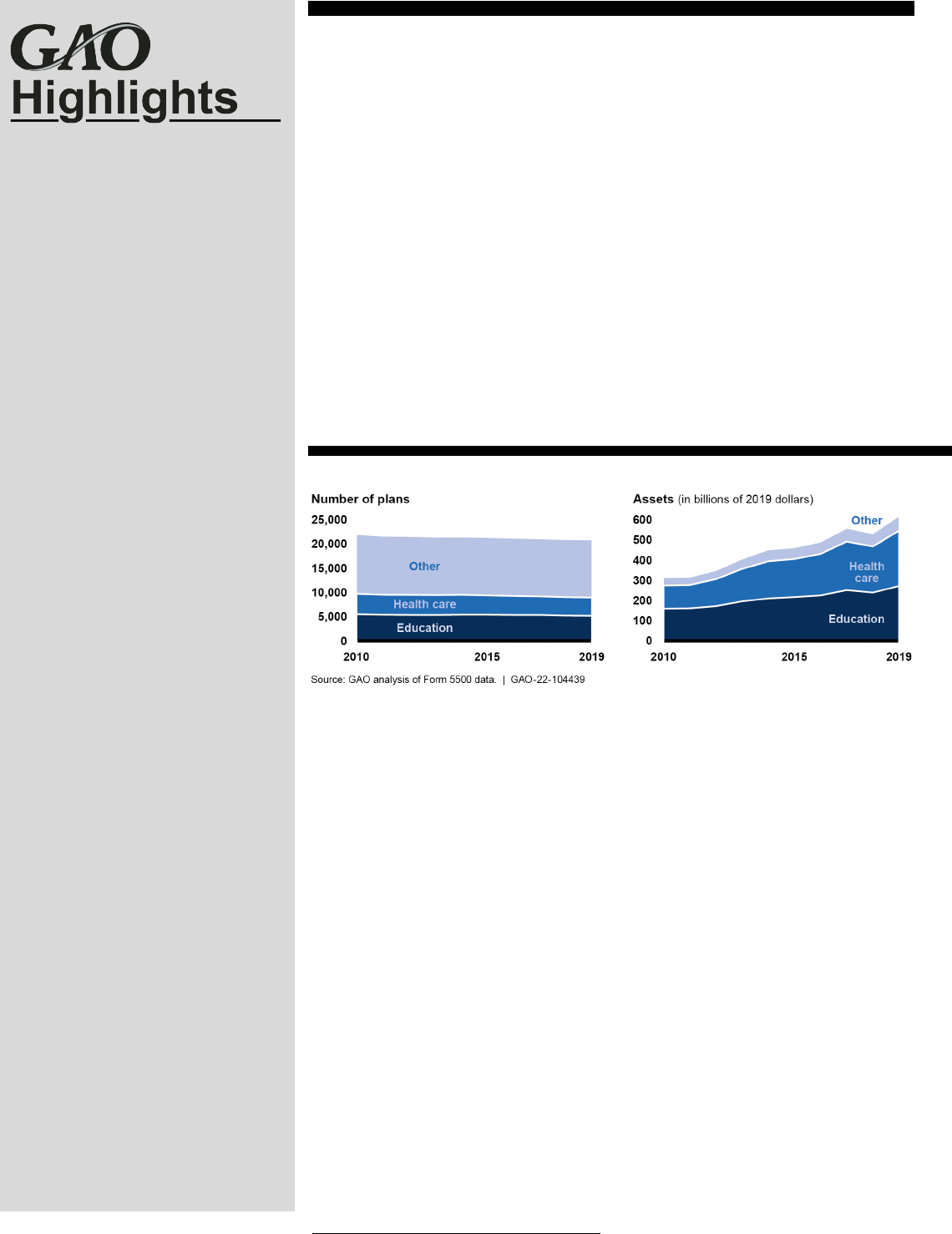
United States Government Accountability Office
Highlights of GAO-22-104439, a report to the
Chairman, Committee on Education and
Labor, House of Representatives
March 2022
DEFINED CONTRIBUTION PLANS
403(b) Investment Options, Fees, and Other
Characteristics Varied
What GAO Found
Total assets held by 403(b) plans—retirement savings plans for certain public
sector and tax-exempt sector employees—amounted to more than $1.1 trillion in
2020, according to industry data, and other characteristics varied. Industry data
show that about half of these assets were held in plans covered by the Employee
Retirement Income Security Act of 1974, as amended, (ERISA), which are
generally required to submit an annual filing known as the Form 5500. ERISA
403(b) assets grew from 2010 to 2019, the most recent year for which 5500 data
are available, while the number of plans declined, as shown in the figure.
Number of 403(b) ERISA Plans and Value of Plans’ Assets, by Sector, 2010-2019
According to industry experts and 5500 data, these trends likely resulted from
consolidation of firms in the health care sector, which represents a large portion
of plan assets. The vast majority—93 percent—of ERISA 403(b) plans were the
employer’s sole or primary retirement plan. While less information is available for
403(b) plans not covered by ERISA (non-ERISA plans), which do not file a Form
5500, of the 21 plan sponsor respondents to GAO’s survey, most stated their
plans were supplemental to another retirement savings plan offered by the
employer. Available data also show that the number of investment options, which
may be annuities or mutual funds, offered by 403(b) plans varied but were
generally higher than the number offered by 401(k) plans in the private sector.
Fees for 403(b) plans varied widely according to GAO’s survey of ERISA and
non-ERISA plan sponsors and service providers, as well as Form 5500 data. For
example, plans that GAO surveyed reported record keeping and administrative
service fees ranging from 0.0008 percent of plan assets to 2.01 percent of plan
assets. In addition, fees for investment options offered by the plan ranged from
0.01 percent to 2.37 percent among plans GAO surveyed. Prior GAO work has
shown that even seemingly small fees can significantly reduce participants’
retirement savings over time. Available data also show that large 403(b) plans
had lower administrative fees than smaller ones. In GAO’s survey, university,
state-sponsored, and plan sponsors with $1 billion or more in assets reported
taking multiple steps to reduce fees, while other sponsors more often reported
not having information that would help them monitor fees. For example, five
public school district plan sponsors reported that they did not know expense
ratios, which are measures of how much of a fund's assets are used for
administrative and other operating expenses, for investment options offered by
their plan that would also allow them to monitor fees.
View GAO-22-104439. For more information,
contact Tranchau (Kris) T. Nguyen at
(202) 512
-7215 or nguyentt@gao.gov.
Why GAO Did This Study
Millions of teachers and other
employees of public schools,
universities, and
tax-exempt
organizations rely on savings they
accumulate in 403(b) plans to provide
income security in retirement. Like
401(k) plans, 403(b) plans are
account
-based defined contribution
plans sponsored by employers, and
individuals who participate in the plans
make investment decisions and bear
the investment risk. Private sector
employer
-sponsored retirement plans
are generally subject to ERISA
requirements intended to protect th
e
interests of plan participants. However,
some 403(b) plans are not covered by
ERISA. This report addresses
(1) the
number and characteristics of 403(b)
pl
ans; and (2) fees charged to 403(b)
plan participants.
For this report, GAO
analyzed plan-
level char
acteristics—including the
number of participants, the amount of
plan assets, and available information
on plan investment offerings from 2010
through 2019
—the most recent year
for which data are available
—from the
Department of Labor’s
(DOL) Form
5500 data
base as well as available
industry data. GAO analyzed
individual
-level data from the Health
and Retirement Study (HRS) of
respondents
over age
50 who reported
participating in 403(b) plans. GAO also
analyzed information on plan
characteristics and fees fro
m non-
generalizable surveys
GAO conducted
of 403(b) plan sponsors and 403(b)
service providers (a total of 45 survey
responses), and interviewed
DOL and
other U.S. agency officials,
industry
stakeholders
, and experts identified as
being knowledgeable about
403(b)
plans.

Page i GAO-22-104439 Defined Contribution Plans
Letter 1
Background 5
Available Data Show That Total 403(b) Plan Assets Have
Increased since 2010 and Other Characteristics, such as Plan
Participation, Varied Among Plans 13
Fees for 403(b) Plans Varied Widely, and Some Plans Reported
They Lacked Knowledge of Investment Fees 30
Agency Comments 51
Appendix I Objectives, Scope, and Methodology 53
Appendix II Detailed Findings from Analysis of Health and Retirement Study Data 63
Appendix III Detailed Data on Fees from Surveys of 403(b) Plan Sponsors and
Service Providers 70
Appendix IV Reported Surrender Fees and Short-Term Trading Fees by 403(b)
Plan Sponsors and Service Providers Surveyed 77
Appendix V GAO Contact and Staff Acknowledgements 80
Tables
Table 1: Examples of Administrative and Investment Fees That
May Be Charged in 403(b) Plans 8
Table 2: Extent to Which Service Providers Surveyed by GAO
Reported 403(b) Plan Clients Offered Annuities and/or
Mutual Funds 28
Table 3: Investment Offerings and Knowledge of 403(b) Asset
Allocation Reported by the Eight Public School District
Plans That Responded to GAO’s Survey 29
Table 4: Percentage of ERISA 403(b) Plans Reporting Paying
Fees of $5,000 or More , by Fee Category 43
Contents

Page ii GAO-22-104439 Defined Contribution Plans
Table 5: Retirement Plan Participant Counts, Assets, Numbers of
Plan Investment Options, and Range of Fees and
Expenses for Plan Sponsors Surveyed by GAO 70
Table 6: 403(b) Retirement Plan Participant Counts, Total Assets,
and Range of Fees and Expenses for 403(b) Service
Providers Surveyed by GAO 74
Table 7: Summary of Surrender Fee Information Obtained From
Plan Sponsor Survey Respondents 77
Table 8: Summary of Surrender and Short-Term Trading Fee
Information Obtained From 403(b) Service Provider
Survey Respondents 78
Figures
Figure 1: The Type of Employer and Extent of the Employer’s
Involvement in the Plan Can Determine Whether a 403(b)
Plan Is Subject to ERISA 10
Figure 2: Number of 403(b) ERISA Plans and Value of ERISA
Plans’ Assets, by Sector, 2010-2019 15
Figure 3: Reported Number of Investment Options Offered by
403(b) Plan Sponsors Surveyed by GAO 24
Figure 4: Trends in ERISA 403(b) Plans Offering Annuities Only,
Mutual Funds Only, or Both Annuities and Mutual Funds,
by Asset Value, 2010-2019 27
Figure 5: Reported Ranges and Calculated Medians of Expense
Ratios for Investment Options for Plan Sponsors
Surveyed by GAO 33
Figure 6: Illustrative Examples of Surrender Fees on a
Hypothetical Participant’s Account Balance, with an Initial
Account Balance of $10,000 39
Figure 7: ERISA 403(b) Plans Reporting No Direct Administrative
Fees, 2019 42
Figure 8: Reported Average Direct Fee Amounts as a Percentage
of Assets Paid by 403(b) ERISA Plans for Administrative
Services, by Plan Size in Terms of Number of
Participants, 2019 45
Figure 9: Median Expense Ratios as a Percentage of Assets Paid
by 403(b) Plan Sponsors, by Plan Size in Terms of Total
Assets, from Example Plans Provided by 403(b) Service
Providers 47

Page iii GAO-22-104439 Defined Contribution Plans
Figure 10: Estimated Percentage of Individuals Who Reported
Having a 403(b) or 401(k) Account as Their Only Plan,
Primary Plan, or Supplemental Plan, 2016 64
Figure 11: Estimated Percentage of Individuals Who Reported
Having a 403(b) or 401(k) Account, by Employer’s
Sector, 2016 64
Figure 12: Estimated Percentage of Individuals Who Reported
Having a 403(b) or 401(k) Account, by Gender, 2016 65
Figure 13: Estimated Percentage of Individuals Who Reported
Having a 403(b) or 401(k) Account, by Race, 2016 66
Figure 14: Estimated Percentage of Individuals Who Reported
Having a 403(b) or 401(k) Account, by Age, 2016 66
Figure 15: Estimated Percentage of Individuals Who Reported
Having a 403(b) or 401(k) Account, by Education Level,
2016 67
Figure 16: Estimated Percentage of 403(b) Retirement Accounts’
Respondents Reported Household Assets, Compared to
401(k) Account Holders, 2016 68
Figure 17: Estimated Percentage of 403(b) Retirement Accounts’
Respondents Reported Earnings, Compared to 401(k)
Account Holders, 2016 68

Page iv GAO-22-104439 Defined Contribution Plans
Abbreviations
DOL Department of Labor
EBSA Employee Benefits Security Administration
ERISA Employee Retirement Income Security Act of 1974, as
amended
HRS Health and Retirement Study
ICI Investment Company Institute
IRC Internal Revenue Code
IRS Internal Revenue Service
NAICS North American Industry Classification System
NTSA National Tax-Deferred Savings Association
TPA third-party administrator
This is a work of the U.S. government and is not subject to copyright protection in the
United States. The published product may be reproduced and distributed in its entirety
without further permission from GAO. However, because this work may contain
copyrighted images or other material, permission from the copyright holder may be
necessary if you wish to reproduce this material separately.
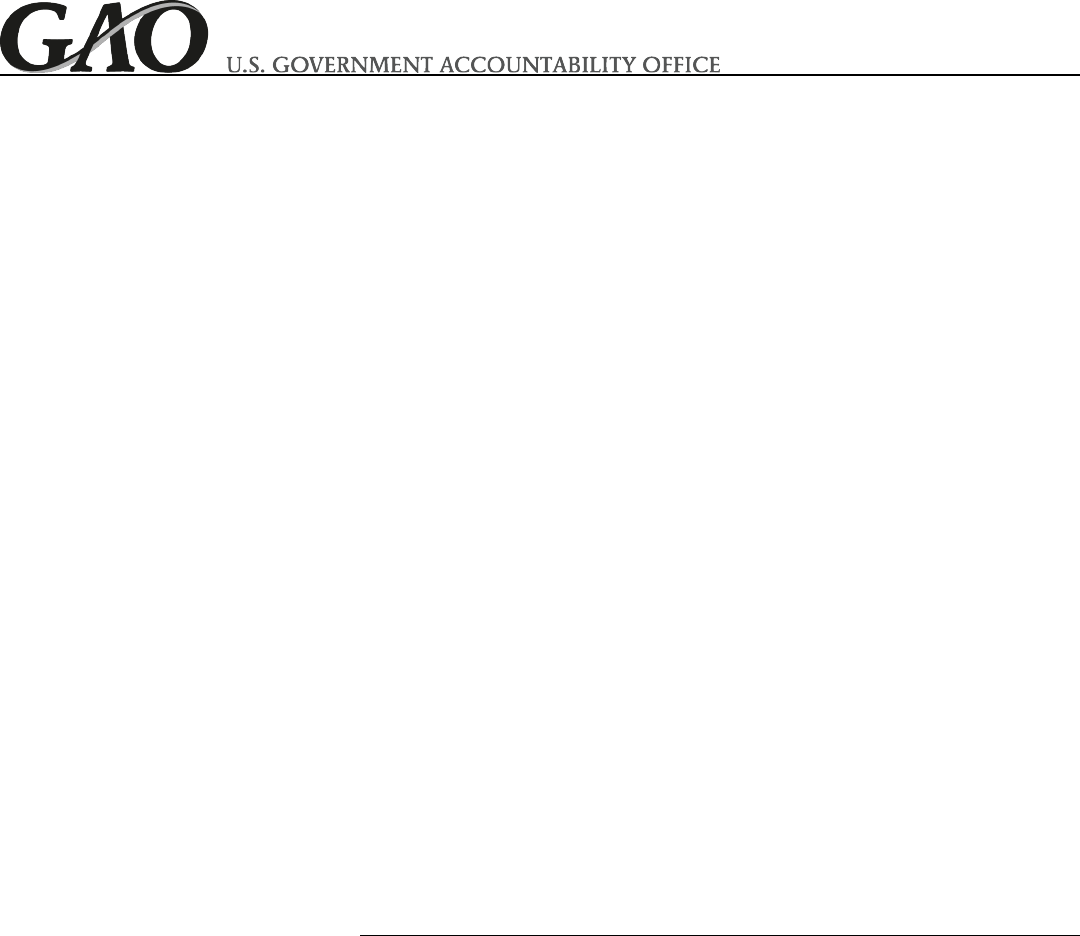
Page 1 GAO-22-104439 Defined Contribution Plans
441 G St. N.W.
Washington, DC 20548
March 4, 2022
The Honorable Robert C. “Bobby” Scott
Chairman
Committee on Education and Labor
House of Representatives
Dear Chairman Scott:
Millions of teachers and other employees of public schools, universities,
and tax-exempt organizations rely on savings they accumulate in 403(b)
plans to provide income security in retirement. Like 401(k) plans offered
by many private sector employers, 403(b) plans are account-based
defined contribution plans sponsored by employers, and individuals who
participate in the plans make investment decisions and bear the
investment risk.
1
Currently, 403(b) plans are estimated to hold more than
$1 trillion in assets.
2
However, little is known about these plans’
investment options and fee structures—features that can affect how much
participants’ retirement savings will grow.
Certain aspects of 403(b) plans’ regulation differ from 401(k) and other
defined contribution plans in key ways. While 401(k) plans are covered by
the Employee Retirement Income Security Act of 1974, as amended
(ERISA), only some 403(b) plans are covered by ERISA (ERISA plans).
For example, 403(b) plans offered by state or local governments, such as
public school districts or public universities are not covered by ERISA.
1
A defined contribution plan is an employer-sponsored account based retirement plan,
such as a 401(k) plan, that allows individuals to accumulate tax-advantaged retirement
savings in an individual account based on employee and/or employer contributions, and
the investment returns (gains and losses) earned on the account. While 401(k) plans can
be offered by private sector employers, 403(b) plans can be offered by private sector tax-
exempt employers or certain public school employers. A defined benefit plan is an
employer-sponsored retirement plan that typically provides a lifelong stream of payments
beginning at retirement, based on a formula specified in the plan that takes into account
factors such as the employee’s salary, years of service, and age at retirement. See GAO,
The Nation’s Retirement System: A Comprehensive Re-evaluation Is Needed to Better
Promote Future Retirement Security, GAO-18-111SP (Washington, D.C.: Oct. 18, 2017).
2
See Investment Company Institute, The U.S. Retirement Market, Third Quarter 2021. ICI
is an association representing regulated funds globally, including mutual funds, in the
United States, and similar funds offered to investors in jurisdictions worldwide. By
contrast, the Department of Labor has estimated that in 2019 there were 91 million
participants and $6.2 trillion in 401(k) plans. See the Department of Labor, Private
Pension Plan Bulletin: Abstract of 2019 Form 5500 Annual Reports (September 2021).
Letter

Page 2 GAO-22-104439 Defined Contribution Plans
ERISA establishes minimum standards and requirements intended to
protect plan participants and beneficiaries in most private sector
employer-sponsored retirement plans. 403(b) plans not covered by
ERISA (non-ERISA plans) are not subject to ERISA’s fiduciary
requirements, although these plans may be subject to state consumer
protection laws or other state-specific fiduciary laws.
This report addresses (1) the number and characteristics of ERISA and
non-ERISA 403(b) plans; and (2) fees charged to 403(b) plan
participants.
To describe the number and characteristics of 403(b) plans, we first
analyzed plan-level characteristics—including the number of participants,
the amount of plan assets, and available information on plan investment
offerings for ERISA 403(b) plans from 2010 through 2019, the most
recent year for which data are available—from the Department of Labor
(DOL)’s Form 5500 Private Pension Plan data. DOL’s Form 5500
Database captures information from ERISA-covered retirement plans—
including ERISA 403(b) plans—on the number of plan participants, assets
held by the plan, and fees paid by the plan, among other things. To
identify 403(b) plans, we used self-reported plan type information as well
as a string search on the name of the plan. For the purposes of this
report, we generally defined the largest plans as those with $1 billion or
more in assets, unless otherwise indicated. We defined small plans as
those with either 99 or fewer participants, $1 million or less in assets, or
as otherwise indicated. We also, where feasible, compared our results for
403(b) plans with those of 401(k) plans, which according to DOL data are
the largest type of defined contribution plan by assets and number of
participants. We reviewed documentation about how Form 5500 data are
collected and conducted electronic data tests for completeness and
accuracy, and contacted knowledgeable officials with specific questions
about the data. We determined that the data for the variables we used
were sufficiently reliable for the purposes of our reporting objectives.
Second, we analyzed individual-level data from the Health and
Retirement Study (HRS) of respondents over age 50 who reported having
a retirement benefit in ERISA or non-ERISA 403(b) plans from 2010
through 2016—the most recent year for which complete weighted data
are available—including their household assets, education, and the

Page 3 GAO-22-104439 Defined Contribution Plans
industry in which they are employed.
3
We reviewed technical
documentation, conducted electronic data tests for completeness and
accuracy, and contacted knowledgeable experts with specific questions
about HRS data. We determined that the data for the variables we used
were sufficiently reliable for the purposes of reporting on the estimated
number of individuals who reported participating in an ERISA or non-
ERISA 403(b) retirement plan,
4
the extent to which the 403(b) plan was
the participant’s primary retirement plan or supplemental retirement plan,
and the selected demographic characteristics of these individuals. In
addition, we examined available data on ERISA and non-ERISA 403(b)
plans from industry publications and third-party research. We also
included relevant information obtained by our surveys, as described
below.
To provide available information on what is known about fees charged to
403(b) plan participants, especially those in non-ERISA plans, we
surveyed five selected key populations: four sets of 403(b) plan sponsors,
as well as one set of 403(b) service providers.
5
We received 26 survey
responses from plan sponsors and 19 survey responses from service
providers, for a combined total of 45 survey responses overall. We
conducted the surveys from May to November 2021 and obtained the
following response rate from our populations:
3
Since HRS respondents are asked only about the retirement accounts at their current
job, the survey may not capture information regarding respondents’ retirement accounts
from previous jobs or from retirees.
4
This question is only asked of those individuals who are currently employed; therefore,
our results reflect the estimated population of current employees over age 50 and their
spouses who have a retirement benefit, and does not reflect the more general population
of currently employed or retired individuals aged 50 or older.
5
Our plan sponsor survey respondents comprised five ERISA and 21 non-ERISA plans.
For more information on how we identified 403(b) plans and service providers to survey
and our response rates, see appendix I.
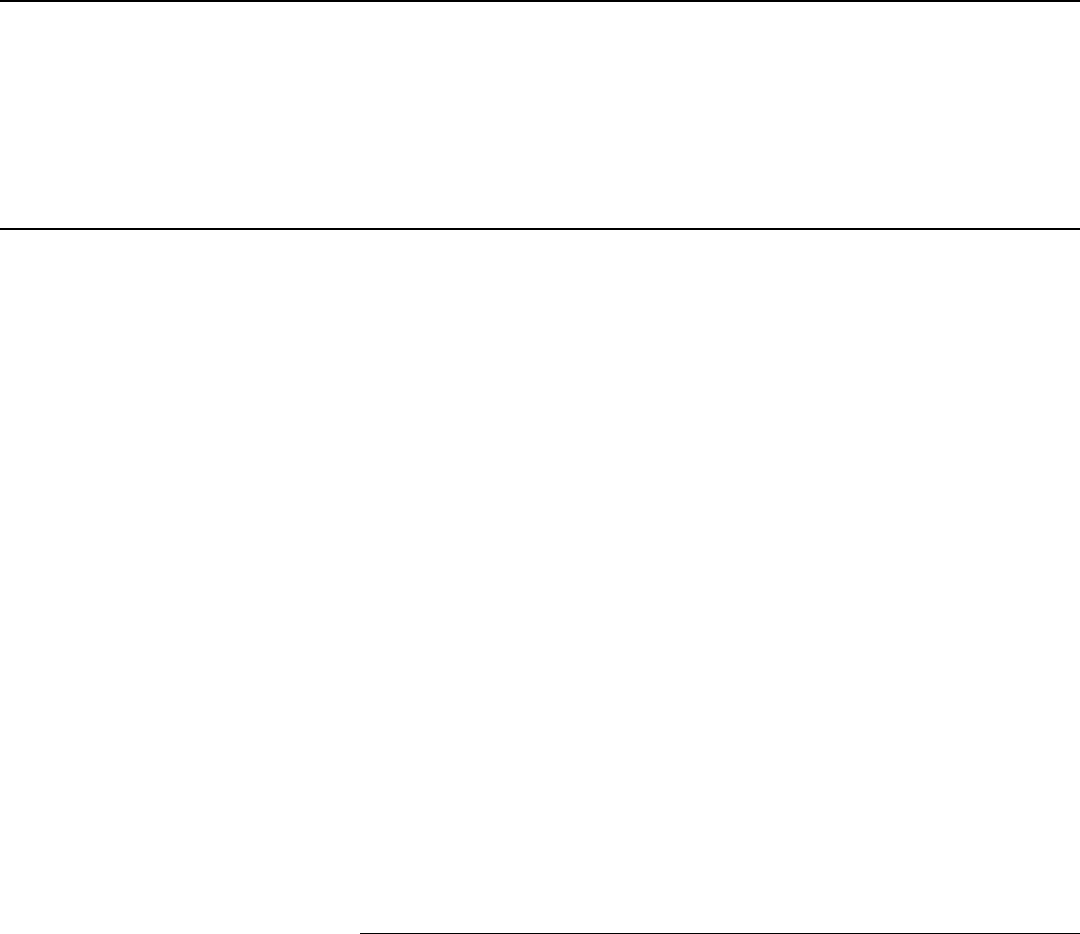
Page 4 GAO-22-104439 Defined Contribution Plans
• Nine of 14 state-sponsored 403(b) plans identified and compiled in a
list published by the National Tax-Deferred Savings Association
(NTSA);
6
• Five of 11 of the largest 403(b) plan sponsors, as identified by
Pensions and Investments;
7
• Five of 15 small 403(b) plan sponsors, as identified by a random
sample of plans from DOL’s 5500 filings of 99 or fewer participants
and plans from the Form 5500 filings with $1 million or less in total
assets;
8
• Seven of 26 K-12 school districts, including five of the 10 largest
districts as measured by the number of students in the district and
selected by a certainty sample; as well as one of the 20 districts
randomly selected out of the remaining districts in 50 states plus the
District of Columbia, as measured by number of students in the district
by the National Center for Education Statistics; as well as one other
provider of services to a set of multiple school districts within one
certain county that we included and counted as a school district; and
• Twelve of 18 companies who serve as major vendors or record
keepers, or third-party administrators, as identified by Pensions and
Investments or as identified as key 403(b) plan vendors or record
keepers in our interviews with experts. We also included seven other
6
The National Tax-Deferred Savings Association is an industry group whose members
include 403(b) and 457 plan sponsors and service providers. Three states on NTSA’s list
have discontinued their plans in the last 3 years. One of the state’s that discontinued its
plan completed a survey, and we included this response in our analysis. We excluded the
other two states from our count of those surveyed. In addition, two additional ongoing
state-sponsored plans, which we included in our count of those surveyed, did not respond
to our survey.
7
Pensions and Investments is a news publication written for pension, portfolio, and
investment management executives in the institutional investment market. Each year it
publishes a list of the largest 403(b) plan sponsors. We examined its 2019, 2020, and
2021 lists; when combined, it totaled 11 distinct plan sponsors. We also excluded one
sponsor that appeared on the list of state sponsored plans to avoid double counting.
8
We initially randomly selected 20 small plans—10 with 99 or fewer participants and 10
with $1 million or less in total assets according to Form 5500 data—however, we excluded
six for various reasons (for example, plans that had apparently been terminated since the
2018 Form 5500 filing), as detailed in appendix I. We obtained responses from 5 of the 15
small plans we surveyed.

Page 5 GAO-22-104439 Defined Contribution Plans
respondents, who operate as record keepers, third-party
administrators, vendors, or consultants for 403(b) plans.
9
We received 26 survey responses from plan sponsors and 19 survey
responses from service providers, for a combined total of 45 survey
responses overall. In addition, we analyzed available information on fees
from DOL’s Form 5500 data and conducted semi-structured interviews of
stakeholders and experts. These stakeholders and experts included
representatives of industry associations, research organizations, and
service providers to 403(b) plans we identified as being knowledgeable
about 403(b) plans based on their published research or other
documentation or based on referrals from other organizations we
interviewed. For more detailed information on our scope and
methodology, see appendix I.
We conducted this performance audit from July 2020 through March 2022
in accordance with generally accepted government auditing standards.
Those standards require that we plan and perform the audit to obtain
sufficient, appropriate evidence to provide a reasonable basis for our
findings and conclusions based on our audit objectives. We believe that
the evidence obtained provides a reasonable basis for our findings and
conclusions based on our audit objectives.
Retirement plans established under 26 U.S.C. § 403(b) are commonly
referred to as 403(b) plans.
10
These plans are often sponsored by public
schools and certain tax-exempt organizations. A 403(b) plan allows
participants—including employees of tax-exempt organizations;
11
employees of public schools, including K-12 schools, public colleges, and
universities; and certain ministers—to defer a portion of their salaries to
be held in the participants’ individual account within the plan. Employers
may also contribute to the plan for employees. After regulations became
9
For the purposes of this report, we refer to all such record keepers, third-party
administrators, vendors, and others who provide administrative services to a plan as
403(b) service providers.
10
For purposes of this report, references to 403(b) plans include annuity arrangements
under Internal Revenue Code (IRC) section 403(b)(1) and custodial account
arrangements under IRC section 403(b)(7). 403(b) plans also include retirement income
accounts maintained for employees of certain church-affiliated organizations under IRC
403(b)(9).
11
See 26 U.S.C. § 403(b)(1)(A)(i) referencing “an employer described in section 501(c)(3)
which is exempt from tax under section 501(a).” References in this report to “tax-exempt
organizations” are to these organizations described in 26 U.S.C. § 501(c)(3).
Background

Page 6 GAO-22-104439 Defined Contribution Plans
effective in 2009, 403(b) plans generally transitioned from primarily
individual employee-controlled accounts to more formally developed
plans.
12
Some 403(b) plans are a participant’s primary retirement
account, in that the 403(b) account is the participant’s sole retirement
savings account or has the highest balance among the individual’s other
defined contribution retirement accounts and the individual did not have a
defined benefit plan.
13
Other plans are supplemental, in that the 403(b)
account is not the participant’s primary source of retirement savings.
Sponsors of 403(b) plans may hire a variety of service providers to handle
one or more aspects of managing the plan, including the following:
• Plan administrators: Plan administrators run the 403(b) plan on a day-
to-day basis, assuring that the plans comply with relevant
requirements concerning eligibility and participation, and conducting
periodic reviews of the plan and its assets, among other things. Plan
sponsors can perform some or even all of these functions themselves,
but may hire a third-party administrator for some or all of the above
functions. Administrators may also hire investment advisors to assist
them with selecting investment options.
• Vendors: Vendors are entities that provide investment options—
generally either annuity contracts or mutual funds.
• Record keepers: Record keepers are generally in charge of
processing participants’ enrollments in plans, tracking contribution
types and participants’ investments, providing plan sponsors and
participants with account statements and other information to help
participants manage their accounts.
12
See BrightScope and Investment Company Institute (ICI), The BrightScope/ICI Defined
Contribution Plan Profile: A Close Look at ERISA 403(b) Plans, 2017 (January 2021).
Specifically, as of 2009, 403(b) plans are required to have a written program that
describes eligibility, benefits, and investments, among other things. 26 CFR Parts 1, 31,
54 and 602. These regulations became effective Jan. 1, 2009.
13
For the purposes of our report, we defined sole, primary, and supplemental based on
the reported balances of a participant’s various defined contribution plans in the HRS
analysis and based off the number of participants in any other defined contribution plans
in the Form 5500 analysis. If a plan sponsor offered or a survey respondent had a defined
benefit plan, we defined the 403(b) plan as supplemental in accordance with DOL’s
general practice.
403(b) Plan Sponsors
Contract with Service
Providers

Page 7 GAO-22-104439 Defined Contribution Plans
Investment options are generally more limited for 403(b) plans than they
are for other qualified retirement plans.
14
Amounts contributed into 403(b)
accounts may only be invested in annuity contracts or custodial accounts
that hold mutual funds.
15
Thus, investments in individual stocks and
bonds, bank savings accounts, individual treasury notes or bills, or similar
types of investments traditionally available under employer-sponsored
retirement plans are not permitted for 403(b) accounts.
16
Further, 403(b)
plan assets invested in annuity contracts may be invested in fixed or
variable annuities.
17
With a fixed annuity, participants are guaranteed a
specified rate of return on their contributions.
18
With a variable annuity,
participants can direct their plan contributions to different investment
14
A qualified retirement plan is a retirement plan that meets certain IRC requirements.
Generally, under a qualified plan, employers are able to take an income tax deduction for
their contributions to the plan and participants are able to defer income taxation on their
contributions to the plan, including any investment gains attributable to those
contributions, until distribution.
15
See 26 U.S.C. § 403(b)(1) & (7). Retirement income accounts provided by churches are
able to include investment options other than annuity contracts and mutual funds. See 26
U.S.C. § 403(b)(9). These accounts are typically referred to as church plans. Church plans
are plans that (1) have as their principal purpose or function the administration or funding
of retirement or welfare benefits for employees of a church or convention or association of
churches and (2) are controlled by or associated with a church or convention or
association of churches. See 29 U.S.C. § 1002(33)(A)-(C). However, church plans can
also elect to be subject to ERISA and its heightened requirements.
16
In contrast, 401(k) plans can offer a wider range of investment products. In addition,
401(k) plans are allowed to offer investment options through a collective investment trust.
26 U.S.C. § 401(k).
17
Owners of tax-deferred annuities pay taxes only when they make withdrawals, take a
lump sum, or begin receiving income from the account. At that point, the money received
is generally taxed at the participant’s ordinary income tax rate unless there is an
unpermitted early withdrawal (which would subject the amount to additional taxation).
18
There are also annuities that specify the amount of guaranteed monthly lifetime income
(income annuities) rather than a rate of return.
Permitted Investments in
403(b) Plans

Page 8 GAO-22-104439 Defined Contribution Plans
options, usually mutual funds, to be held in their annuity account.
19
For
fixed and variable annuities, the amount of money participants receive in
retirement will vary depending on various factors, which can include how
much participants contribute, the type of investment options offered by
the plan and the options selected by participants, the rate of return on the
investments, and plan fees and expenses.
20
Plan service providers charge various types of fees for different services.
Administrative fees can cover services such as record keeping for the
plan and communications with participants; as well as services incurred
on an individual participant basis, such as fees for processing a
participant loan or distribution. Investment-related fees are associated
with buying, selling, and managing investments, but they can also include
embedded costs of plan administration. Asset-based investment fees, a
type of investment-related fee, are typically the largest fees a participant
will pay. Often called the expense ratio, this fee expresses the percentage
of assets under management that is deducted each year for fund
expenses. For the purposes of this report, we surveyed plan sponsors
and 403(b) service providers regarding the several types of fees that
could be charged to 403(b) plan sponsors or participants, as described in
table 1.
Table 1: Examples of Administrative and Investment Fees That May Be Charged in 403(b) Plans
Fee type
Description
Record keeping and administrative services
Tracking individual contributions and reporting returns
Consulting and investment advice
Helping the plan sponsor select funds for the plan and monitor investments
Other administrative services
Trustee, legal, and audit services
19
A variable annuity has two phases: an accumulation phase and a payout phase. During
the accumulation phase, individuals can typically transfer their money from one
investment option to another without paying tax on their investment income and gains,
although they may be charged by the insurance company for transfers. At the beginning of
the payout phase, they may receive their purchase payments plus investment income and
gains (if any) as a lump-sum payment, or they may choose to receive them as a stream of
payments at regular intervals (generally monthly) for the remainder of their life (or the life
of their spouse or other beneficiary); there can be other withdrawal options as well.
Indexed annuities are a particular type of annuity that combines features of securities and
insurance products. In this type of annuity, an insurance company promises that
participants’ contributions will grow at a rate of return based on a market index, such as
the Standard & Poor’s 500 Index. For more information see Securities and Exchange
Commission, Variable Annuities: What You Should Know, SEC Pub. 011 (September
2007).
20
Annuities are regulated by state insurance commissions.
Types of Fees That 403(b)
Plan Services Providers
Charge
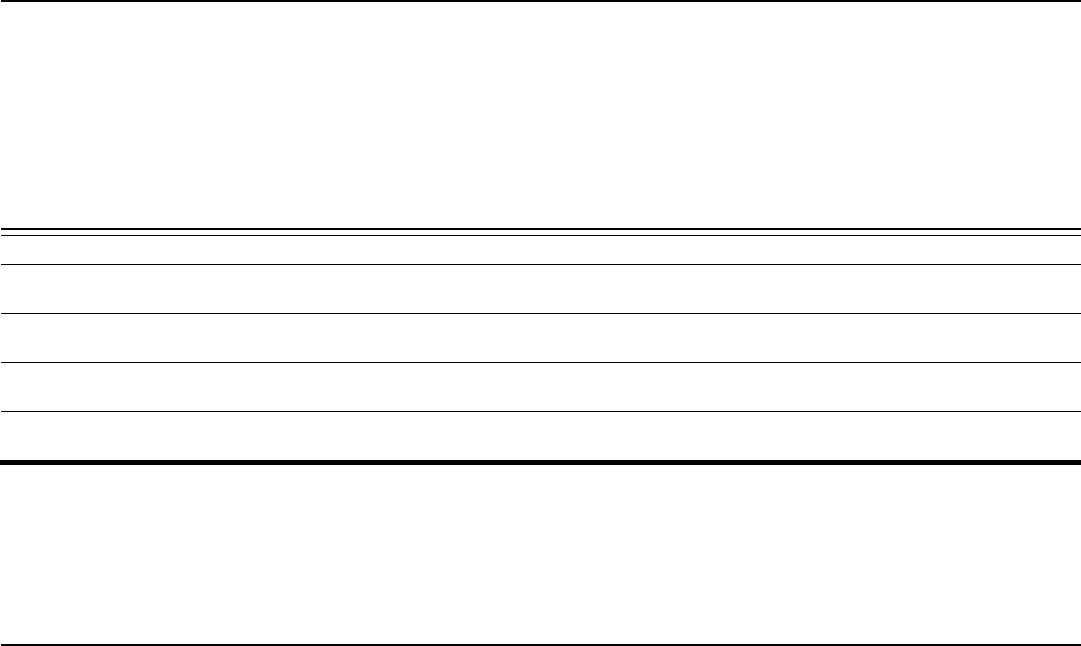
Page 9 GAO-22-104439 Defined Contribution Plans
Fee type
Description
Investment management
Managing investment fund assets (fees are generally stated as a percentage of the
amount of assets involved)
Marketing and distribution
a
Commissions to brokers and other salespersons, for expenses such as advertising
and other costs of promoting the fund to investors
Trading/transaction costs
Commissions and other fees associated with an investment manager’s buying and
selling of securities within a particular investment vehicle
Wrap fees
Aggregate fees that encompass multiple components, such as investment
management fees, surrender fees,
b
and administrative expense fees.
Source: GAO review of documentation. I GAO-22-104439
a
Also known as 12(b)(1) fees, named for the Securities and Exchange Commission rule that
authorizes a mutual fund to charge them. See 17 C.F.R. § 270.12b-1.
b
Surrender fees are fees for selling or withdrawing money from an investment before a set period of
time has passed. Surrender fees are often phased out over a period of years, and vary by specific
investment options, but generally involve a reduction of 1 to 2 percent per year until the surrender fee
is no longer charged. For example, an annuity with a 10-year, 10 percent surrender fee would charge
10 percent the first year to move money out of the annuity, 9 percent the second year, and so on,
until there is no surrender fee after the 10-year period.
Most private sector employer-sponsored retirement plans are subject to
ERISA requirements intended to protect the interests of plan participants.
Specifically, among other things,
• plan fiduciaries are required to discharge their duties solely in the
interest of participants and beneficiaries for the exclusive purpose of
providing benefits and defraying reasonable expenses of plan
administration and with the care, skill, prudence, and diligence under
the circumstances then prevailing of a prudent person acting in a like
capacity and familiar with such matters;
• plan fiduciaries are generally prohibited from entering into certain
transactions with the plan, such as by dealing with plan assets in the
fiduciary’s own interest;
• plan administrators are required to provide participants with a
summary plan description outlining their benefits, rights, and
responsibilities under the plan, and notify participants of any material
changes; and
• plan administrators are required to file annual reports including the
Form 5500 and applicable schedules and attachments that collect
information on particular plan aspects. This includes information on
plan investments, fees paid to service providers, the plan’s financial
condition, annual participant contributions, and the number of
participants.
DOL’s Employee Benefits Security Administration’s (EBSA) role includes
overseeing the administration of 403(b) retirement plans and the fiduciary
Regulation and Oversight
of 403(b) Plans
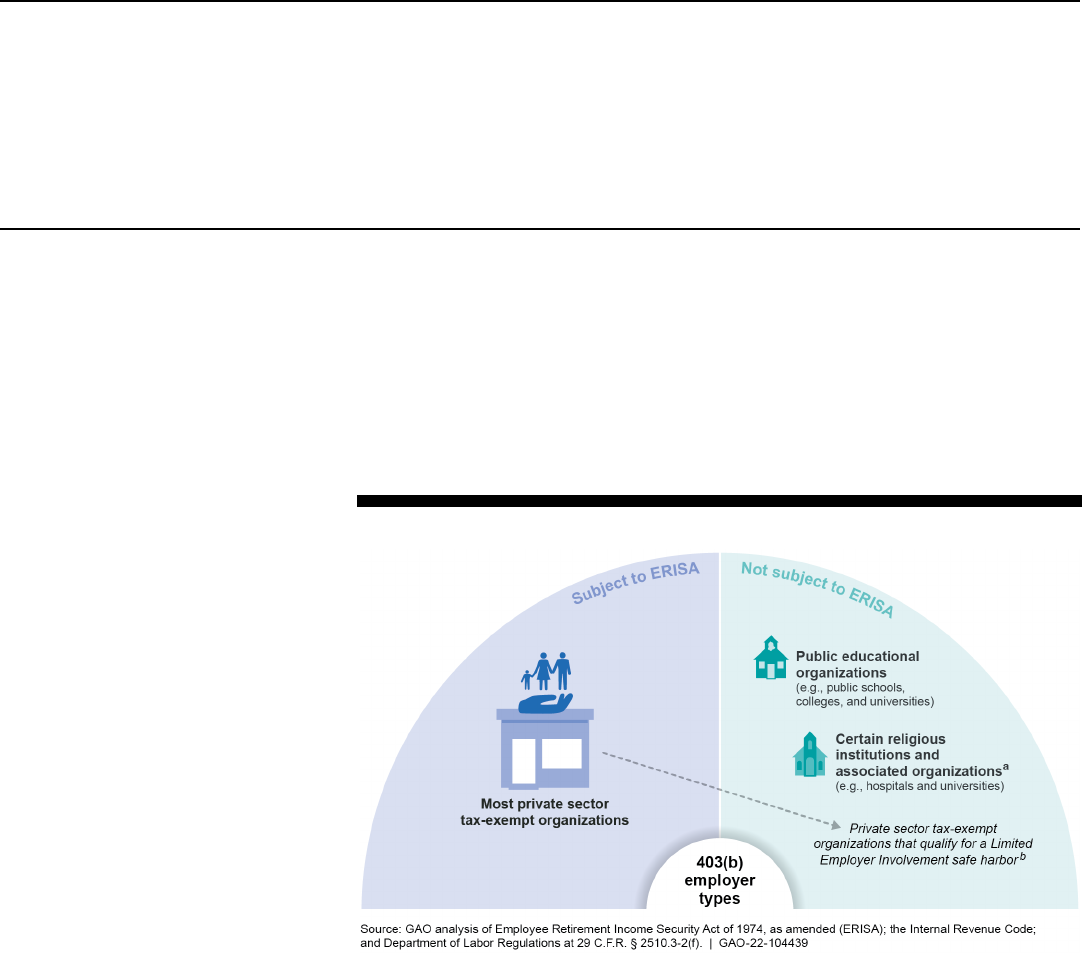
Page 10 GAO-22-104439 Defined Contribution Plans
protections of such plans subject to ERISA. EBSA’s mission is ensuring
the security of retirement, health, and other workplace-related benefits of
American workers and their families.
Not all 403(b) plans are subject to ERISA. The type of employer and, in
certain cases, the extent to which the employer is involved in the plan can
determine whether the plan is subject to ERISA. For example, plans
sponsored by public schools are generally exempt from ERISA, as shown
in figure 1.
Figure 1: The Type of Employer and Extent of the Employer’s Involvement in the
Plan Can Determine Whether a 403(b) Plan Is Subject to ERISA
a
Retirement plans offered by religious organizations are referred to as church plans. Church plans are
plans that (1) have as their principal purpose or function the administration or funding of retirement or
welfare benefits for employees of a church or convention or association of churches and (2) are
controlled by or associated with a church or convention or association of churches. See 29 U.S.C.
§ 1002(33)(A)-(C).
b
In certain circumstances, a 403(b) plan that meets certain criteria may qualify for a safe harbor
exemption and as such not be subject to ERISA. In order to fall under what we will refer to in this
report as the “Limited Employer Involvement” safe harbor, employer involvement in the plan must be
limited. See 29 C.F.R. § 2510.3-2(f); see also Department of Labor (DOL) Field Assistance Bulletin
2007-02 (July 24, 2007).
More specifically, in certain circumstances, a 403(b) plan that meets
certain criteria may qualify for a safe harbor exemption and as such not
be subject to ERISA. In order to fall under what we refer to in this report
as the “Limited Employer Involvement safe harbor,” employer involvement

Page 11 GAO-22-104439 Defined Contribution Plans
in the plan must be limited as described in DOL regulations.
21
For
example, to qualify for the safe harbor, employers are not allowed to
contribute to the plan or make discretionary determinations in
administering the plan, such as processing distributions, authorizing plan-
to-plan transfers, or making determinations of eligibility for loans or
hardship distributions; and participant involvement in the plan must be
voluntary (i.e., participants elect to participate in the plan, instead of being
automatically enrolled by the employer).
In addition to DOL’s EBSA, a number of federal and state agencies have
a role in regulating and overseeing 403(b) plans or investment options
provided to participants. Specifically:
• Internal Revenue Service (IRS) administers the Internal Revenue
Code (IRC), including provisions related to 403(b) retirement plans.
Among its responsibilities, IRS ensures that taxpayers comply with the
tax law and develops monitoring mechanisms to enforce retirement
plans’ compliance with IRC requirements for tax qualification.
• The Securities and Exchange Commission administers and enforces
federal securities laws and regulations that govern the sales and
marketing of variable annuities, mutual funds, and certain other
investment products in part through Regulation Best Interest.
22
This
regulation establishes a standard of conduct for brokers or dealers
who provide recommendations regarding securities, investment
strategies for securities, and other investment products used to fund
403(b) plans.
• State Insurance Commissioners administer and enforce state
regulations regarding fixed, variable, and indexed annuities that may
be offered in 403(b) plans. In addition, State Insurance
Commissioners may be in charge of administering and enforcing
individual state laws for 403(b) plans sponsored by a state,
subdivision, or instrumentality thereof covering employees of public-
supported schools.
The Form 5500 and a series of supplemental forms known as “schedules”
are the primary source for the federal government to collect information
regarding most private sector employer-sponsored retirement plans, and
21
See 29 C.F.R. § 2510.3-2(f); see also Department of Labor Field Assistance Bulletin
2007-02 (July 24, 2007).
22
17 C.F.R. § 240.15l-1.
Reporting Requirements
for ERISA 403(b) Plans

Page 12 GAO-22-104439 Defined Contribution Plans
were jointly developed by DOL, IRS, and the Pension Benefit Guaranty
Corporation.
23
The Form 5500 collects information from each retirement
plan on the number of plan participants, assets held and benefits paid by
the plan, and administrative fees paid by the plan, among other things.
The Form 5500 is part of ERISA’s overall reporting and disclosure
framework, which is intended to ensure that retirement plans, including
those 403(b) plans subject to ERISA, are operated and managed
according to certain prescribed standards and that participants,
beneficiaries, and federal agencies are provided or have access to
sufficient information to protect the rights and benefits of participants and
beneficiaries. EBSA uses the Form 5500 to monitor and enforce the
requirements of title I of ERISA. IRS uses the form to monitor and enforce
standards of compliance with the tax code, which relate to, among other
things, how employees become eligible to participate in benefit plans, and
how they become eligible to earn rights to benefits.
All 403(b) plans that are subject to ERISA are required to file a Form
5500. Plans with 100 or more participants at the start of a calendar year
are generally required to file a Form 5500, and have their financial
statements audited by an independent qualified public accountant and
submitted to DOL when filing Form 5500. Plans with fewer than 100
participants may generally file a shorter form called the Form 5500-SF
and are generally exempt from the independent qualified public
accountant audit requirement.
Form 5500 Data Do Not Represent All 403(b) Plans
Form 5500 data do not represent all 403(b) plans because not all plans are subject to
the Employee Retirement Income Security Act of 1974, as amended (ERISA), including
its reporting requirements. ERISA does not cover governmental plans, certain church
plans, and 403(b) annuities and custodial accounts that meet the conditions of the safe
harbor under 29 CFR 2510.3-2(f), which is based on limited employer involvement.
Source: GAO analysis of 29 C.F.R. 2510.3-2(f). l GAO-22-104439
DOL and other federal agencies collect information on fees in several
different supplemental schedules attached to Form 5500 for retirement
plans covered by ERISA, including 403(b) plans. These include Schedule
C, in which sponsors of large retirement plans (including 403(b) plans)
are required to disclose both direct and indirect compensation paid to
service providers in connection with their services to the plan that
23
The Pension Benefit Guaranty Corporation serves as trustee for certain terminated
pension plans that are underfunded and unable to pay guaranteed benefits.

Page 13 GAO-22-104439 Defined Contribution Plans
exceeds a $5,000 threshold; and include Schedule H, in which sponsors
provide financial information, including a series of line items for
administrative expenses paid directly by the plan to service providers.
Total assets in both ERISA and non-ERISA plans increased from 2010 to
2020, and the majority of participants were in the education and health
care sectors, as described below.
Assets in plan. The amount of assets held by participants in 403(b)
plans has grown considerably since 2010, according to available data.
Data from the Investment Company Institute (ICI) quarterly reports shows
total (ERISA and non-ERISA) 403(b) plan assets grew from $851 billion in
2010 to more than $1.1 trillion in 2020, driven by an increase in ERISA
plans.
24
According to our analysis of available data, the ERISA plan share
of total assets increased from 37 percent to 57 percent from 2010 to
2019.
25
According to our analysis of DOL’s Form 5500 data, the value of
ERISA 403(b) plan assets increased from $313 billion in 2010 to $617
billion in 2019, the most recent year for which these data are available.
26
Although no comprehensive data exist on non-ERISA 403(b) plans, which
are not subject to federal reporting requirements, using ICI total 403(b)
24
We applied an inflation adjustment to present ICI’s nominal dollar estimates in 2019 real
dollars. See Investment Company Institute, The U.S. Retirement Market, Third Quarter
2021.
25
These data represent our analysis of ICI’s estimates of the total (ERISA and non-
ERISA) 403(b) market as detailed in its quarterly retirement total market reports, and our
analysis of Form 5500 data, and calculating the annual ERISA percentage of assets.
26
All analyses of Form 5500 data are presented in 2019 adjusted dollars.
Available Data Show
That Total 403(b) Plan
Assets Have
Increased since 2010
and Other
Characteristics, such
as Plan Participation,
Varied Among Plans
Total 403(b) Plan Assets
Increased from 2010 to
2020, Driven by an
Increase in ERISA Plan
Assets, Which Are
Concentrated in the
Education and Health
Care Sectors

Page 14 GAO-22-104439 Defined Contribution Plans
plan asset estimates and GAO’s analysis of ERISA plan assets, we
estimated that the amount of non-ERISA plan assets decreased from
$538 billion in 2010 to $469 billion in 2019.
27
This represented a decrease
in the share of non-ERISA assets from 63 percent to 43 percent during
the time period.
Sector. Participants in ERISA 403(b) plans were concentrated in the
education or health care sectors, but the number of plans was similar
across sectors. Specifically, our analysis of Form 5500 data found that 56
percent of ERISA plan participants were in health care and another 27
percent of participants were in education in 2019.
28
On a plan basis, our
analysis of DOL’s Form 5500 data for 2019 found a fairly even distribution
across the number of ERISA plans in the education, health care, social
assistance, and religious sectors.
Number of plans. The number of ERISA 403(b) plans has declined since
2010, while the trend in the number of non-ERISA plans is unknown.
According to our analysis of DOL’s Form 5500 data, the number of ERISA
403(b) plans declined from 21,900 in 2010 to 20,900 in 2019, a decrease
of 5 percent.
29
Experts from a large nonpartisan retirement research
entity, as well as a retirement plan sponsor association, told us that the
health care sector has seen significant merger and acquisition activity,
which may, in part, be driving the decline in the number of ERISA plans,
given that many ERISA 403(b) plans are health care-related companies
and hospitals. Similarly, our analysis of Form 5500 data found that the
health care sector experienced the largest decline in the number of
27
Non-ERISA asset estimates are based on ICI’s estimates of annual (ERISA and non-
ERISA) total 403(b) market assets, less our ERISA asset values as determined through
our analysis of Form 5500 data. We applied an inflation adjustment to ICI’s nominal dollar
estimates to present in 2019 real dollars.
28
Plan sponsors report the North American Industry Classification System (NAICS) code
corresponding to their principal business activity on the form 5500. We categorized as
follows: educational services including schools, colleges, & universities, business code
611000; health care, business codes from 621111 to 623000; social assistance, business
codes from 624100 to 624410; religious and similar (includes religions, grant making,
civic, professional, and similar organizations), business code 8130000; all other – all other
NAICS codes. In addition, our analysis of HRS data—which covers ERISA and non-
ERISA 403(b) plans—found similar results, and also found that a higher percentage of
403(b) participants were employed in the education or healthcare and social assistance
sectors, compared to 401(k) retirement account holders. See appendix II for detailed
results of our HRS analysis.
29
BrightScope/ICI’s annual reports on 403(b)s published from 2016 to 2021 and covering
2012 to 2017 show a similar trend in terms of decreasing number of ERISA plans from
2012 to 2017, and increasing number of participants and plan assets.

Page 15 GAO-22-104439 Defined Contribution Plans
ERISA 403(b) plans, with a 10.4 percent decrease from 2010 to 2019,
and had the largest increase in inflation-adjusted total 403(b) assets, an
increase of 140 percent between 2010 and 2019. Figure 2 shows the
decline in number of plans, by sector, and the increase in plan assets, by
sector.
Figure 2: Number of 403(b) ERISA Plans and Value of ERISA Plans’ Assets, by Sector, 2010-2019
Note: ERISA refers to the Employee Retirement Income Security Act of 1974, as amended. Plan
sponsors report the North American Industry Classification System (NAICS) code corresponding to
their principal business activity on the form 5500. We categorized as follows: education, including
schools, colleges, and universities, business code 611000; health care, business codes from 621111
to 623000; social service, business codes from 624100 to 624410; religious and similar (includes
religions, grant making, civic, professional, and similar organizations), business code 8130000; other–
all other NAICS codes.
Information on the total number of non-ERISA plans, which may be
sponsored by states, localities, school districts, or religious organizations,
among others, was not available. At the state-level, an industry group
reported that, as of August 2020, 16 states sponsored non-ERISA 403(b)
state-wide plans for certain public school workers. However, three states
from this list told us they had discontinued their state-sponsored 403(b)
plans.
Number of participants. Although the number of 403(b) ERISA plans
decreased from 2010 to 2019, our analysis of Form 5500 data found that
the number of participants in these plans grew from about 7.1 million to

Page 16 GAO-22-104439 Defined Contribution Plans
9.9 million over the same time period, an increase of 39 percent.
30
In
addition, our analysis of data from the Health and Retirement Study
(HRS), a nationally representative survey of respondents who are over
age 50, indicates that the number of individuals who reported having an
ERISA or non-ERISA 403(b) retirement account was statistically
unchanged between 2010 and 2016, the most recent year for which
complete data are available. Specifically, the estimated number of
individuals over age 50 who reported they had a 403(b) account was 1.9
million in 2010 and 2.0 million in 2016. This change is not statistically
significant at the 95 percent confidence level.
31
No comprehensive data
exist regarding the number of non-ERISA 403(b) participants.
32
Coverage rate. Other available data indicate that the share of older
Americans who were employed and participating in 403(b) plans (both
ERISA and non-ERISA) was statistically unchanged between 2010 and
2016. Our analysis of HRS data shows that an estimated 4.3 percent of
Americans over age 50 reported having a 403(b) plan in 2010, and 3.9
percent had a 403(b) plan in 2016, although this change is not statistically
significant at the 95 percent confidence level.
33
By contrast, available data indicate 401(k) plans and participation have
increased across all measures. Our analysis of Form 5500 data shows
that the number of plans, number of participants, and plan assets for
401(k) plans all increased during this period. More specifically, the
number of 401(k) plans and participants increased by 17 percent and 27
percent, respectively.
34
In addition, the amount of 401(k) plan assets
30
As noted earlier, an expert told us there has been significant merger and acquisition
activity in the healthcare market, which may, in part, be the driver of the decline in the
number of ERISA plan, given that many ERISA 403(b) plans are healthcare related
companies and hospitals. This may also account for the increase in the number of
participants in each plan.
31
The associated lower and upper bound confidence intervals with these estimates are +/-
290,000, and +/-360,000, respectively.
32
We reviewed the Current Population Survey and the Survey of Income and Program
Participation datasets but did not identify any data fields relating to 403(b) retirement
accounts.
33
The associated confidence intervals at the 95 percent level are +/-0.6 percent for 2010
and +/-0.6 percent for 2016 403(b) account participants.
34
Specifically, from 2010 to 2019 the number of 401(k) plans increased from 510,000 to
595,000 and the number of participants in such plans increased from 71 million to 90
million.

Page 17 GAO-22-104439 Defined Contribution Plans
increased by 72 percent.
35
However, our analysis of HRS data shows that
the share of Americans over age 50 with a 401(k) plan was statistically
unchanged between 2010 and 2016.
36
Specifically, the estimated percent
of individuals over age 50 with a 401(k) plan through their current job was
28.4 percent in 2010 and 30.0 percent in 2016, although this change was
not statistically significant at the 95 percent confidence level.
37
Demographic characteristics of 403(b) participants over age 50. Our
analysis of data indicate some differences in the demographic
characteristics of 403(b) and 401(k) participants over age 50.
38
Specifically, HRS data show that a greater estimated percentage of
403(b) participants—in either an ERISA or non-ERISA plan—were
female; were in the education or health care and social assistance
sectors; and had $300,000 or more in household assets, compared to
401(k) participants. In addition, a greater percentage of 403(b)
participants earned $50,000 or more annually. Some of our results did not
show statistically different results—for example, our estimates regarding
the extent to which 403(b) account holders are 65 years of age or older,
and by race. See appendix II for more detailed additional results of our
analyses of HRS data.
35
The amount of 401(k) plan assets increased from $3.6 trillion to $6.2 trillion from 2010 to
2019.
36
The HRS contains a data field to identify those respondents in its representative sample
of people in the United States who are 50 years of age or older that report having a 403(b)
retirement account. An analysis of HRS data yielded 279 403(b) plans identified by 270
HRS respondents for the 2016 wave, the most recent year for which complete data are
available. We selected 401(k) account holders as a comparison group here and elsewhere
in the report because, according to DOL data and reporting, 401(k) accounts comprise the
largest share of defined contribution retirement accounts on a plan basis.
37
The associated confidence intervals for these estimates at the 95 percent level are +/-
1.8 percent for 2010, and +/-1.7 percent for 2016 for 401(k) account participants.
38
The Form 5500 does not capture demographic information on ERISA 403(b) plan
participants, such as race, gender, income, and education. Our surveys of plan sponsors
and service providers were not designed to capture this information.

Page 18 GAO-22-104439 Defined Contribution Plans
Certain characteristics of ERISA and non-ERISA 403(b) plans varied; for
example, based on the results of our non-generalizable survey, non-
ERISA plans were more likely than ERISA plans to be supplemental to
other forms of retirement savings.
39
Primary versus supplemental plan status. The best available data
sources, while not directly comparable, seem to indicate that ERISA
403(b) plans tend to be the sole or primary plan offered by an employer,
while non-ERISA plans are mostly supplemental to another retirement
savings plan offered by an employer. According to HRS data—which do
not differentiate between ERISA and non-ERISA plans—an estimated 61
percent of individuals over age 50 with a 403(b) plan reported that the
403(b) plan was their only retirement plan, and another 13 percent
reported it was their primary plan. With respect to ERISA plans, our
analysis of Form 5500 data found that 93 percent of ERISA 403(b) plans
are the employer’s sole or primary retirement plan. By contrast, most (18
of 21) of the non-ERISA plan sponsors who responded to our survey said
that the 403(b) plan was a supplemental plan.
40
With respect to ERISA
plans, our analysis of Form 5500 data found that 93 percent of ERISA
403(b) plans are the employer’s sole or primary retirement plan.
41
By
contrast, most (18 of 21) of the non-ERISA plan sponsors who responded
39
Our analysis was based on available data, including the Form 5500, industry reports,
and our surveys of 403(b) plan sponsors. More information is available about ERISA
403(b) plans, which are subject to federal reporting requirements, than for non-ERISA
403(b) plans. We relied exclusively on the results of our surveys of non-ERISA plans to
provide some information regarding the non-ERISA 403(b) market; however, this
information must be considered non-generalizable due to the small numbers of
respondents to our survey. For the purposes of this report, we refer to 403(b) record
keepers, third-party administrators, vendors, and others who provide administrative
services to a plan as 403(b) service providers.
40
For the HRS analysis, we considered a plan to be primary if the respondent reported
having multiple defined contribution plan types and the 401(k) or 403(b) plan had the
largest reported balance. We considered a plan supplemental if the respondent did not
have the largest reported balance in that plan account among multiple defined contribution
plan types or if the respondent also reported a defined benefit plan (the defined benefit
plan was assumed to be primary).
41
For our analysis of Form 5500 data for ERISA plans, we considered a plan to be a
primary plan if there was no other defined benefit plan sponsored by employer and no
other defined contribution plan type (e.g. money purchase) that covered a larger group of
participants. We also analyzed Form 5500 data to determine the extent to which
employers made contributions to 403(b) and 401(k) plans, and found that 74 percent of
403(b) plan employers reported they made a contribution to participants’ accounts, while a
higher percentage of 401(k) plans (80 percent) reported they made contributions to
participants’ accounts.
Available Data Show That
Non-ERISA Plans Are
Often Supplemental to
Other Forms of Retirement
Savings and That Other
Characteristics, such as
Contribution Rates and
Participation, Vary among
403(b) Plans
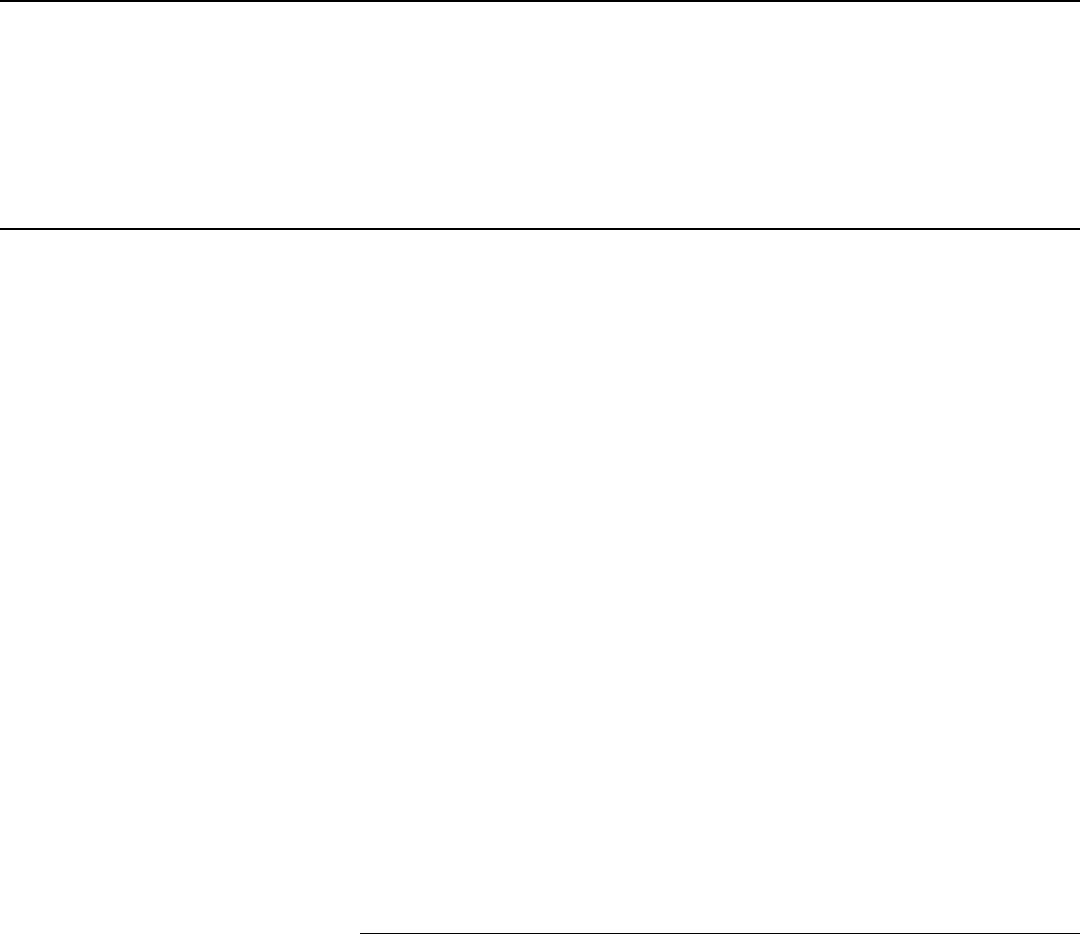
Page 19 GAO-22-104439 Defined Contribution Plans
to our survey said that the 403(b) plan was a supplemental plan, meaning
that it was not the retirement plan holding the greatest share of assets for
most participants.
42
Experts told us that many public plans—such as
those offered by a university or state—usually have a defined benefit plan
and the 403(b) plan is typically a supplemental plan. The National Tax-
Deferred Savings Association noted that supplemental savings in 403(b)
plans have become increasingly important with widespread reductions in
benefits of state retirement system plans.
43
Contribution rates. While no comprehensive data exist on contribution
rates—the percentage of earnings participants or employers contribute to
a 403(b) plan—available data seem to indicate 403(b) employers
contribute less than 403(b) plan participants to 403(b) accounts.
Specifically, industry survey data from 2021 indicates that 403(b) plan
sponsors in 2020 on average contributed 4.6 percent of annual payroll,
and 403(b) participants on average contributed 6.2 percent of annual
earnings; those numbers represent a decrease from, respectively, 6.3
percent and 7.2 percent from 2019.
44
In a separate report regarding K-12
school plan sponsors, the National Tax-Deferred Savings Association
(NTSA) estimated in 2018 that only 6 percent of these non-ERISA 403(b)
K-12 school plan sponsors offered matching contributions. According to
NTSA, contribution rates in 403(b) plans are lower than rates in 401(k)
plans, in part, because many of these plans are supplemental to other
forms of retirement savings and very few employers offer matching
42
For our surveys, by primary, we mean that the respondent’s 403(b) plan had the largest
balance of all the respondent’s two or more reported defined contribution plans and there
was no defined benefit plan. By supplemental, we mean that the 403(b) or 401(k) plan
does not have the largest reported balance of multiple defined contribution plan types or if
the respondent also reported a defined benefit plan (e.g., the defined benefit plan is
assumed to be primary).
43
See National Tax-Deferred Savings Association, Improving Retirement Savings for
America’s Public Educators: A Comprehensive Survey of Public Education 403(b)
Retirement Plans (2018).
44
Tax-exempt associations, foundations and universities had the highest average
employer contribution rates as a percentage of gross annual payroll at 8.8 percent and 7
percent, respectively. The “research, science, and environmental organizations” and
“associations/foundations” sectors had the highest average participant elective deferral
contribution rates at 9.1 percent and 8.3 percent, respectively. This survey was of both
ERISA and non-ERISA plan sponsors. For more information, see Plan Sponsor Council of
America, 2021 403(b) Survey, Reflecting 2020 Plan Experience (2021) and 2020 403(b)
Survey, Reflecting 2019 Plan Experience (2020).

Page 20 GAO-22-104439 Defined Contribution Plans
contributions.
45
NTSA’s report also found that contribution rates in these
non-ERISA 403(b) K-12 school plans nationally roughly averaged 6.9
percent of the average teacher’s salary of about $56,000.
We also analyzed HRS data from 2016 to determine the extent to which
employers and employees made contributions to 403(b) or 401(k)
accounts. The text box below describes the extent to which employers or
participants made contributions to 403(b) accounts, compared to 401(k)
accounts, in 2016.
Extent to Which Employers or Employees Opted to Not Contribute to Their 403(b) or 401(k) Accounts
We found that a higher percentage of individuals over age 50 who had a 403(b) account reported there was no
employer contribution to their 403(b) account, compared to individuals over age 50 who reported they had a 401(k)
retirement account. There was no statistically significant difference in the percentage of 403(b) and 401(k) participants
over age 50 who reported they made no employee contribution. Our results are shown in the figure below.
Source: GAO analysis of Health and Retirement Study data l GAO-22-104439
Note: Results are generalizable to individuals over age 50 in the United States. With respect to
employer contribution, the estimated percentages and associated margins of error at the 95 percent
confidence level are as follows: 403(b) no employer contribution, 42.5 percent, +/-10.9 percent;
401(k) no employer contribution, 22.7 percent, +/-3.2 percent. With respect to employee contribution,
the estimated percentages and associated margins of error at the 95 percent confidence level are as
follows: 403(b) no employee contribution, 13.5 percent, +/-6.4 percent; 401(k) no employee
contribution, 10.8 percent, +/-1.8 percent. 2016 is the most recent year for which complete weighted
Health and Retirement Study data are available.
a
The estimated difference for no employee contribution was not statistically significant at the 95
percent confidence level.
45
In its report, NTSA stated 403(b) savings rates are generally lower than 401(k) savings
rates because: (1) in the corporate market, 401(k) plans are the primary retirement
savings plan and usually with no accompanying defined benefit savings program; (2) few
school districts match participant contributions whereas about half of corporate 401(k)
plans have such a match; (3) very few school districts auto-enroll employees into 403(b)
programs; and (4) two-thirds (66 percent) of school districts also offer employees a 457(b)
savings plan alternative. (A 457(b) plan is a tax-advantaged, compensation-deferred
savings plan similar in nature to a 401(k) plan, except they are mainly for state and local
public workers, together with highly paid executives at certain tax-exempt organizations.)
See NTSA, Improving Retirement Savings for America’s Public Educators: A
Comprehensive Survey of Public Education 403(b) Retirement Plans (2018).

Page 21 GAO-22-104439 Defined Contribution Plans
In addition, our plan survey results indicate that non-ERISA 403(b) plans
included an employer contribution to the plan less frequently than ERISA
403(b) plans. More specifically, our survey results show the following:
• Employer basic or minimum contribution: Three of five ERISA plans
provided a minimum contribution to a participant’s account, compared
to four of 21 non-ERISA plans.
• ERISA plans’ employer matching contribution: Four of five ERISA
plans matched a percentage of a participant’s contributions to an
account, compared to four of 21 non-ERISA plans.
Participation rates. Participation rates in 403(b) plans have steadily
increased over time, according to one industry survey, and plan sponsors
that responded to our survey reported wide ranges in plan participation
rates. Specifically:
• A 2021 study of 403(b) plan sponsors reported that, among those
who were eligible, the percentage of employees with a 403(b)
account balance increased from 77.4 percent in 2012 to 82.6
percent in 2020. The percentage of employees that contributed to
the plan increased from 66.2 to 77.2 percent during the same time
period.
46
• An industry study of public school employees found a wide range
of participation rates within plans offered by school districts. The
study found that the participation rates for the 4,473 school
districts in the survey ranged from less than 7.6 percent to more
than 99 percent. The study noted that the choices that each
school district makes available to employees and the resources
that they provide to help employees understand the benefits of
participation are key differences in driving participation rates.
47
• Respondents to our plan sponsor survey reported a wide range in
employee participation, from 2.5 percent to 100 percent. About
half of survey respondents (11 of 21) reported a participation rate
46
See Plan Sponsor Council of America, 2021 403(b) Survey, Reflecting 2020 Plan
Experience.
47
See National Tax-Deferred Savings Association, Improving Retirement Savings for
America’s Public Educators: A Comprehensive Survey of Public Education 403(b)
Retirement Plans (2018).
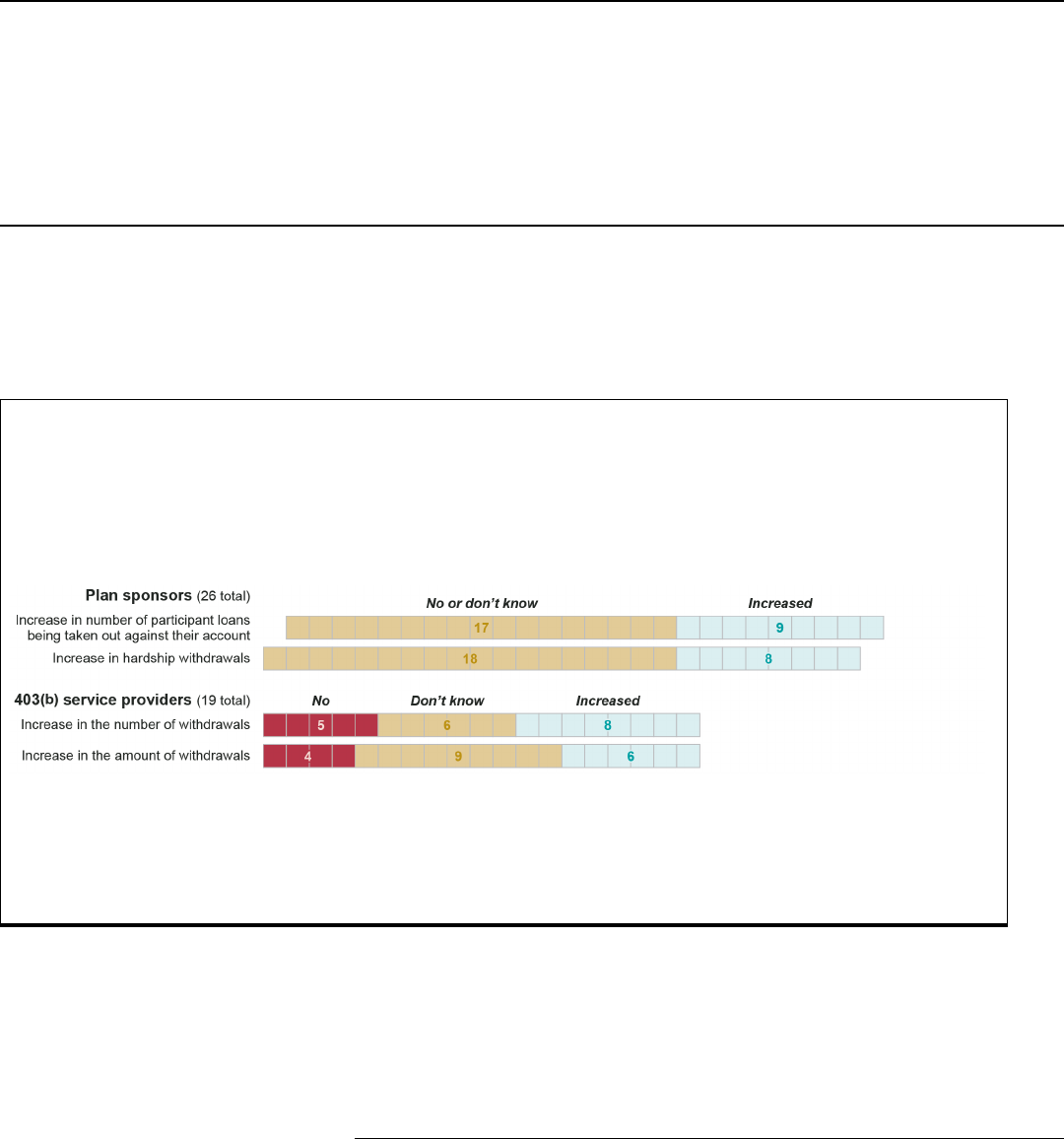
Page 22 GAO-22-104439 Defined Contribution Plans
of 50 percent or higher.
48
This participation rate for those plan
sponsors that responded to our survey did not appear to vary by
plan size, as measured by the number of participants.
49
Our survey results also identified some impacts due to the COVID-19
pandemic on 403(b) participant activities, as noted in the text box.
Impact of the COVID-19 Pandemic on 403(b) Participant Activity
Our survey data of ERISA and non-ERISA 403(b) plan sponsors found some reported an increase in participant loans and
hardship withdrawals due to the COVID-19 pandemic, while most reported there was no increase or they did not know. Our
plan sponsor survey asked plan sponsors to identify observed effects due to the pandemic by checking yes on a certain
option. Alternatively, respondents could check “do not know” to all options. As such, we are not able to discern the extent to
which plan sponsors would report “no” to a certain potential effect. Our survey of service providers found that eight of 19
service providers reported an increase in the number of withdrawals due to the pandemic, while five of 19 reported no such
increase, as shown in the graphic below
In addition, six service providers reported an increase in the amount of withdrawals, while four service providers reported no
such increase. Some plan sponsors reported that 403(b) plan participation rates or contributions decreased (in both cases,
four of 26); a few service providers also reported decreases in participation rates (three of 19). Respondents to our surveys
reported minimal other potential impacts of the pandemic on 403(b) participant activity. For example, two plan sponsors
reported decreases in participation due to layoffs, while four service providers reported decreases in employers’ matching
contributions. Seven service providers reported no such decrease in employer matching programs, and eight reported they did
not know. We did not ask service providers about plan sponsors’ reported participation impacts due to layoffs.
Source: GAO analysis of GAO survey results. l GAO-22-104439
Note: Our plan sponsor survey asked plan sponsors to identify observed effects due to the pandemic
by checking yes on a certain option. Alternatively, respondents could check “do not know” to all
options. As such, we are not able to discern the extent to which plan sponsors would report “no” to a
certain potential effect or “do not know” for all potential effects. We refer to all record keepers, third-
party administrators, vendors, and others who provide administrative services to a plan as 403(b)
service providers.
48
We excluded five survey respondents who provided participation data that did not allow
us to calculate a participation rate.
49
More specifically, the six smallest plans, with 2,000 or fewer participants, reported a
similarly large range of participation from 2.5 to 100 percent, and the six largest plans in
terms of participants—those with more than 20,000 participants each—reported a large
range of participation, from 9.9 to 78 percent. We note that one plan had a lower reported
participation rate of 0.13 percent; however, that plan is a recently discontinued state
sponsored plan, so we chose to not report that result as the lowest.

Page 23 GAO-22-104439 Defined Contribution Plans
Number of participants within plan. The majority of ERISA 403(b)
plans are small plans with 99 or fewer participants. Specifically, our
analysis of Form 5500 data found that 63 percent of ERISA 403(b) plans
have 99 or fewer participants. This is a smaller share than for 401(k)
plans, as 88 percent of 401(k) plans have 99 or fewer participants. No
comprehensive data exist regarding plan size in terms of participants in
non-ERISA 403(b) plans, and accordingly we cannot quantify the
percentage of non-ERISA 403(b) plans that may have fewer than 99
participants. The non-ERISA plan sponsors who responded to our survey
reported a range of plan sizes measured as the number of participants
within the plan, from two to 315,000 participants.
50
Available data indicate that ERISA and non-ERISA 403(b) plans had a
larger number of investment options compared to 401(k) plans. According
to reports published by BrightScope and the Investment Company
Institute, the ERISA 403(b) plans in its sample had an average of 32
investment options in 2017, compared to an average of 21 investment
options for its sample of 401(k) plans.
51
A 2021 survey from the Plan
Sponsor Council of America, which surveyed both ERISA and non-ERISA
plans, found that 403(b) plans consistently averaged having between 23
and 31 investment options available to 403(b) plan participants between
2011 and 2020.
52
In comparison, the Plan Sponsor Council of America
2020 survey of 401(k) plans found that 401(k) plans consistently
50
These numbers may include some inactive participants who are no longer contributing
to the plan.
51
For the purposes of this analysis and our report, a suite of target-date funds is counted
as a single investment option. Target-date funds are pooled investment products that
invest in a mix of assets and shift from higher-risk to lower-risk investments as a
participant approaches their target retirement date. BrightScope/ICI relies, according to ICI
representatives, on a manual review of the attachments provided by a firm in its audited
Form 5500 submission since the Form 5500 data do not include information regarding the
number of investment options; we did not conduct a similar analysis of Form 5500 audited
files. BrightScope/ICI’s audited sample is generally of plans with 100 or more participants.
See BrightScope and Investment Company Institute, The BrightScope/ICI Defined
Contribution Plan Profile: A Close Look at ERISA 403(b) Plans, 2017 (Washington, D.C.:
January 2021) and The BrightScope/ICI Defined Contribution Plan Profile: A Close Look
at 401(k) Plans, 2017 (Washington, D.C.: August 2020).
52
The Plan Sponsor Council of America received responses from 379 non-profit (tax-
exempt) entities that sponsor a 403(b) plan. It is not generalizable. See Plan Sponsor
Council of America, 2021 403(b) Survey Report, Reflecting 2020 Plan Experience (2021).
403(b) Plans Generally
Have a Greater Number of
Investment Options than
Do 401(k) Plans, but
Some 403(b) Plan
Sponsors Reported They
Did Not Know the
Numbers and Details of
Investment Options
Offered by Their Plans
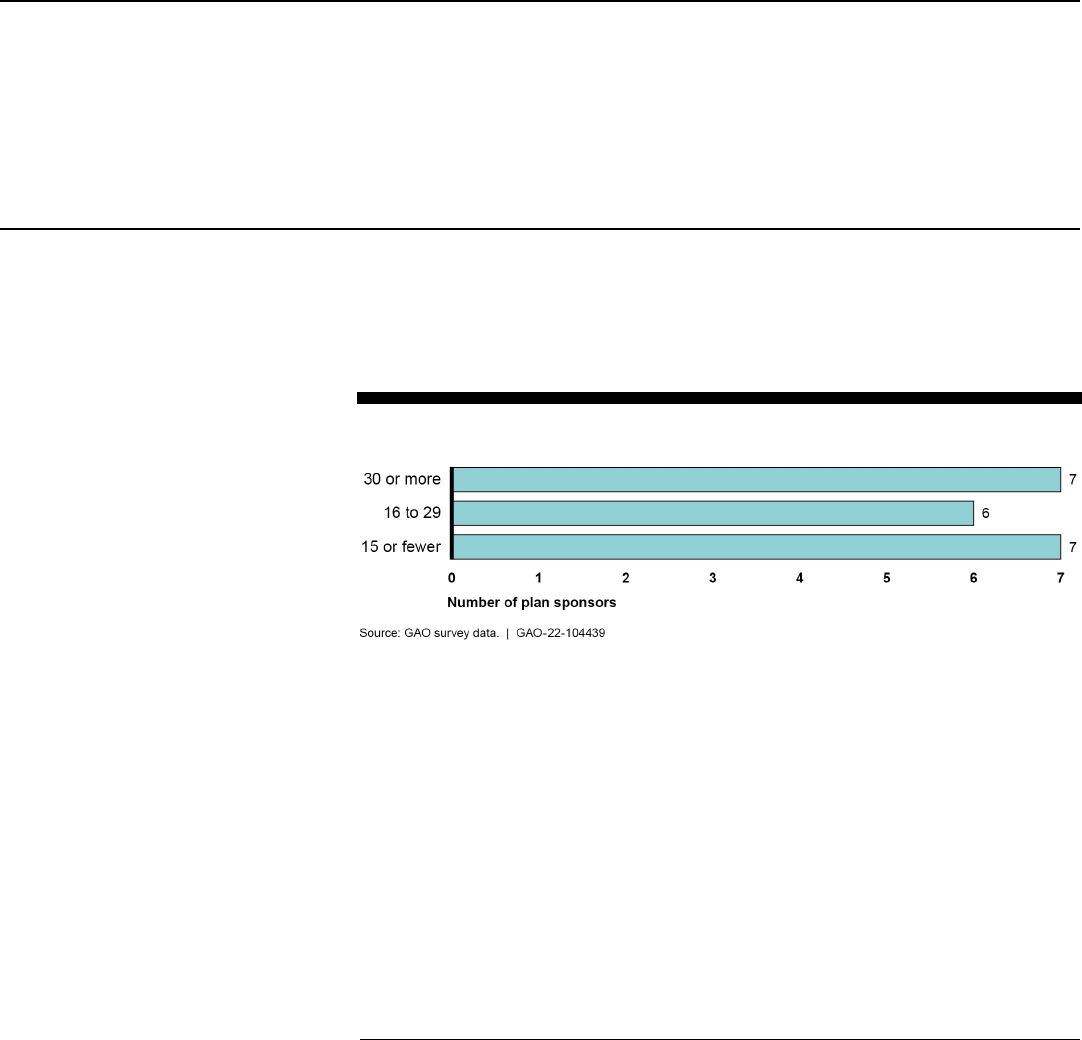
Page 24 GAO-22-104439 Defined Contribution Plans
averaged having between 18 and 20 investment options available to
401(k) participants.
53
Among the plan sponsors we surveyed, the number of investment options
they made available varied widely, as shown in figure 3.
Figure 3: Reported Number of Investment Options Offered by 403(b) Plan Sponsors
Surveyed by GAO
Some plan sponsors offer a large number of investment options. For
example, one respondent representing a large state university system
reported that its non-ERISA plan offers on average 42 investment options
to participants,
54
while one respondent of a smaller plan reported that its
ERISA plan currently offers 48 options. Our survey results, however, did
not indicate a strong correlation between plan size measured in terms of
assets held and the number of available investment options. Specifically,
the largest eight plan sponsors in terms of assets reported offering a
median of 30 investment options, while the smallest seven plans reported
offering a median of 28 investment options.
55
53
The time period for the number of investment options for 401(k) participants was from
2010 to 2019. See Plan Sponsor Council of America, 63rd Annual Survey, Reflecting 2019
Plan Experience (2020).
54
The plan sponsor reported that this number was an average across four platforms. The
sponsor noted that its program is based on annuities, so every participant has a direct
account with its four investment providers. As a result of this setup, the plan is unable to
map assets, and while it has worked to decrease the number of options available to new
participants to about 40, it is unable to close accounts that are invested in the legacy
options. As such, other information provided by the plan sponsor showed the total number
of investment options for the plan was 216.
55
One plan sponsor in the larger group and two plan sponsors in the smaller group did not
know how many investment options were offered in their 403(b) plans, and we therefore
excluded those plans in calculating the median.

Page 25 GAO-22-104439 Defined Contribution Plans
While some 403(b) plans have a large number of investment options,
several of the plan sponsors we surveyed reported significantly reducing
the number of investment options they offer over the last 10 years.
Specifically, eight of 17 plan sponsors who provided information on how
the number of investment options had changed over the last 10 years
reported that the number of investment options offered in their plans
decreased—including four who previously had hundreds of investment
options but had significantly reduced the number of options. The current
number of investment options for these plans ranged from 10 to 22.
Experts we interviewed noted that some plan sponsors had consolidated
the number of investment options to ensure better outcomes for
participants, including lower fees. For example, one official noted that his
state had consolidated the number of 403(b) investment options for state
educator and other government employees from over a dozen providers
with 1,600 investment options, to a single provider with 14 investment
options.
56
Five public school 403(b) plan sponsors who responded to our survey
reported they did not know the number of investment options their plans
offered, although we were able to identify and obtain this information
through public sources for three of these school districts. An expert told
us that local school districts often will not have certain information
regarding their plans’ investment offerings because they are effectively
delegating the plan administration to a third- party administrator. For
example, representatives from one large school district reported its
district, with about 15,000 participants as of August 2021, listed the
names and phone numbers of 27 providers of 403(b) investment options
on its website. Each provider may offer multiple investment options with
varying expense ratios, and it is unclear from the information how many
investment options the school district might offer. As another example, an
official at a school district with 21,000 participants in its 403(b) plan stated
in written communication to us, that it has a list of the vendors who offer
403(b) investment options in the school district, but the school district
does not have a list of the number of investments offered or the expense
ratios that are associated with the investment options. This situation also
applied to some small schools. For example, the plan administrator at one
small school district reported that in 2020 the district’s 403(b) plan had
two participants and was administered by a large third-party
56
The official noted the state was responsible for continuing to provide record keeping
services for investment options from the former 403(b) plans that are no longer offered;
however, 85 percent of participants had moved into investment options through the state-
sponsored plan.

Page 26 GAO-22-104439 Defined Contribution Plans
administrator, and also reported that she had not had contact with the
third-party administrator in years and did not know how to locate them or
how to determine any other information regarding the plan.
The majority of assets across 403(b) plans were in fixed or variable
annuities according to ICI quarterly reporting, but asset allocations varied
considerably among individual service providers and plans, according to
our survey respondents. At an aggregate level, according to ICI’s
quarterly reporting, at the end of 2020, 48 percent of total ERISA and
non-ERISA 403(b) assets were in life insurance products (excluding
mutual funds held inside variable annuities), 24 percent were in variable
annuity mutual funds,
57
and 28 percent were in non-variable annuity
mutual funds.
58
According to Form 5500 data from 2019, the majority of ERISA 403(b)
plan assets—$463 billion of $617 billion—were held by plans that
reported offering both annuity and mutual fund investment options.
Moreover, our analysis of Form 5500 data found that the amount of
assets held by ERISA 403(b) plans that exclusively offer annuity products
increased from $56 billion in 2010 to $74 billion in 2019, while the amount
of assets held by plans that exclusively offer mutual fund products
increased from $40 to $64 billion, as shown in figure 4.
57
According to ICI, the mutual fund component excludes assets attributable to the life
insurance wrapper as well as underlying variable annuity holdings which are not mutual
funds; both of those are in the life insurance category.
58
ICI produces a quarterly report, based on data collected from its members, the Board of
Governors of the Federal Reserve System, and the American Council of Life Insurers.
403(b) Plans’ Asset
Allocations to Annuities
and Mutual Funds Varied
by Plan, and Some Plan
Sponsors Reported They
Did Not Know Asset
Allocation of Their Plans

Page 27 GAO-22-104439 Defined Contribution Plans
Figure 4: Trends in ERISA 403(b) Plans Offering Annuities Only, Mutual Funds Only, or Both Annuities and Mutual Funds, by
Asset Value, 2010-2019
Note: ERISA refers to the Employee Retirement Income Security Act of 1974, as amended.
In comparison, non-generalizable industry surveys of plan sponsors
including ERISA and non-ERISA plans reported that the share of plans
allowing annuities as permitted investments has increased from about 45
percent in 2013 to about 54 percent in 2020, and the share allowing
mutual funds as permitted investments increased from about 76 percent
to about 95 percent during the time period.
59
Among our service provider survey respondents, who provide
administrative services to both ERISA and non-ERISA plans, fewer
reported that their 403(b) plan clients offer fixed annuities compared to
59
The non-generalizable survey reported that in 2013, the year for which these data are
first available, about 45 percent of 403(b) plans sponsors allowed participants to invest in
annuities, and about 76 percent allowed them to invest in mutual funds. Fifteen percent of
respondents in 2013, as noted in the 2014 report, stated that they were unsure what types
of investments were permitted for the plan. See Plan Sponsor Council of America, 2014
403(b) Plan Survey, Reflecting 2013 Plan Experience (2014), and Plan Sponsor Council
of America, 2021 403(b) Survey, Reflecting 2020 Plan Experience (2020).

Page 28 GAO-22-104439 Defined Contribution Plans
variable annuities or mutual funds. According to one expert we
interviewed, generally speaking, non-ERISA plans with multiple product
vendors, which include most public school districts, offer both annuities
and mutual funds. This expert said that ERISA 403(b) plans are more
likely to offer only mutual funds compared to non-ERISA 403(b) plans.
Service providers we surveyed also reported a wide range in the asset
allocation within plans. Specifically, a slight majority of service providers
reported that the plans to which they provided services offered both
annuities and mutual funds, as shown in table 2.
Table 2: Extent to Which Service Providers Surveyed by GAO Reported 403(b) Plan
Clients Offered Annuities and/or Mutual Funds
Plan investment offering
Number of providers servicing such plans
Fixed annuities
a
11 of 19
Variable annuities
13 of 19
Mutual funds
b
16 of 19
Both mutual funds and annuities
11 of 19
Source: GAO survey data. | GAO-22-104439
a
One service provider reported they did not know whether the plans for which they provided services
offered fixed annuities.
b
More specifically, of the 16 service providers reporting that the plans they provided services to
offered mutual funds, 14 reported the plans they provide services to offered institutional mutual funds,
which are mutual funds that are available to plans with certain asset thresholds and are generally not
available to the general public. In addition, of the 16 service providers reporting that the plans they
provided services to offered mutual funds, 14 service providers reported that the plans they provided
services to offered retail mutual funds, which are mutual funds that are available to the general public.
Twelve of the 16 service providers that reported plans they provide services to offer mutual funds
reported that the plans they provide services to offered both institutional and retail mutual funds.
In addition, 10 of 19 respondents reported that variable annuities and
mutual funds comprised 63 percent or more of the value of the assets
held.
60
Eight of the 11 service providers that reported that the plans they
service offer fixed annuities also reported the percentage of assets in
fixed annuities ranged from 1 to about 65 percent. Three of the service
providers reported that the plans they provide services to held a very
small share—3 percent or less—of plan assets in fixed annuities.
60
Eight service providers did not provide the percentage of assets held in variable
annuities or retail or institutional funds by the plans for which they provide services.

Page 29 GAO-22-104439 Defined Contribution Plans
However, eight of 21 non-ERISA plan sponsors among those we
surveyed reported not knowing the distribution of assets between fixed
annuities and variable annuities or mutual funds in the plans they
sponsor. For example, table 3 shows the number of public school district
plans who responded to our survey who did not know the share of plan
assets by investment type.
Table 3: Investment Offerings and Knowledge of 403(b) Asset Allocation Reported by the Eight Public School District Plans
That Responded to GAO’s Survey
Investment offering
Number of public school district plans that
reported offering investment type
Number of public school district plans that
reported they did not know percentage of
plan assets in this investment type
Fixed annuities
5
5
Variable annuities
5
5
Institutional mutual funds
4
3
Retail mutual funds
6
5
Source: GAO survey data. | GAO-22-104439
Note: Among our 26 403(b) plan sponsor survey respondents were eight public school districts,
including one 403(b) plan sponsor whose plan covers multiple school districts. One of these plan
sponsors did not know what types of investments were included in their 403(b) plan assets.
Institutional mutual funds are available to plans with certain asset thresholds and are generally not
available to the general public. Retail mutual funds are available to the public.
Among the 12 state or public university sponsors who responded to our
survey were 11 who reported that they offered institutional grade mutual
funds—mutual funds that are available to plans with certain asset
thresholds and are generally not available to the general public—as an
investment option.
61
Of those 11 plan sponsors, nine of them reported
that they knew the percentage of plan assets in that category. By
contrast, two of the 12 state or public university sponsors who responded
to our survey reported offering retail mutual funds, one of whom knew the
percentage of plan assets in that category.
61
One plan sponsor who we characterized as a public school district (and are therefore is
not included in these numbers) reported having higher education faculty and staff, in
addition to public school teachers, among its participants. We nonetheless characterized
the sponsor as a public school district since, as of 2020, teachers accounted for 62.3
percent of plan participants while higher education faculty and staff combined accounted
for 6.6 percent of plan participants.
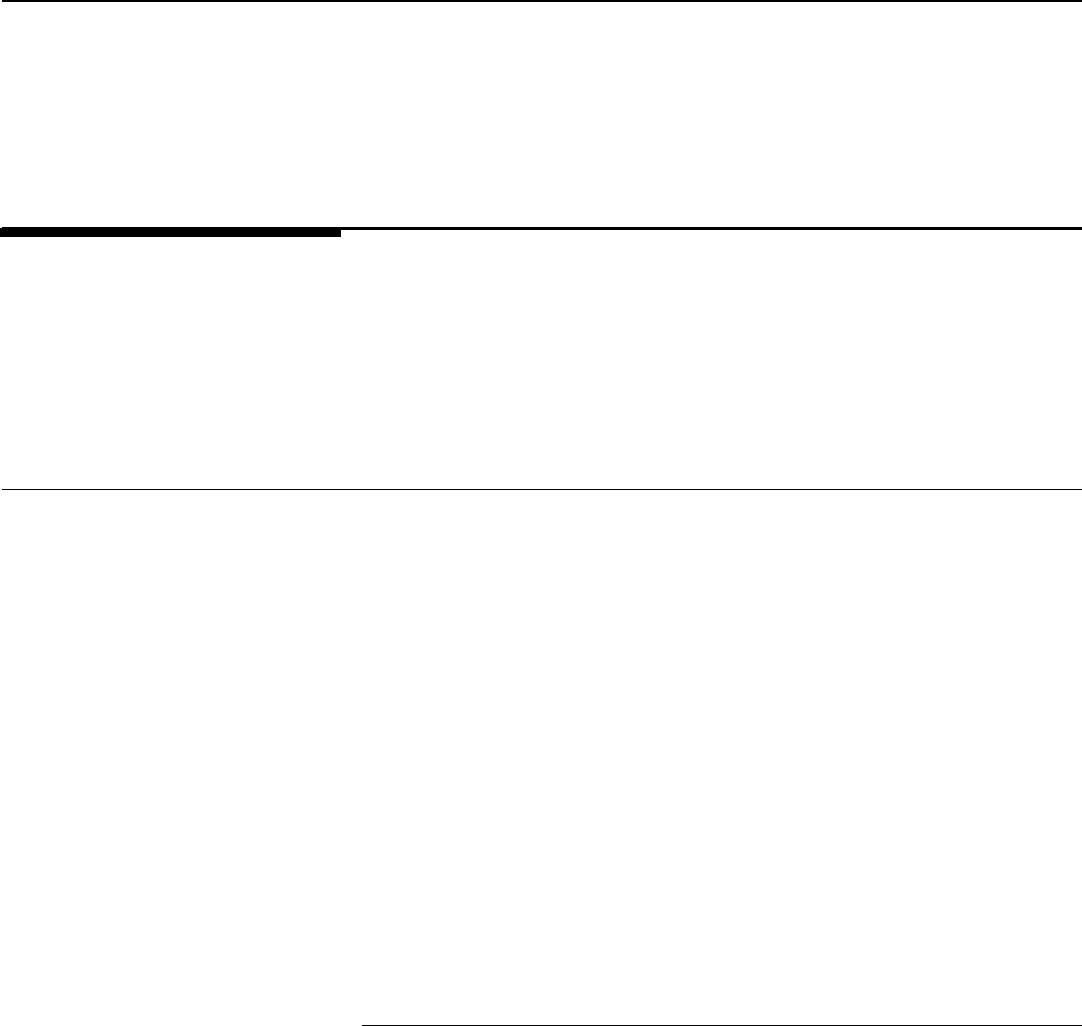
Page 30 GAO-22-104439 Defined Contribution Plans
Available data, including an industry study and our survey of ERISA and
non-ERISA 403(b) plan sponsors and service providers, indicate that fees
for 403(b) plans varied widely. For example, record keeping and
administrative fees ranged from less than 0.1 percent to more than 2
percent for the plan sponsors we surveyed.
According to BrightScope/ICI, in 2017—the most recent year for which
this analysis is available—ERISA 403(b) plans in their sample had an
average total plan cost of 0.81 percent of assets, but these costs varied
widely by plan.
62
For example, 10 percent of plans had a total plan cost of
0.45 percent or less of assets, while another 10 percent had a total plan
cost of 1.34 percent or more. We surveyed key populations of both
ERISA and non-ERISA 403(b) plan sponsors and service providers to
obtain additional information, and found that the types and amounts of
fees paid by plans varied widely, as discussed below.
Record keeping and administrative service fees. Plan sponsors
reported a wide range of fees paid for record keeping and administrative
services, such as tracking and reporting contributions. The 17 of 26 plan
62
BrightScope/ICI’s study examined 2017 plan fees based on audited information on 31
percent of ERISA 403(b) plans, covering about 87 percent of ERISA 403(b) plan
participants and 91 percent of ERISA 403(b) plan assets. In addition, it analyzed the
employer contribution structures for a randomly selected sample of 1,131 large ERISA
403(b) plans for plan year 2017. BrightScope/ICI’s audited sample is generally of plans
with 100 or more participants. Total plan cost includes asset-based investment
management fees, asset-based administrative and advice fees, and other fees (including
insurance charges) from the Form 5500 and audited financial statements of 403(b) plans
covered by ERISA. According to BrightScope/ICI, when plans use products registered
under the Investment Company Act of 1940—such as mutual funds—they use expense
ratio data from Lipper to calculate fees. See BrightScope, The BrightScope/ICI Defined
Contribution Plan Profile: A Close Look at ERISA 403(b) Plans, 2017 (January 2021).
While the BrightScope/ICI study examined data on ERISA 403(b) plans, similar
information on non-ERISA plans were not available.
Fees for 403(b) Plans
Varied Widely, and
Some Plans Reported
They Lacked
Knowledge of
Investment Fees
Available Data Show That
403(b) Plans Had a Wide
Range of Fees, and Some
Plan Sponsors Reported
They Did Not Know the
Expense Ratios for Their
Plans’ Investment Options

Page 31 GAO-22-104439 Defined Contribution Plans
sponsors that provided plan fee data in our survey reported record
keeping and administrative service fees ranging from 0.0008 percent of
plan assets to 2.01 percent of plan assets, with seven plan sponsors
reporting record keeping and administrative service fees above 0.1
percent.
63
These record keeping and administrative fees were the most
common type of fee reported by plan sponsors.
64
Another six of 26 plan
sponsors either reported they did not know their record keeping and
administrative or other plan-level fees, or did not report this information.
For complete information on plan sponsors’ survey responses regarding
record keeping and administrative fees, see table 5 appendix III.
Of 19 403(b) service providers—who generally provide services to both
ERISA and non-ERISA plans—10 reported record keeping and
administrative fees they charged to plans.
65
Consistent with plan
sponsors’ survey responses, these fees also varied widely, ranging from
0.03 to 1.26 percent of plan assets per year among those who reported
those fees in terms of percentages of plan assets.
66
Eight service
63
These 17 plan sponsor respondents included 14 out of 20 non-ERISA plans and three
out of five ERISA plans. In addition, one plan sponsor of a non-ERISA plan, a large school
district, did not report their administrative fees but reported information about other plan-
level fees. Of these 17 respondents, 14 reported an average number and three reported
their numbers in the form of a range. The highest reported number among those who
reported a range was 2.01 percent, while the lowest was 0 percent. For detailed
information, see appendix III.
64
DOL has stated that, when paid directly by the plan, administrative fees are either
allocated among participants’ individual accounts in proportion to each account balance
(i.e., participants with larger account balances pay more of the allocated expenses) or
passed through as a flat fee against each participant’s account.
65
Thirteen of 19 403(b) service providers indicated on our survey that they provide
services to both ERISA and non-ERISA plans, to varying degrees; respondents reported
between 1 percent and 89 percent of the 403(b) plans for which they provide record
keeping or administrative services were ERISA plans. Two other service providers
responded that they did not provide services to any ERISA 403(b) plans. Four others
responded that they did not know the extent to which their clients were ERISA or non-
ERISA plans. For detailed information, see appendix III. As noted earlier, some
administrative fees may be paid at the plan-level or may be included in the expense ratio
for each investment option. According to DOL officials, when plans report administrative
fees of zero it may be because there were no direct fees—only indirect fees—paid by the
plan. In addition, DOL officials said a plan may report total administrative fees of zero if
the employer or plan sponsor pays for plan-related fees out of their own pocket, rather
than charging the fees to the plan itself to be paid by participants.
66
Some respondents expressed their record keeping and administrative fees in flat dollar
or dollar per participant amounts rather than percentages.

Page 32 GAO-22-104439 Defined Contribution Plans
providers did not report this information.
67
For complete information on
service providers’ survey responses regarding record keeping and
administrative fees, see table 6 in appendix III.
Other plan-level fees. In addition to record keeping and administrative
fees, plan sponsors reported other plan-level service fees such as
retirement plan consultant and investment advisor fees, and legal and
audit fees, which also varied. For example, eight of our 21 non-ERISA
plan sponsors reported paying retirement plan consultants in amounts
ranging from 0.00108 percent to 0.43010 percent of plan assets per year.
Further, eight of our 21 non-ERISA plan sponsor survey respondents
reported paying legal or audit fees, ranging from 0.00035 percent to
0.34695 percent of plan assets.
68
For complete information regarding
what each of our plan sponsor survey respondents reported regarding
other plan-level fees, see table 5 in appendix III.
Expense Ratios
Individual investment options available to participants commonly express fees through an expense ratio, which are typically
the largest fees borne by a participant. An expense ratio measures how much of a fund’s assets are used for management,
administrative, and other operating expenses charged by the fund manager and incurred by the fund. An expense ratio is a
fund’s operating expenses divided by the average dollar value of its assets under management. Operating expenses reduce
the fund’s assets, thereby reducing the return to investors.
Source: GAO analysis of Securities and Exchange Commission and other public information. l GAO-22-104439
Expense ratios for investment options. Asset-based fees for
investment options—known as expense ratios—also varied widely
according to survey respondents and administrative data from a state that
maintains a registry of investment options available to 403(b)
participants.
69
Specifically, reported expense ratios from seven non-
ERISA plan sponsors that responded to this survey question ranged from
0.02 percent to 2.37 percent, as shown in figure 5.
67
One service provider expressed their fees in terms of a “wrap fee,” an aggregate fee that
encompasses multiple components, which can include administrative fees. This wrap fee
amount to 2.10 percent of plan assets per year.
68
See appendix III for detailed results from each plan sponsor and service provider.
69
The source of the administrative data was a survey respondent.
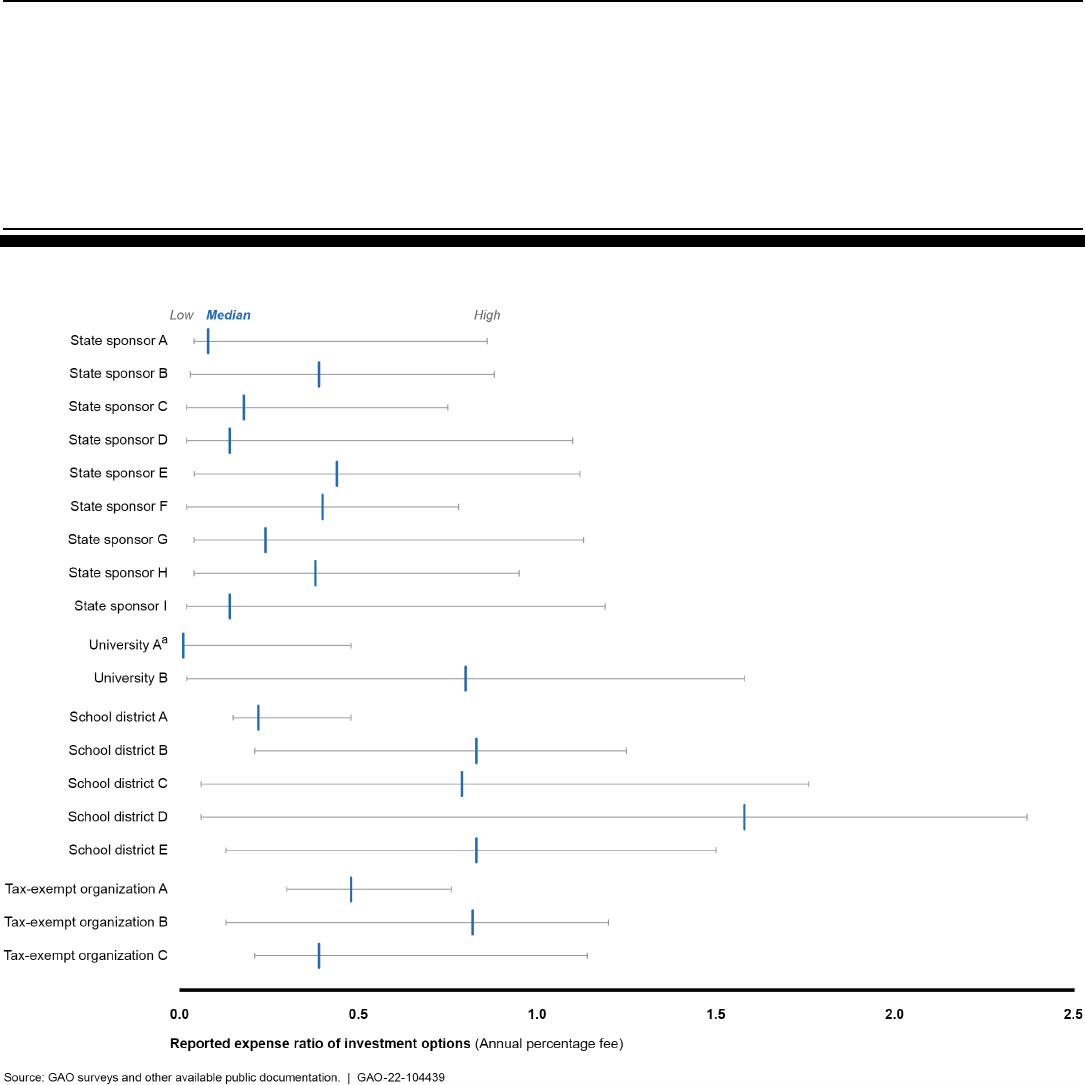
Page 33 GAO-22-104439 Defined Contribution Plans
Figure 5: Reported Ranges and Calculated Medians of Expense Ratios for Investment Options for Plan Sponsors Surveyed by
GAO
Note: Twenty-six plan sponsors responded to our survey. We omitted one plan sponsor with a
reported range of 0 to 1.93 percent because the zero referred to an annuity product that did not have
an expense ratio-based fee. None of the plan sponsors in the figure reported an investment option
with an expense ratio of zero. In addition, nine of 26 plan sponsors—including six public school
districts—reported in our survey they did not know the expense ratios for the investment options in
their plans, although we were able to find expense ratio information for three of the public school
districts through other public sources of information.
a
This plan sponsor reported a total of 10 investment option expense ratios. Six of those 10 investment
options had expense ratios of 0.01 percent, and two others between 0.01 and 0.04 percent.
Consequently, the median of these options ended up being 0.01 percent.

Page 34 GAO-22-104439 Defined Contribution Plans
In addition, administrative data from one state that maintains a public
registry of investment options available in its state, and which was also a
survey respondent, reported expense ratios from 403(b) plans purveyed
by vendors in its state ranged from 0.02 percent to 3.74 percent, with a
median of 0.90 percent, for the 6,064 mutual funds offered to 403(b)
participants in non-ERISA plans in the state. The text box below
demonstrates how higher fees can erode a participant’s savings over
time.
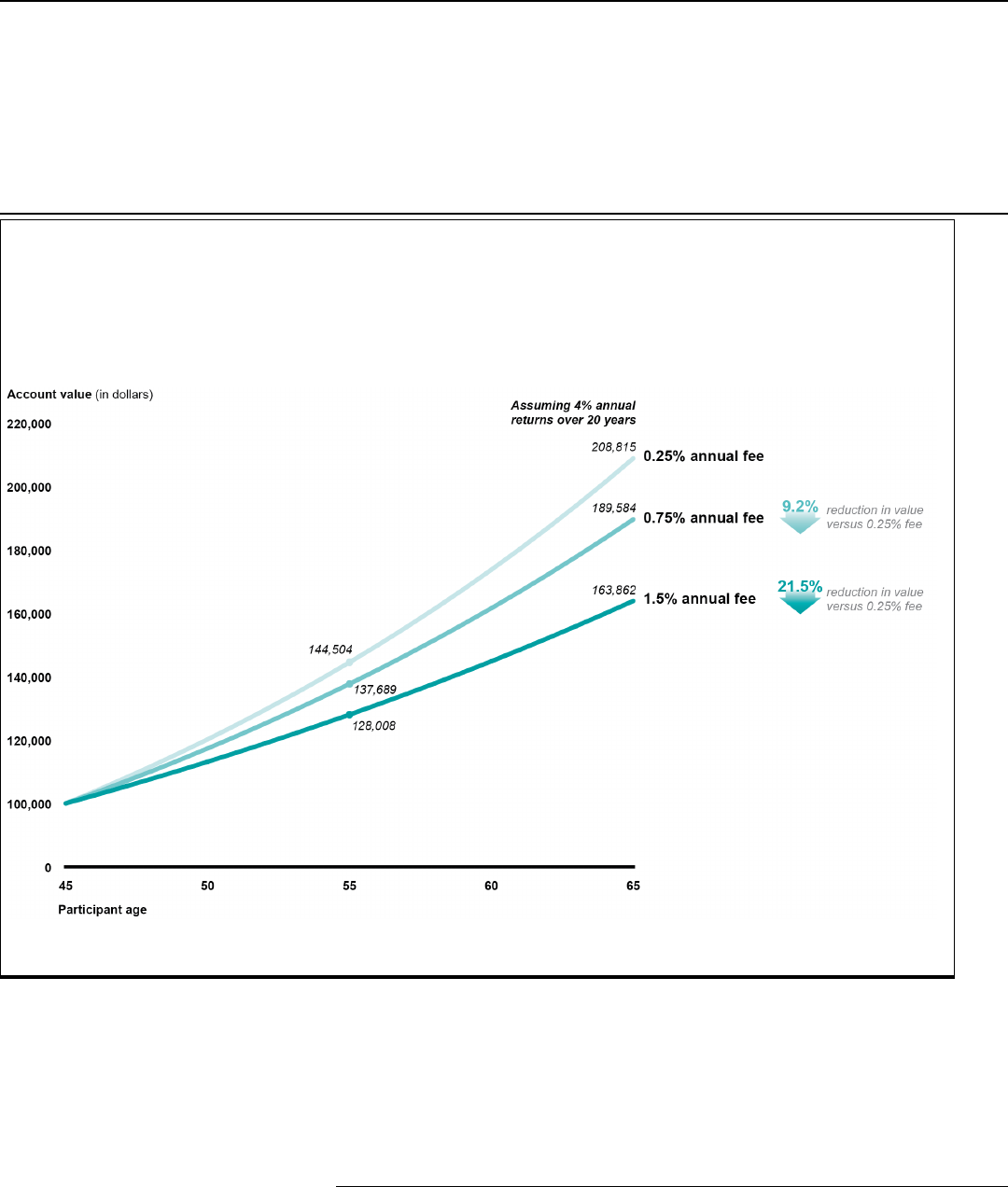
Page 35 GAO-22-104439 Defined Contribution Plans
Illustrative Example of How Fees Can Erode a Participant’s Retirement Savings
In a 403(b) plan, a participant’s account balance will affect the amount of retirement income the participant can receive from
the plan. While contributions to a participant’s account and positive returns on the investments will increase the retirement
income, negative returns and fees paid by the plan may substantially reduce the growth in the account, which will reduce the
amount of retirement income that can be generated from the account. Our prior work has shown that even seemingly small
fees, such as a 1 percent annual charge can significantly reduce plan participants’ retirement savings, even as investment
returns may grow the savings overall.
70
The graphic below illustrates how fees can impact a participant’s retirement savings
account.
Source: GAO analysis. | GAO-22-104439
Note: The amount of savings a participant accumulates depends on contributions, fees, and
investment returns. Higher fees can substantially reduce a participant’s savings over time compared
to what they may have accrued in lower fee options unless the higher fees are offset by higher
investment returns. This figure illustrates an initial $100,000 contribution and contrasts total fees of 25
basis points (higher line) with total fees of 75 basis points (middle line) and 150 basis points (lower
line), and assumes a 4 percent nominal investment return in each case.
70
GAO, Private Pensions: Changes Needed to Provide 401(k) Plan Participants and the
Department of Labor Better Information on Fees, GAO-07-21 (Washington, D.C.: Nov. 16,
2006).

Page 36 GAO-22-104439 Defined Contribution Plans
In addition, seven non-ERISA plan sponsors—six public school districts
and one state-sponsored plan for its state-funded universities—along with
sponsors of two of five ERISA plans reported in our survey that they did
not know the amount of fees associated with their plans’ investment
options, although we were able to identify and analyze such investment
option fee information for three of the public school districts through other
public sources.
71
An expert told us that local school districts often will not
have information regarding the fees associated with their plans’
investment options, or other information regarding the plans’ investment
offerings, because they are effectively delegating the plan administration
to a third-party administrator. Another representative from a large plan
told us information on investment fee expense ratios is a key factor in
determining which investments the large plan his organization sponsors
chooses to include, in order to ensure participants’ savings are not
eroded by high fees. Information on investment fees can be helpful to
plan sponsors and participants because it enables them to make
comparisons across similar investment options and determine if such
fees are reasonable.
72
See appendix III for the complete results of
reported fees for all plan sponsors and 403(b) service providers who
responded to our survey.
Surrender fees. 403(b) participants that invest in annuity options may
also pay surrender fees—fees for selling or withdrawing money from an
investment within a set period of time—which can significantly lower a
participant’s account balance should the participant decide to deselect the
71
Two of five ERISA plan sponsors that responded to our survey provided expense ratio
information regarding the investment options in their plan. Those expense ratios ranged
from 0.12 percent to 1.23 percent. For detailed information for all plans that responded to
our survey, see appendix III.
72
Our previous work has shown that, based on responses to a GAO generalizable survey,
an estimated 64 percent of 401(k) participants believed they were either not paying any
401(k) fees—administrative or investment fees—or did not know if they were paying such
fees. See GAO, 401(k) Retirement Plans: Many Participants Do Not Understand Fee
Information, but DOL Could Take Additional Steps to Help Them, GAO-21-357
(Washington, D.C.: July 27, 2021).
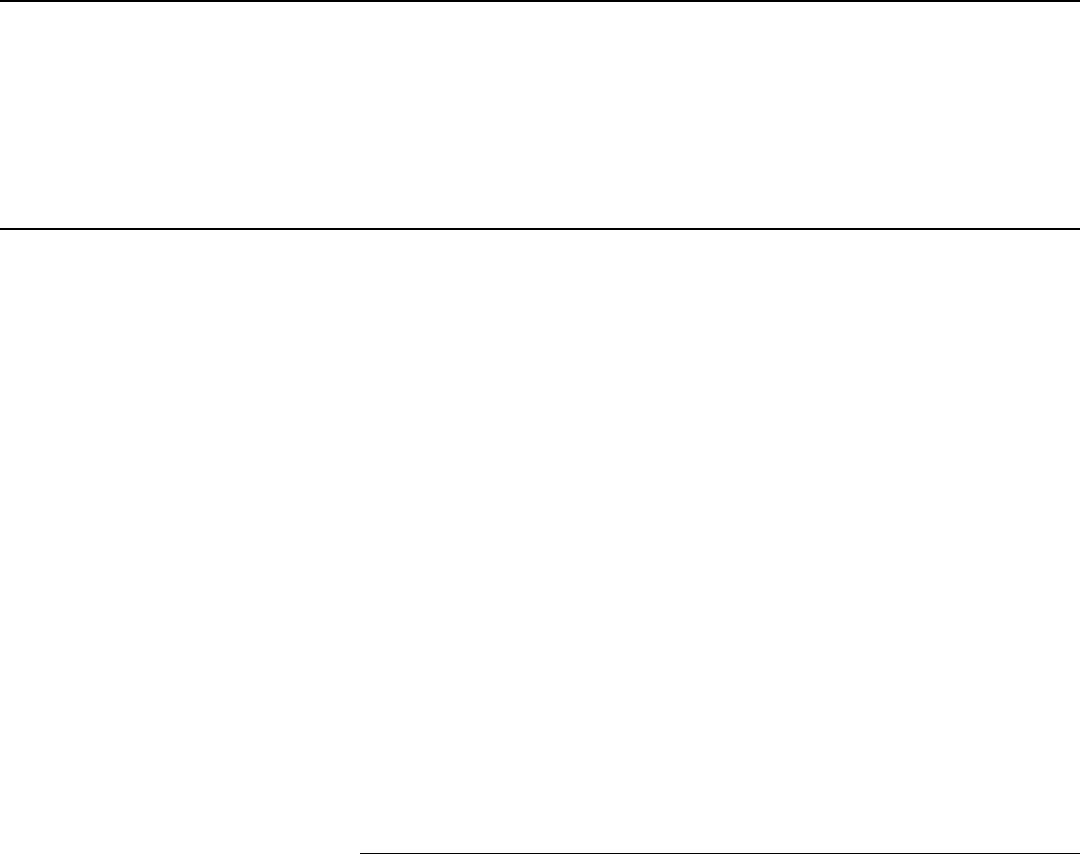
Page 37 GAO-22-104439 Defined Contribution Plans
annuity before the phase-out period is complete.
73
Surrender fees are
often phased out (i.e., gradually reduced) over a certain number of years.
Among 403(b) plans and service providers we surveyed that reported
surrender fees, these fees varied and ranged as high as 10 percent with
phase-out periods as long as 15 years. Administrative data we obtained
from one large, non-ERISA state sponsor with both fixed and variable
annuities among its investment options indicate that the most common
combination of surrender fee and phase-out period was 7 percent phased
out over 8 years.
74
Ten of 19 of the 403(b) service providers that
responded to our survey reported the plans they provide services to offer
annuities that charge surrender fees. For example, one 403(b) service
provider reported 75 percent of the annuity products for which it provides
record keeping and account services have surrender fees, with a
maximum of a 10 percent surrender fee with a phase-out period of 10
years.
75
Seven of the 26 plan sponsors, one of which reported not offering
annuities as an investment option in 2020, reported that some annuities in
the plans they sponsor charge a surrender fee. For example, one plan
sponsor reported that 60 percent of the plan’s annuity investment options
have surrender fees, with a maximum of a 10 percent surrender fee and a
73
For example, an annuity option may have a surrender fee where participants would be
charged a 7 percent fee if they want to take their 403(b) contributions out of that annuity
and move it to another investment option within the first year. Surrender fees are often
phased out over a period of years, and vary by specific investment options, but generally
involve a reduction of 1 to 2 percent per year until the surrender fee is no longer charged.
For example, an annuity with a 10-year, 10 percent surrender fee would charge 10
percent the first year to move money out of the annuity, 9 percent the second year, and so
on, until there is no surrender fee after the 10-year period.
74
More specifically, seven out of 26 fixed annuity and 467 out of 1,885 variable annuity
investment options had surrender charges of 8 percent or more, and six out of 26 fixed
annuity and 1,235 out of 1,885 variable annuity investment options had a phase out period
of 8 years or more. The most common specific surrender fee value was 5 percent. The
second most common surrender fee and phase- out combination was 5 percent with a
phase-out period of 6 years. Individual schedules for the phase out period vary by specific
investment options, but generally involve a reduction of 1 to 2 percent per year until the
surrender fee is no longer charged. For example, an annuity with a 10-year, 10 percent
surrender fee would charge 10 percent the first year to cancel plan participation, 9 percent
the second year, and so on, until there is no surrender charge after the 10-year period.
75
Additionally, five of 19 403(b) service providers reported not charging surrender fees,
and four of 19 service providers reported that they did not know whether they charged
surrender fees. For detailed responses for each 403(b) service provider, see appendix IV.

Page 38 GAO-22-104439 Defined Contribution Plans
phase-out period of 6 years.
76
For detailed responses from each plan and
403(b) service provider who responded to our survey, see appendix IV.
Surrender fees can significantly reduce a participant’s savings, should the
participant decide to switch investment options. Because the amount of
the surrender fee is generally phased out over a certain time period, the
potential cost is higher the sooner a participant opts to leave the annuity
option. For example, as shown in figure 6, if participants withdraw their
investments from an annuity with a 10 percent surrender fee that phases
out over 10 years, the fee would be higher if they made such a withdrawal
in the first year (10 percent fee) compared to the tenth year (1 percent
fee). Further, an expert stated that high surrender fees may discourage
some participants from leaving annuities that may charge annual fees or
not be in their best financial interest.
76
In addition, nine of 26 plan sponsors reported that they do not offer annuities, and had
no investment options subject to surrender fees. Six of 26 plan sponsors reported that
they offer annuities, but did not know whether or not these investment options carried
surrender fees. In addition, plan sponsors may offer or service providers may service
products, typically mutual funds, which are subject to short-term trading fees. These fees
are charged to an investor when shares are sold from a fund, and typically are only
applied within a certain time frame, in order to discourage short-term trading. Seven of 19
service providers reported the plans they provide services to charge short-term trading
fees for mutual funds, while eight reported that they did not, with four not knowing. Service
providers who specified the terms of short-term trading fees listed periods up to one year
and fees as high as 2 percent.

Page 39 GAO-22-104439 Defined Contribution Plans
Figure 6: Illustrative Examples of Surrender Fees on a Hypothetical Participant’s Account Balance, with an Initial Account
Balance of $10,000
Note: These examples illustrate the impact of a surrender charge on the initial account balance over
time and do not include an annual rate of return.
403(b) fees may be paid directly, where fees are paid directly to a service
provider; or they may be paid indirectly, where fees or compensation are
received by the service provider from sources other than directly from the
plan or plan sponsor, including amounts service providers receive from
charges against a mutual fund for things such as portfolio management or
Available Form 5500 Data
Show an Increase in
Administrative Fees Paid
Directly by ERISA 403(b)
Plans from 2010 to 2018,
among Other Things, but
Many Smaller Plans Did
Not Pay Such Fees

Page 40 GAO-22-104439 Defined Contribution Plans
brokerage commissions.
77
When fees are paid indirectly, fees or
compensation are received from a source other than the plan, plan
sponsor, or an affiliate. As an example, indirect fees may be deducted
from the investment funds held by the plan. While the Form 5500
provides limited information on ERISA 403(b) plans for both directly paid
and indirectly paid fees, available data show that the share of ERISA
403(b) plans paying administrative fees directly out of plan assets from a
covered plan has increased over time. During the time period between
2010 and 2019, plans that reported directly paid administrative fees on
the Schedule H (generally plans with 100 or more participants) increased
from 69 percent to 89 percent during the time period.
78
Limitations of Form 5500 Data
While the Form 5500 captures information on 403(b) plan fees for plans subject to the Employee Retirement Income Security
Act of 1974, as amended (ERISA), these data have several limitations and lack comprehensive information about service
providers and their fees. For example, Schedule C collects information on compensation paid to a plan’s service providers.
However, this does not include compensation below $5,000 and reported fees are not itemized by the type of service provided.
In addition, 63 percent of all ERISA 403(b) plans are small—with 99 or fewer participants—and do not file the Schedule C.
According to Department of Labor (DOL) officials, there is no authoritative way to identify all the fees a plan pays for direct or
indirect administrative services through the Form 5500 and its reporting schedules. GAO has previously reported that the Form
5500 series has several key limitations and does not capture total plan fees. In a 2014 report,
a
we noted there were
longstanding concerns regarding the quality and usefulness of the Form 5500 data collected on plan investment and service
provider fees, especially from those who prepare and use the data.
b
We recommended that DOL make several revisions to the
5500 to provide better information on plan fees. While DOL previously proposed changes to improve information on fees
collected through the Form 5500,
c
these changes have not been implemented as of December 2021 and our recommendation
to DOL remains open. In September 2021, DOL officials told us revisions to the Form 5500 series, including to Schedules A,
C, I, and the Short Form, were under agency consideration.
Source: GAO review of DOL documentation and interviews with DOL officials. l GAO-22-104439
a
GAO, Private Pensions: Targeted Revisions Could Improve Usefulness of Form 5500 Information,
GAO-14-441, (Washington, D.C.: June 5, 2014).
b
In that report, more than half of stakeholders who responded to a GAO survey said, among other
things, that the form’s information on service provider fees was misaligned with other required fee
disclosures. In that report, stakeholders also identified issues with the completeness of service
provider and fee information.
c
DOL and IRS proposed changes to Schedules C and H in 2016 to, among other things, decrease the
threshold for many categories of service providers from $5,000 to $1,000 for reporting on the
Schedule C.
77
Generally, fees are ultimately borne either by the plan sponsor or by participants. Our
analyses of fees does not distinguish between the proportions borne by participants or
plan sponsors, which is beyond the scope of our work because of data limitations. In
addition, Form 5500 data on fees only capture those fees either paid directly by the plan
or indirectly; it does not capture fees paid directly by the plan sponsor.
78
During the time period, the percentage of Form 5500 short form filers—generally for
plans with 99 or fewer participants—reporting directly paid administrative fees increased
from 29 percent to 43 percent.

Page 41 GAO-22-104439 Defined Contribution Plans
As more plans paid for administrative fees directly out of plan assets, the
amount of these fees reported by ERISA 403(b) plans also increased.
Our analysis of Form 5500 data found that total administrative fees paid
directly by the plan increased from about 0.05 percent of plan assets in
2010 to 0.08 percent of plan assets in 2019 among plans that reported
administrative expenses.
79
All types of administrative fees, including
professional fees, contract administrator fees, investment advisory and
management fees, and other fees increased in both absolute terms and
as a share of plan assets during that time period.
80
Because this measure
includes only administrative fees paid directly by the plan, and not those
that are paid indirectly, it does not indicate, among other things, whether
administrative fees borne by participants have changed. DOL officials told
us that total direct administrative fees reported on the Form 5500 may be
increasing because more plans are paying for administrative services
directly rather than having service providers receive compensation
indirectly. In addition, officials said that direct administrative fees could
have increased due to greater compliance and reporting of fees that were
previously under-reported or that some plan sponsors who previously
paid for plan fees out of plan sponsor assets have now shifted to paying
them from plan assets.
81
Nonetheless, while the amount of administrative fees paid directly by
ERISA 403(b) plans out of plan assets has increased, Form 5500 data
indicated that the majority of smaller plans reported they paid no direct
administrative fees in 2019, as shown in figure 7.
79
This reflects total fees as reported on Schedule H line 1f, Schedule I line 1a, and Form
5500-SF line 7a, as a percentage of assets as reported on Schedule H line 2i(5),
Schedule I line 2h, and Form 5500-SF line 8a. In 2019 dollars, the increase was from
$122 million in 2010 to $454 million in 2019. We conducted the same analysis for reported
fees for 401(k) plans, and found that fees were similarly trending upwards.
80
These more detailed fees are reported in the Schedule H, which is generally filed by
plans with 100 or more participants. As noted elsewhere, the percentage of plans that
reported paying fees on schedule H increased from 2010 to 2019. As such, the greater
number of plans complying with requirements to report this information may account for
some of the overall increase in reported fees.
81
DOL officials told us that a reason why a plan may report total expense of zero is that
the plan sponsor may have paid for plan-related expenses out of the plan sponsor’s
assets, rather than charging the expenses to the plan itself. A reported total expense of
zero could signal that the plan sponsor is paying all the expenses outside of the plan.
According to DOL officials, a question designed to track the extent to which expenses
were paid by the plan sponsor was eliminated in 2000.
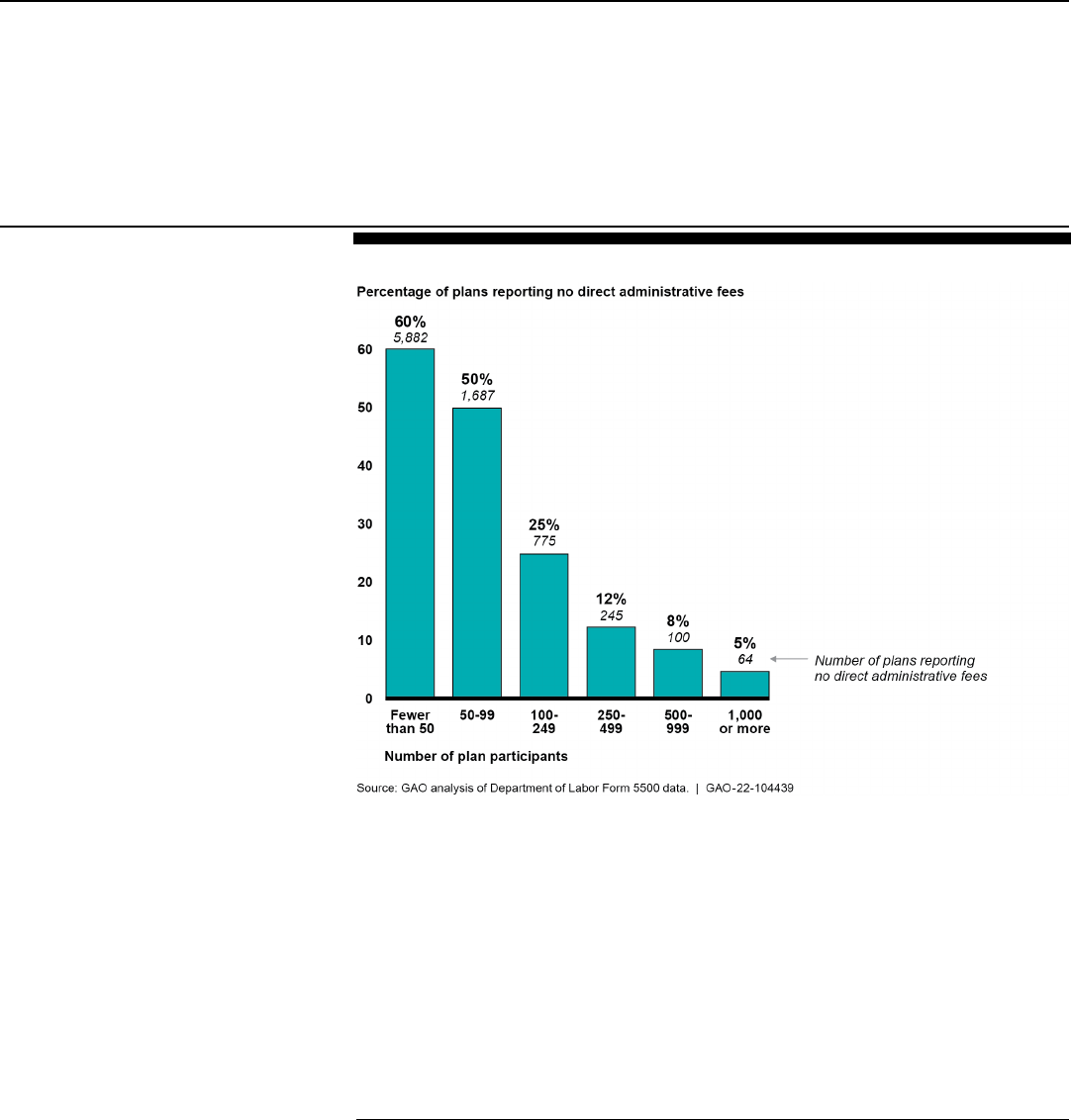
Page 42 GAO-22-104439 Defined Contribution Plans
Figure 7: ERISA 403(b) Plans Reporting No Direct Administrative Fees, 2019
Note: ERISA refers to the Employee Retirement Income Security Act of 1974, as amended.
A plan may report zero direct administrative fees because all its fees were
paid either directly by the plan sponsor or indirectly through participants’
investment or other fees, rather than as direct plan expenses. According
to DOL officials, plans in the education or hospital sectors more frequently
use service providers that recover administrative expenses indirectly.
82
We asked 403(b) service providers to indicate the highest and lowest
direct participant fees or compensation that the service provider charges
or otherwise receives from the plans they provide services to, and these
82
Our analysis shows that 47 percent of education plan sponsors reported $0 fees, as well
as 47 percent of religious and similar organizations, 43 percent of social service
organizations, 21 percent of health care organizations, and 47 percent of all other tax-
exempt organizations. Plan sponsors report the North American Industry Classification
System codes (NAICS) code corresponding to their principal business activity on the form
5500. We categorized as follows: education, including schools, colleges, and universities,
business code 611000; health care, business codes from 621111 to 623000; social
service, business codes from 624100 to 624410; religious and similar (includes religions,
grant making, civic, professional, and similar organizations), business code 8130000;
other – all other NAICS codes.

Page 43 GAO-22-104439 Defined Contribution Plans
fees varied. Eight of 19 service providers responded to this question and
reported fees ranging from 0 to 2.72 percent of account assets annually.
For complete information regarding what each of our service provider
survey respondents reported regarding other direct fees, see table 6 in
appendix III.
With respect to indirect fees—among plans that filed a Form 5500
Schedule C, which includes fees paid indirectly—record keeping fees
were the most common type of fee reported being paid to one or more
service providers for services valued at $5,000 or more in 2019,
according to our analysis of Schedule C data for 2019, the most recent
year for which data are available.
83
Table 4 provides details on the
number and percentages of 403(b) plans reporting paying $5,000 or more
to service providers for direct or indirect plan fees in 2019.
Table 4: Percentage of ERISA 403(b) Plans Reporting Paying Fees of $5,000 or More, by Fee Category
Type of fee detailed on Schedule C
Percentage of 403(b) plans with 100 or more participants reporting
paying an entity $5,000 or more for services including this type of
fee
Record keeping fees
64.0%
Record keeping and information management (computing,
tabulating, data management)
50.5%
Direct payment from the plan
a
46.4%
Participant loan processing
44.2%
Investment advisory (plan)
35.4%
Account maintenance fees
28.0%
Contract administrator
27.7%
Investment Management
25.7%
Investment management fees paid indirectly by plan
23.1%
Participant communication
22.9%
Distribution fees
22.1%
Claims processing
19.6%
Shareholder servicing fees
19.1%
Source: GAO analysis of Form 5500 Schedule C data. l GAO-22-104439
Notes: ERISA refers to the Employee Retirement Income Security Act of 1974, as amended. Form
5500 Schedule C captures direct and indirect compensation paid by plans (that have 100 or more
participants) for each person who rendered services to or had transactions with the plan and who
83
Form 5500 Schedule C captures direct and indirect compensation (fees) that large
plans (100 or more participants) paid to each person who rendered services to or had
transactions with the plan and who received $5,000 or more in total direct or indirect
compensation in connection with services rendered to the plan.

Page 44 GAO-22-104439 Defined Contribution Plans
received $5,000 or more in total direct or indirect compensation in connection with any and all
services rendered to the plan.
a
According to Schedule C filing instructions, direct payments by the plan would include, for example,
direct payments by the plan out of a plan account, charges to plan forfeiture accounts and fee
recapture accounts, charges to a plan’s trust account before allocations are made to individual
participant accounts, and direct charges to plan participant individual accounts. Payments made by
the plan sponsor that are not reimbursed by the plan, are not subject to Schedule C reporting
requirements even if the sponsor is paying for services rendered to the plan.
Although there are no comprehensive data available to report trends in
direct and indirect fees, some industry representatives and industry
stakeholders told us that, in general, fees trended down over time.
ICI/BrightScope found total ERISA 403(b) plan cost decreased from 0.59
percent in 2009 to 0.45 percent in 2017 on an asset-weighted basis, and
that nearly all plan size groups saw declines in total plan cost between
2009 and 2017.
84
Among the 21 non-ERISA plan sponsors who
responded to our survey, 11 reported that fees had gone down, while
seven reported fees had remained about the same, with three others
reporting that they did not know whether fees decreased or not. Four of
the five ERISA plan sponsors among our survey respondents reported
that they did not know whether fees had decreased or not; the other
ERISA respondent reported that fees had remained about the same. No
plan sponsors reported that fees had increased.
We also asked 403(b) service providers to indicate the highest and lowest
indirect fees or compensation that the service provider charged the plan
or plan’s affiliate, and found these fees varied. Six of 19 service providers
responded to this question and reported fees ranging from 0 to 2.0
percent annually.
85
For complete information regarding what each of our
service provider survey respondents reported regarding other indirect
fees, see table 6 in appendix III.
84
ICI/BrightScope also reported total plan costs on a plan and participant-weighted basis.
Specifically, on a plan-weighted basis, ICI/BrightScope found that total plan costs were
0.82 in 2009 and 0.81 percent in 2017. On a participant-weighted basis, total plan costs
declined from 0.68 percent to 0.57 percent over the same time period. These figures apply
to what ICI/BrightScope characterizes as “large” plans, which they define as plans who file
a Form 5500 including a Schedule H with DOL–generally these plans would have 100 or
more participants.
85
We note that the service provider with the highest reported direct or indirect fee charged
participants declined permission to include the provider’s information in appendix III.
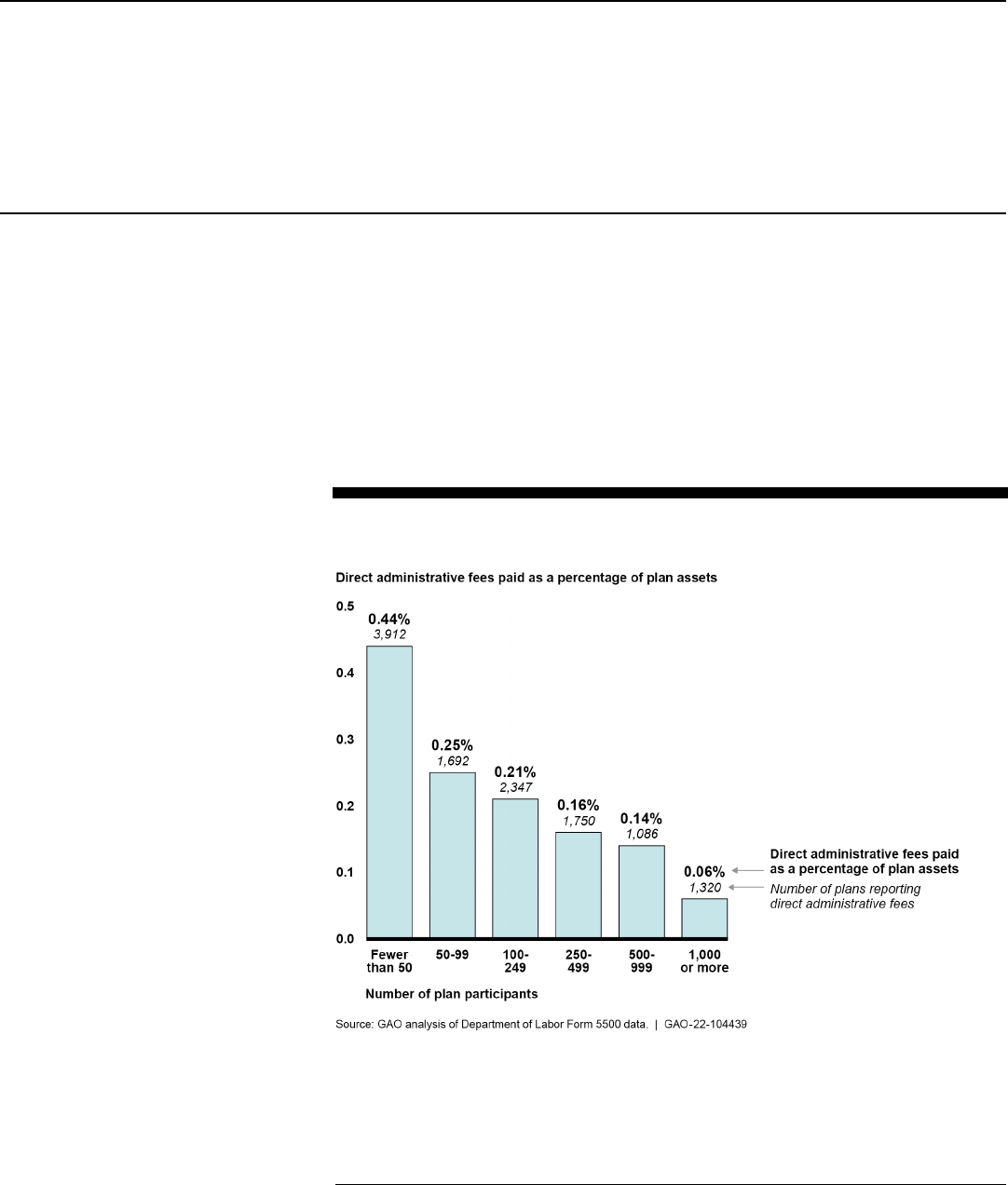
Page 45 GAO-22-104439 Defined Contribution Plans
Available data from the Form 5500 show that large ERISA 403(b) plans
had lower direct administrative fees than smaller plans. Specifically, our
analysis of Form 5500 data for 2019 found that, among plans that
reported direct payments, large ERISA 403(b) plans (defined by DOL as
those who reported having 100 or more participants) paid lower average
direct administrative fees than small plans—0.076 percent of total assets
for large plans compared to 0.335 percent of total assets for small
plans.
86
As shown in figure 8, direct administrative service fees in 2018,
as a percent of plan assets, were highest for the smallest plans with fewer
than 50 participants.
Figure 8: Reported Average Direct Fee Amounts as a Percentage of Assets Paid by
403(b) ERISA Plans for Administrative Services, by Plan Size in Terms of Number of
Participants, 2019
Note: ERISA refers to the Employee Retirement Income Security Act of 1974, as amended. Data are
for plans that reported paying $1 or more in direct administrative service expenses; we excluded
those that reported no fees for direct administrative service expenses. Plans with 100 or more
participants (large plans) generally report total administrative service fees on Schedule, H, which is a
combined total of individually reported professional fees, contract administer fees, investment
management and advisory fees, and other administrative fees. Plans with 99 or fewer participants
(small plans) generally do not differentiate among various types of fees and instead report one top
86
This analysis is of those plans that reported fees on Schedule H, Schedule I, or the
Form 5500 short form. The data do not include administrative fees that were paid
indirectly.
Available Data Indicate
That the Largest 403(b)
Plans Had Lower
Administrative and
Investment Fees than
Smaller Plans

Page 46 GAO-22-104439 Defined Contribution Plans
line number of total administrative fees on the Form 5500-SF or Schedule I, a simplified version of
Schedule H for plans that would be small enough for the Form 5500-SF in that they are 99 or fewer
participants, but for certain reasons are not eligible to file Form 5500-SF.
This variation in fees by plan size is consistent with industry data on total
administrative and investment fees. While average total plan cost, which
includes asset-based management fees, and asset-based administrative
and advice fees for ERISA 403(b) plans were 0.81 percent in 2017 on a
plan-weighted basis, fees varied considerably by plan size.
87
Specifically,
total plan costs for the largest ERISA 403(b) plans (defined as having
over $1 billion in assets) averaged 0.37 percent, while those for plans
with under $1 million in assets averaged 1.33 percent.
While no comprehensive data are available on fees for non-ERISA plans,
responses from our survey of 26 ERISA and non-ERISA 403(b) plan
sponsors and 19 service providers that responded to our survey also
indicate that, as a percentage of total assets, smaller plans pay higher
fees than larger plans, at both the plan level and the investment level.
Among the 14 plan sponsors (out of 26 total) who reported record
keeping and administrative fee information as a single number on our
survey, those who sponsored the seven smallest in terms of total assets
reported record keeping and administrative fees between 0.06 and 0.27
percent of total assets (with a median of 0.1425 percent), whereas those
who sponsored the seven largest plans in terms of total assets reported
paying record keeping and administrative fees between 0.0008 and 0.18
percent of total assets (with a median of 0.0285 percent).
88
The results of our surveys of service providers indicate that smaller plans
pay more in fees at the investment level. More specifically, with respect to
investment-level fees, eight of the 19 403(b) service providers who
responded to our survey furnished a total of 66 selected examples of
different-sized 403(b) plans and the expense ratios associated with
87
See BrightScope, The BrightScope/ICI Defined Contribution Plan Profile: A Close Look
at ERISA 403(b) Plans, 2017 (January 2021). Its definition of “total plan costs” reads, in
full, the inclusion of asset-based investment management fees, asset-based
administrative and advice fees, and other fees (including insurance charges) from the
Form 5500 and audited financial statements of 403(b) plans covered by ERISA. When
plans use products registered under the Investment Company Act of 1940–such as mutual
funds–expense data from Lipper are used to calculate fees.
88
Three other plan sponsors reported record keeping and administrative fees, but
expressed their response in terms of a range. Nine other plan sponsors did not respond to
this question on the survey.
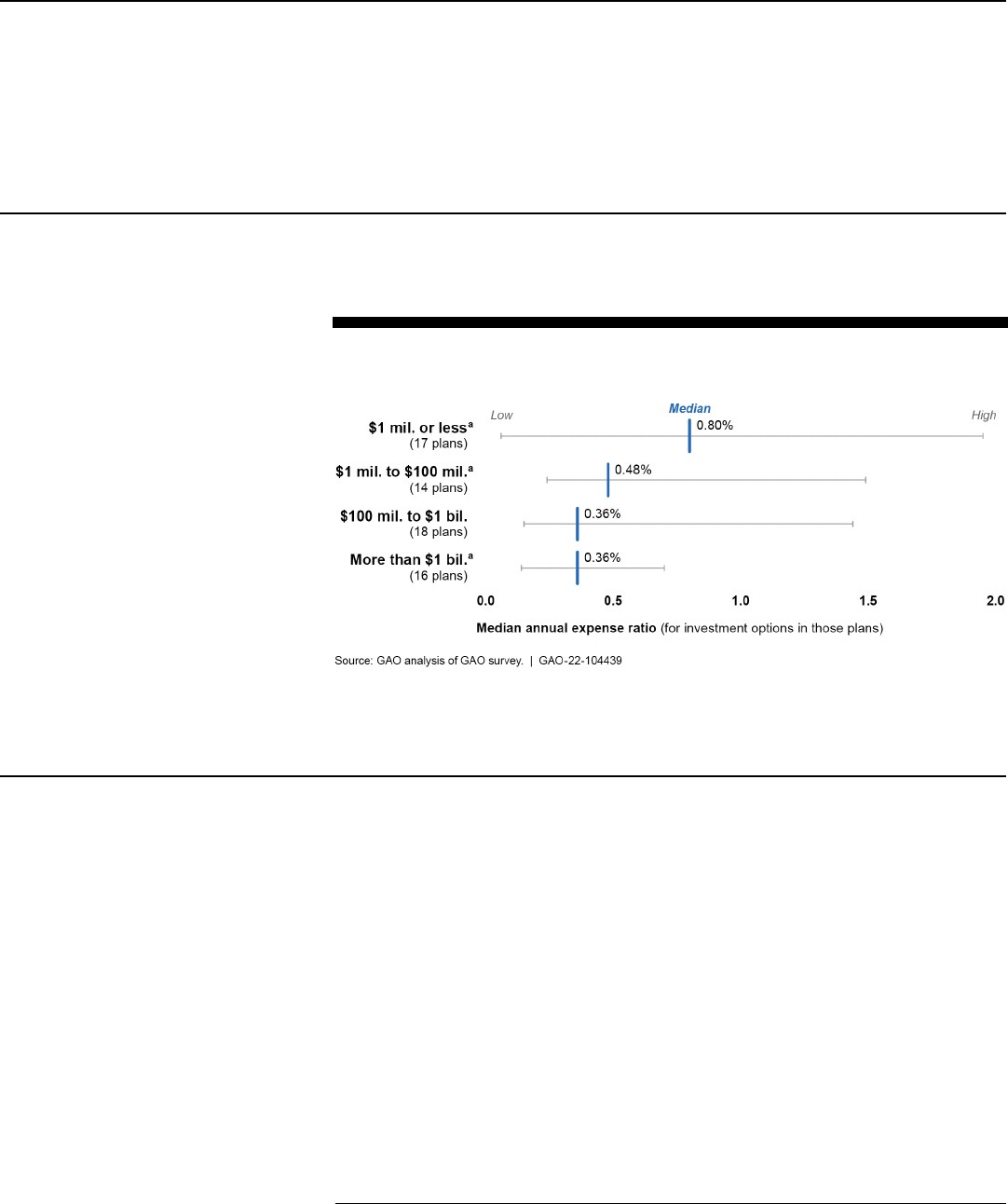
Page 47 GAO-22-104439 Defined Contribution Plans
them,
89
and the reported expense ratios for the smaller example plans
were generally higher than those of the larger example plans, as shown in
figure 9.
Figure 9: Median Expense Ratios as a Percentage of Assets Paid by 403(b) Plan
Sponsors, by Plan Size in Terms of Total Assets, from Example Plans Provided by
403(b) Service Providers
Note: Nine of the 19 service providers that responded to our survey provided a total of 66 example
403(b) plans, which furnished the data for this table. This figure excludes four sample plans submitted
by service providers with a reported expense ratio of zero.
University plans, state-sponsored plans, and the largest 403(b) plans—
those with $1 billion or more in assets, which included three public school
districts—who responded to our survey reported they were more likely to
take actions to more actively manage their plans than other plan sponsors
and to cite low fees as being among the most important factors
considered in selecting service providers. In particular, our surveys found
that the 15 university, state-sponsored, or large plan sponsors with $1
billion or more in assets took actions to manage their plans or evaluate
fees:
• Eleven of 15 of such plan sponsors reported requesting quotes or bids
from multiple providers.
• Nine of 15 of such plan sponsors reported using outside consultants
to compare fees.
• Eight of 15 of such plan sponsors reported evaluating fees paid on a
quarterly, semi-annual, or annual basis, while 13 of 15 reported
89
This figure excludes four sample plans submitted by service providers with a reported
expense ratio of zero.
University Plans, State-
Sponsored Plans, and
Plans with $1 Billion or
More in Assets Reported
Taking Multiple Steps to
Reduce Fees, While Some
Sponsors Reported They
Did Not Know about or
Manage Investment
Options

Page 48 GAO-22-104439 Defined Contribution Plans
evaluating their menu of investment options on at least an annual
basis.
• Five of 15 such plan sponsors reported using information from DOL to
compare fees.
By contrast, among the other 11 plan sponsors—those public school
districts with less than $1 billion in assets and other smaller tax-exempt
organizations—fewer reported taking actions to evaluate fees:
• Six of 11 of such plan sponsors reported requesting quotes or bids
from other providers.
• Two of 11 such plan sponsors reported using outside consultants to
compare fees.
• One of 11 such plan sponsors reported evaluating fees on an annual
basis, with three other such plan sponsors reported doing so every 2
or 3 years; one of 11 reported evaluating their menu of investment
options on at least an annual basis, with six other plan sponsors doing
so every 2, 3, or 5 years.
• Two of 11 such plan sponsors reported using information from DOL to
compare fees.
These survey data are consistent with a 2021 industry survey that
showed that over 88 percent of 403(b) plan sponsors with 1,000 or more
participants reviewed plan fees on at least an annual basis, compared to
70 percent of plan sponsors with fewer than 50 participants and 76
percent of plan sponsors with between 50 and 199 participants.
90
Consistent with that survey, in our survey we found the largest plan
sponsors reported they were more likely to take certain actions with
respect to reviewing plan fees on a regular basis.
91
We found the
following:
• Seven of our largest 16 plan sponsor respondents reported reviewing
their investment options on at least an annual basis, while two
sponsors among our smallest 10 plan sponsor respondents reported
doing so.
90
Plan Sponsor Council of America, 2021 403(b) Survey Report, Reflecting 2020 Plan
Experience.
91
We grouped plan sponsors according to size of assets for this analysis.

Page 49 GAO-22-104439 Defined Contribution Plans
• Nine of our largest 16 plan sponsor respondents reported that they
reviewed plan fees on a quarterly basis, while only one sponsor of our
smallest 10 plan sponsor respondents reported doing so.
We categorized respondents into groups to identify trends in the extent to
which certain groups of plan sponsors were more active in certain
aspects of plan management: (1) university plans, state-sponsored plans,
and the largest plans—those with $1 billion or more in total assets, which
included three school public districts—and (2) other plan sponsors,
including public school districts with less than $1 billion in assets and
smaller tax-exempt organizations. We found the following:
• Eight of the 15 of state-sponsored, university, or other large plan
sponsors reported that outside entities such as plan consultants,
investment advisors, third-party administrators, bundled providers, or
record keepers handled most plan administration functions. Among
this group, two plan sponsors reported that they do not contract with
outside entities to help administer their 403(b) plans.
• Nine of the 15 state-sponsored, university, or other large plan
sponsors cited low fees and rates charged as being among the three
most important factors in selecting service providers. Of those nine,
three chose that factor as the top consideration. This factor was also
cited by three of the 10 plan sponsors with less than $1 billion in
assets or tax-exempt organizations who responded to this question on
our survey. No plan sponsors from among these 10 school districts
with less than $1 billion in assets and smaller tax-exempt organization
plan sponsors chose this factor as a top consideration.
• Eleven of the 15 state, university, or other large plan sponsors cited
the experience, technical capability, and knowledge of legal
requirements among staff as among the three most important factors
in selecting service providers. This factor was cited by seven of the 10
plan sponsors of school districts with less than $1 billion in assets or
smaller tax-exempt organizations who responded to this survey
question.
92
This factor was the one most frequently cited as among
the top three criteria by both groups of plan sponsors. However, two
plan sponsors from the group of state, university, and school districts
with $1 billion or more in assets cited this factor as the most
92
One small plan sponsor responded to the survey questions regarding whether it used
outside providers, but did not respond to the question regarding which factors led it to
select service providers. As such, there were 11 respondents among this group for some
items in this section, and 10 for others.
University Plans, State-
Sponsored Plans, and the
Largest Plans with $1
Billion or More in Assets
More Frequently Cited
Low Fees as an Important
Factor in Hiring Service
Providers than Other
403(b) Plan Sponsors

Page 50 GAO-22-104439 Defined Contribution Plans
important, while no plan sponsors of the school districts with less than
$1 billion in assets and tax-exempt organization did so.
The 11 public school district plans with less than $1 billion in assets and
other smaller tax-exempt organization plan sponsors we surveyed
reported contracting with outside entities to provide the majority of plan
administrative functions about as often as the state and university plan
sponsors and largest plan sponsors. However, most of these 11 public
school district and smaller plan sponsors cited factors other than low fees
as being most important in selecting service providers:
• Contracting with outside entities to provide services is a practice cited
by all 11 of the plan sponsors for school districts with less than $1
billion in assets and for smaller tax-exempt organizations we
surveyed. Of those, six reported that those outside entities handled
most plan administration functions. These outside entities can include
plan consultants, investment advisors, third-party administrators,
bundled providers or record keepers.
• Both groups of plan sponsors were about equally likely to cite a
provider’s ability to handle all of our plan’s administrative needs,
including record keeping, legal compliance, and other needs as being
among the three most important criteria in selecting a provider for
record keeping and administrative services. Nine of 15 plan sponsors
among the university, state, and public schools with $1 billion or more
in assets cited this factor, while seven of the 10 plan sponsors for the
school districts with less than $1 billion in assets or for smaller tax-
exempt organizations did so. Of the latter group of 10, five plan
sponsors chose this factor as the single most important one; of the 15
plan sponsors for university, state, or school districts with $1 billion or
more in assets, six chose this factor.
Both groups of plan sponsors were about equally likely to cite customer
service features such as consistency, timeliness, and availability of
customer service as among the three most important factors in selecting
service providers; 10 of 15 plan sponsors for the university, state, and
public schools with $1 billion or more in assets cited this factor, while
seven of 10 plan sponsors for school districts with less than $1 billion in
assets or for tax-exempt organizations did so. Three of the 10 plan
sponsors for school districts with less than $1 billion in assets or for tax-
exempt organizations who answered this question ranked that factor the
highest, compared with two of the 15 plan sponsors for university, state,
or public schools with $1 billion or more in assets group.

Page 51 GAO-22-104439 Defined Contribution Plans
The university- and state-sponsored plans, and other plans who reported
having $1 billion or more in assets that responded to our survey were
generally more likely to report that they were able to reduce their plan
fees than were sponsors of other plans. Twelve of 15 such plan sponsors
reported that they were able to lower fixed or explicit costs to their plans,
compared with three of 11 sponsors of public school districts with less
than $1 billion in assets and other tax-exempt organization plans.
For example, one state university system was able to lower expense
ratios for the investment options under one vendor in its 403(b) plan from
0.95 percent per year to 0.48 percent per year following a consultant-led
analysis of its investment options. One large university plan reported it
was able to lower its record keeping and account administration fees from
just under 1.0 percent to 0.65 percent.
93
This plan sponsor stated that the
plan was able to do this by (1) reducing the number of investment options
from over 100 when the official first started with the organization to 15 at
present, which generated administrative efficiencies; and (2) working with
some vendors to provide an essentially identical product from the vendor
but with the plan’s name instead of the vendor’s brand. The plan sponsor
stated these actions enabled it to lower the charged administrative fees,
even though it continued to use the same identical account managers and
identical portfolio pre- and post-negotiation of the fee structure and
specifics. Another state sponsor reported lowering its range of fees,
including both plan-level and investment-level fees, from a combined 0.2
percent to 4.8 percent of a participant’s account balance to between 0.18
percent to 1.0 percent of a participant’s account balance as an annual
charge.
94
We provided a draft of this report to the Department of Labor; the
Department of the Treasury, including the Internal Revenue Service; and
the Securities and Exchange Commission. The Internal Revenue Service
and the Securities and Exchange Commission provided technical
93
This data point is for administrative fees only, and does not include other fees such as
investment option expense ratios.
94
The plan sponsor stated it consolidated its 403(b) plans from over 1,600 options to 14
options and that when designing the investment menu of the state’s new plan for
educators, the plan decided to adopt a non-revenue sharing basis and go solely on a fee
basis. Setting the plans up that way allowed the plan sponsor to put fee information on
participants’ statements and avoid the previous situation where participants did not realize
they were paying fees, because the fees were wrapped into the investment option fee or
expense ratio.
Agency Comments

Page 52 GAO-22-104439 Defined Contribution Plans
comments, which we incorporated as appropriate. The Department of
Labor did not provide formal comments on the draft report.
As agreed with your office, unless you publicly announce the contents of
this report earlier, we plan no further distribution until 30 days from the
report date. At that time, we will send copies to the appropriate
congressional committees, the Secretary of Labor, the Chair of the
Securities and Exchange Commission, and other interested parties. In
addition, the report will be available at no charge on the GAO website at
https://www.gao.gov.
If you or your staff have any questions about this report, please contact
us at (202) 512-7215 or [email protected]. Contact points for our Offices
of Congressional Relations and Public Affairs may be found on the last
page of this report. GAO staff who made key contributions to this report
are listed in appendix V.
Sincerely yours,
Tranchau (Kris) Nguyen
Director
Education, Workforce, and Income Security Issues

Appendix I: Objectives, Scope, and
Methodology
Page 53 GAO-22-104439 Defined Contribution Plans
This report examines (1) the number and characteristics of ERISA and
non-ERISA 403(b) plans; and (2) fees charged to 403(b) plan
participants.
To describe the number and characteristics of 403(b) plans, we obtained
and analyzed data from the Health and Retirement Study (HRS)
regarding whether respondents over age 50 report participating in ERISA
or non-ERISA 403(b) plans, including their 403(b) account balances,
household assets, earnings, and the industry in which they are
employed.
1
The HRS is a project of the University of Michigan’s Institute
for Social Research that is funded through the National Institute on Aging
and the Social Security Administration. This biennial longitudinal survey
collects data on individuals over age 50, gathering information on marital
status, retirement plans held, and income from retirement plans. The HRS
includes both members of a couple as respondents.
Each biennial period is referred to as a “wave.” The initial 1992 cohort
consisted of respondents who were over age 50 to 61 years old, and
these respondents were interviewed every 2 years since 1992. New
cohorts have been added over time to maintain the representation of the
older population from pre-retirement through retirement and beyond. We
used data from 2010 to 2016 for our analyses.
2
We weighted the data
and calculated standard errors to reflect HRS guidance based on our
sample size and design.
The HRS contains a data field to identify those respondents that report
having a 403(b) retirement account. An analysis of HRS data yielded 279
403(b) plans identified by 270 HRS respondents for the 2016 wave, the
most recent year for which data are available. We selected 401(k)
account holders as a comparison group here and elsewhere in the report
because, according to Department of Labor (DOL) data and reporting,
401(k) accounts comprise the largest share of defined contribution
retirement accounts by number of plans.
1
During the course of the review, we also reviewed relevant information, such as
questionnaires and user guides, from three other nationally representative survey
databases—the Current Population Survey, the Survey of Consumer Finances, and the
Survey of Income and Program Participation, but found they did not contain relevant
information for our purposes.
2
We used the RAND 2018 V1 longitudinal file and restricted the sample to responses in
HRS waves 2010 to 2016 because sampling weights for 2018 were not yet available at
the time of our analysis (December 2021).
Appendix I: Objectives, Scope, and
Methodology
Identifying the Number
and Characteristics of
ERISA and Non-ERISA
403(b) Plans

Appendix I: Objectives, Scope, and
Methodology
Page 54 GAO-22-104439 Defined Contribution Plans
The HRS data have some limitations. For example, survey responses are
self-reported. As such, they are subject to the respondent’s possible
errors in reporting specific financial amounts. In addition, the 401(k) and
403(b) data may be understated because many respondents indicated
that they have a defined contribution plan of unspecified type. Some of
these unspecified plans are likely to be 403(b) or 401(k) plans because
these two plan types are so common. The survey population is those over
age 50 and their spouses or partners, so it is not expected to capture
younger participants in these plans. Further, since respondents are asked
only about the retirement accounts at their current job, HRS may not
capture information regarding some respondents’ retirement accounts
from previous jobs or from retirees.
We reported estimates of the proportion of those respondents who
reported having only a 401(k) or only a 403(b) account holder.
3
The
estimated population proportions and associated confidence intervals are
generalizable to the population of adults in the United States, over age
50, who were employed. Some estimates, such as the estimated
differences regarding the extent to which 403(b) and 401(k) plans were
primary plans in 2016 and the estimated change in the share of the U.S.
population participating in 403(b) plans (both ERISA and non-ERISA)
from 2010 to 2016 were not statistically significant at the 95 percent
confidence interval.
We performed a data reliability assessment of the HRS variables we
included in our analyses. We reviewed technical documentation,
conducted electronic data tests for completeness and accuracy, and
contacted knowledgeable officials with specific questions about the data.
We determined that the data for the variables we used were sufficiently
reliable for the purposes of reporting on the estimated number of
individuals that reported participating in an ERISA or non-ERISA 403(b)
retirement plan, the extent to which the 403(b) plan was the participant’s
primary retirement plan or supplemental retirement plan, and the selected
demographic characteristics of these individuals.
3
We identified a very small number of respondents who reported both 401(k) and 403(b)
accounts and who had the characteristics of the variables described above. The “both
401k and 403b” respondents were an insufficient sample of observations to generate
reliable estimates. However, if the respondent had either a 401(k) or 403(b) account—not
both types of accounts—and a defined benefit pension plan, we included them in our
analysis.

Appendix I: Objectives, Scope, and
Methodology
Page 55 GAO-22-104439 Defined Contribution Plans
In addition, we analyzed plan-level characteristics—including the number
of participants, the amount of plan assets, and available information on
plan investment offerings for ERISA 403(b) plans—from DOL’s Form
5500 database. DOL’s Form 5500 Database captures information from
each ERISA-covered retirement plan—including ERISA 403(b) plans—on
the number of plan participants, assets held by the plan, and
administrative fees paid by the plan, among other things. For the
purposes of this report, we generally defined the largest plans as those
with $1 billion or more in assets, unless otherwise indicated. Consistent
with filing requirements for the Form 5500, we generally defined small
plans as those with either 99 or fewer participants. In some cases we
further defined small plans as those with $1 million or less in assets.
We used the Private Pension Plan Data, which comes from the universe
of Form 5500 for pension plans subject to ERISA, from 2010 through
2019, the most recent year for which data are available.
4
DOL has done
some initial cleaning of the data, in particular identifying duplicate and
overlapping filings. To identify 403(b) plans, we used both the retirement
plan code variable and a string search on the name of the plans. Where
plans reported a pension code corresponding to “401(k)” but the string
search indicated that the plan was called a 403(b), we reclassified the
plan to be a 403(b).
5
This resulted in the reclassification of about 7,600
plans. We checked a sample of reclassified plans and found that they
4
DOL’s Private Pension Plan Data consolidates data from the 5500, the 5500 short form,
Schedule I, and Schedule H.
5
We identified 403(b) and 401(k) plans using information on the 5500 where filers report
their plan type and compared it to a search for key terms in the plan’s name to correct for
cases where a plan may have misreported their plan type. For years 2010-2013, DOL
identified 403(b) plans using a variable “type9” which classified all filings into 9 categories
based on codes reported in the type pension benefit code. DOL uses string search to
identify plans if the plan benefit code is ambiguous, generally meaning the plan did not
contain any pension benefit codes associated with one of these specific plan types.
Starting in 2014, DOL implemented a new methodology for classifying defined contribution
plans. DOL introduced the variable “dctype” which classifies filings into categories based
on the pension benefit code. Our methodology also relied on the type pension benefit
code. However, we used string search to confirm the plan type in all cases, not only when
the pension benefit code was ambiguous. As a result, we identified cases where the
pension type benefit code contradicted key phrases in the plan name, and we reclassified
these plans accordingly. For example, we reclassified a plan where the pension type
benefit code indicated it was a 401(k) but the plan’s name indicated it was a 403(b). Prior
to 2014, we used a similar methodology to categorize a plan as a 403(b) or 401(k) based
on the pension benefit code and a string search on the name of the plan.

Appendix I: Objectives, Scope, and
Methodology
Page 56 GAO-22-104439 Defined Contribution Plans
were generally sponsored by tax-exempt organizations which would be
eligible to offer a 403(b) plan.
We analyzed Form 5500 data to determine, among other things:
• the number of ERISA retirement plans;
• the number of participants in ERISA 403(b) retirement plans;
• the value of assets held in these plans over time;
• the extent to which the 403(b) plan was the sponsor’s primary
retirement plan or supplemental retirement plan;
6
• the extent to which the plan offered annuities only, mutual funds only,
or combination of annuities and mutual funds; and
• the industry of the plan sponsor.
7
We performed a data reliability assessment of the Form 5500 variables
we included in our analyses. We reviewed technical documentation,
conducted electronic data tests for completeness and accuracy, and
contacted knowledgeable officials with specific questions about the data.
We determined that the data for the variables we used were sufficiently
reliable for the purposes of our reporting objectives.
In addition, we examined available data on ERISA and non-ERISA 403(b)
plans from third-party research and industry publications. In particular, we
examined research from:
• The Investment Company Institute (ICI), such as its 2021 publication
The BrightScope/ICI Defined Contribution Plan Profile: A Close Look
at ERISA 403(b) Plans, 2017, and The U.S. Retirement Market, Third
6
Some 403(b) plans are a sponsor’s primary plan, in that the 403(b) account is the sole
retirement savings account provided by the sponsor or is the largest among all plans
reported by that sponsor. Other plans are supplemental, in that the 403(b) account is not
the largest plan offered by the employer.
7
Plan sponsors report the North American Industry Classification System codes (NAICS)
code corresponding to their principal business activity on the form 5500. We categorized
as follows: education including schools, colleges, and universities, business code 611000;
health care, business codes from 621111 to 623000; social assistance, business codes
from 624100 to 624410; religious and similar (includes religions, grant making, civic,
professional, and similar organizations), business code 8130000; all other–all other
NAICS codes.

Appendix I: Objectives, Scope, and
Methodology
Page 57 GAO-22-104439 Defined Contribution Plans
Quarter 2021 as well as ICI-supplied data regarding its other quarterly
reports since 2010;
8
• The Plan Sponsor Council of America, including its 2021 403(b) Plan
Survey, Reflecting 2020 Plan Experience; and
• The National Tax-Deferred Savings Association, Improving
Retirement Savings for America’s Public Educators: A
Comprehensive Survey of Public Education 403(b) Retirement Plans.
We also interviewed officials from several U.S. government agencies,
including:
• DOL’s Employee Benefits Security Administration and Office of
Regulations and Interpretations,
• the Board of Governors of the Federal Reserve System,
• the Department of the Treasury, including the Internal Revenue
Service, and
• the Securities and Exchange Commission.
We also conducted semi-structured interviews with 11 expert institutions
representing the retirement industry (including plan sponsors and record
keepers), participants, and independent research organizations; we also
interviewed four plan sponsors and three large service providers. These
stakeholders and experts included representatives of industry
associations, research organizations, and service providers to 403(b)
plans we identified as being knowledgeable about 403(b) plans based on
their published research or other documentation or based on referrals
from other organizations we interviewed.
In addition, we included relevant information obtained by our surveys, as
described in detail below.
To determine the fees paid by 403(b) plan sponsors and participants, we
conducted surveys for this review. We conducted a survey of four sets of
key populations of 403(b) plan sponsors, and another survey of 403(b)
service providers to plans, including service providers who act as record
keepers, administrators, vendors and consultants, which we collectively
refer to as service providers.
9
No comprehensive sources of data on
8
We applied a Consumer Price Index calendar-year inflation adjustment to present ICI’s
nominal dollar estimates in 2019 real dollars.
9
Our 26 plan sponsor survey respondents included five ERISA and 21 non-ERISA plans.
Identifying Fees Charged
to 403(b) Plan Participants

Appendix I: Objectives, Scope, and
Methodology
Page 58 GAO-22-104439 Defined Contribution Plans
sponsors of or service providers for 403(b) plans exist. As such, we used
multiple methods, as outlined below, to identify the two survey
populations: one population consisting of four sets of 403(b) plan
sponsors, and another consisting of 403(b) record keepers, third-party
administrators, vendors, and consultants. We pretested both surveys with
experts in the 403(b) field, including both large plan sponsors and large
record keepers.
In total, we received completed surveys from 26 sponsors of 403(b) plans
after reaching out to 64 such plan sponsors. Among those 26
respondents were 10 state sponsors, two public university system plans,
seven large school districts, one small school district, and six tax-exempt
organizations.
10
Among the four sets of 403(b) plan sponsors, we
obtained the following response rate:
• Nine of the 14 state-sponsored 403(b) plans identified and compiled in
a list published by the National Tax-Deferred Savings Association (we
excluded two state-sponsored plans that were no longer in existence,
but did include one plan, discontinued in 2020, whose sponsor filled
out a survey).
11
• Five of 11 of the largest 403(b) plan sponsors, as identified by
Pensions and Investments (we excluded one such plan that also
appeared on the list of state sponsored plans above, to avoid double
counting).
12
• Five of 14 small 403(b) plan sponsors, as identified by a random
sample of plans from DOL’s 2018 5500 filings of 99 or fewer
participants and plans from the Form 5500 filings with $1 million or
less in total assets. We initially randomly selected 20 small plans—10
10
The six tax-exempt organizations among our respondents included three non-profit
organizations in the education sector, one non-profit organization in the health care sector,
one religious organization, and one other non-profit organization.
11
The National Tax-Deferred Savings Association is an industry group whose members
include 403(b) and 457 plan sponsors and service providers. Their list included a total of
16 state plan sponsors. Three states listed on NTSA’s list have discontinued their plans in
the last three years. One of the state’s that discontinued its plan in 2020 completed a
survey, and we included this response in our analysis. We excluded the other two states
from our count of those surveyed.
12
Pensions and Investments is a news publication written for pension, portfolio, and
investment management executives in the institutional investment market. Each year
Pensions and Investments publishes a list of the largest 403(b) plan sponsors. We
examined its 2019, 2020, and 2021 lists; when combined, they listed a total of 11 distinct
plan sponsors, after we excluded one plan sponsor that appeared on the list of state
sponsored plans to avoid double counting.

Appendix I: Objectives, Scope, and
Methodology
Page 59 GAO-22-104439 Defined Contribution Plans
with 99 or fewer participants and 10 with $1 million or less in total
assets according to Form 5500 data—however, we excluded six for
various reasons; for example, plans that had apparently been
terminated since the 2018 Form 5500 filing. Therefore we obtained a
response of five small plans of the 14 we proceeded to formally
survey. We excluded two entities for no longer having 403(b) plans,
one entity for appearing to no longer exist, and two other entities for,
upon further review and updated information, had plan assets above
the $1 million threshold).
• Seven of 26 K-12 school districts, including five of the 10 largest
districts as measured by the number of students in the district as
measured by the National Center for Education Statistics and selected
by a certainty sample, as well as one of the 20 districts randomly
selected out of the remaining districts in 50 states plus the District of
Columbia. We excluded five K-12 school districts from an initial list of
30, either because plan administrators told us that the district did not
have a 403(b) plan, because school officials had no contact
information for administrators or any participant information, or
because the district appeared not to exist anymore. We also included
as one of the seven school districts, one sponsor of a plan that covers
multiple K-12 school districts after initially reaching out to them as a
service provider.
In addition, we drew a list of respondents from a group of large record
keepers, third-party administrators, consultants, and vendors, which we
collectively refer to as “service providers” when discussing the results of
this survey. We reached out to a total of 50 potential respondents. We
received a total of 19 respondents from record keepers, administrators,
consultants, or vendors.
13
As with the plan sponsors, no comprehensive
source of data on such entities or their roles in 403(b) plans exists, so we
used multiple sources to select our target population, including the
following:
• JP Morgan published a white paper
14
listing the top 10 vendors of
variable annuities, a key component of 403(b) plan assets. We
received five responses from this group, and excluded two entities
who indicated to us that they were not 403(b) service providers.
13
The number of potential respondents and number of respondents include one
respondent who had been identified as an administrator that we later identified as a multi-
employer plan sponsor for a set of multiple K-12 school districts. We included this entity as
among our population of plan sponsors, as discussed above.
14
J.P. Morgan, Variable Annuity Market Trends, North American Equity Research (2020).

Appendix I: Objectives, Scope, and
Methodology
Page 60 GAO-22-104439 Defined Contribution Plans
• Pensions and Investments produces an annual list of the most used
managers, consultants, and custodians for both defined contribution
and defined benefit plans, and the September 30, 2020 issue listed 14
entities. We received four responses from this group, and excluded
three entities who indicated to us that they were not 403(b) service
providers.
• The Plan Sponsor Council of America, a trade association
representing sponsors of retirement plans, conducts a periodic survey
of plan sponsors and has a question on that survey that asks plan
sponsors to name their service provider which includes a drop down
menu including 14 entities. This list yielded the names of seven
entities that did not already appear on one of the above lists. We
received four responses from this group, and excluded one entity who
indicated to us that they were not 403(b) service providers.
• Interviews with experts in the 403(b) field identified 18 other parties.
We received five survey responses from this group. We excluded
three of these potential respondents—one because it was neither a
403(b) record keeper nor administrator, one because it was exiting the
403(b) business, and one because we determined it would be more
appropriately classified as a plan sponsor.
We conducted the surveys from May to September 2021. Since we
actively selected both sets of survey populations, and did not have the
ability to generate a random sample of either population, or any subset
thereof, the results of neither survey are generalizable.
In addition, some of our survey respondents—both plan sponsors and
service providers—furnished additional administrative data regarding
investment options and fee structures. We also identified and examined
publicly available data sources on the investment options available for
participants in some of the 403(b) plans sponsored by our survey
respondents and the investment option expense ratios and other fee
information associated with those options, including one state’s web
resource that contains a summary of available investment options for
multiple employers in that state. While these data are not generalizable to
all 403(b) plans, they serve as illustrative examples of both the types of
investment options available to 403(b) plan sponsors and participants and
the fees associated with those options, as well as with the administration
of 403(b) plans generally.
To provide additional information about the fees paid by 403(b) plan
sponsors and participants, we examined available data on the fees and

Appendix I: Objectives, Scope, and
Methodology
Page 61 GAO-22-104439 Defined Contribution Plans
the actions taken by plan sponsors to manage those fees. We examined
third-party research and industry publications, in particular:
• ICI, such as its 2021 publication The BrightScope/ICI Defined
Contribution Plan Profile: A Close Look at ERISA 403(b) Plans, 2017;
and
• The Plan Sponsor Council of America, including its 2021 403(b) Plan
Survey, Reflecting 2020 Plan Experience.
We also talked with experts at those industry associations regarding the
methodology and underlying data behind those studies.
We analyzed plan-level characteristics from the DOL’s Form 5500
database. Specifically, we analyzed a set of supplemental schedules in
which plan sponsors required to file Form 5500 provide information about
service providers and disclose, depending on plan size, total
administrative expenses on either an itemized or summary basis, as well
as the portions of the short Form 5500-SF that requires filers to disclose
total administrative expenses. Our sources of fee information from the
Form 5500 included:
• Schedule C (Service Provider Information), where both direct and
indirect compensation paid to service providers in connection with
their services to the plan of $5,000 or more is reported;
• Schedule H (Financial Information), where administrative expenses—
professional fees, contract administrator fees, investment advisory
and management fees, and other fees paid directly by the plan to
service providers—are reported;
• the Form 5500-SF, where plans with 99 or fewer participants file
generally some administrative expense information; and
• Schedule I (Financial Information – Small Plan) for small plans
ineligible to file the 5500-SF
We analyzed these Form 5500 series to compare the fees paid by
sponsors of different sizes of ERISA 403(b) plans, and determine the
extent reported fees paid by 403(b) plans changed over time between
2010 and 2019—the most recent year for which Form 5500 data are
available.
This Form 5500 information is not comprehensive for several reasons.
First, it covers only 403(b) plans covered by ERISA and therefore
contains no information about 403(b) plans not subject to ERISA. Only

Appendix I: Objectives, Scope, and
Methodology
Page 62 GAO-22-104439 Defined Contribution Plans
large plans, defined as having 100 or more participants, file Schedule C,
and Schedule C data only include service providers who were
compensated $5,000 or more, so they are not a comprehensive source of
information about service providers for ERISA 403(b) plan sponsors who
file Form 5500. According to DOL officials, Schedules H, I, and 5500-SF
data include administrative expenses paid directly by the plans and do not
include indirect expenses. We considered including information reported
by 403(b) plans on the Schedule A in our analysis of directly paid
administrative fees. However, according to DOL, given the limitation that
some information might be reported on the Schedule A but not Schedule
C and given the potential lack of a directly comparable time period for
Schedule A with other Form 5500 schedules,
15
we opted to not include
Schedule A information in our analysis.
16
We conducted this performance audit from July 2020 through March 2022
in accordance with generally accepted government auditing standards.
Those standards require that we plan and perform the audit to obtain
sufficient, appropriate evidence to provide a reasonable basis for our
findings and conclusions based on our audit objectives. We believe that
the evidence obtained provides a reasonable basis for our findings and
conclusions based on our audit objectives.
15
According to DOL officials, the Schedule A information may be based on the insurance
policy year that ends with or within the plan year rather than based on the plan year if that
is different from the insurance policy year.
16
Schedule A (Insurance Information) is a supplemental filing required of all Form 5500
filers for whom any benefits under the plan are provided by an insurance company. It
contains information about payments made to insurance companies, such as premiums,
and includes fees and expenses paid by insurers to agents, brokers, and other persons,
such as commissions, associated with obtaining annuities for 403(b) plans.

Appendix II: Detailed Findings from Analysis of
Health and Retirement Study Data
Page 63 GAO-22-104439 Defined Contribution Plans
We used Health and Retirement Study (HRS) data to analyze the
demographic characteristics of respondents who reported they had a
403(b) retirement account, and compared those reported respondents
with those respondents who reported they had a 401(k) retirement
account. The HRS is a longitudinal study conducted by the Institute for
Social Research at the University of Michigan. Every 2 years, it surveys a
representative sample of about 18,000 to 23,000 people in the United
States who are over age 50, and currently contains observations from
1992 to 2016. The most recent year for which complete weighted HRS
data were available was 2016.
1
As we noted previously, the HRS data have some limitations. The survey
population is those over age 50 and their spouses or partners, so is not
expected to capture younger participants to these plans. Further, since
respondents are asked only about the retirement accounts at their current
job, HRS does not capture information regarding respondents’ retirement
accounts from previous jobs or from retirees.
Our analysis of HRS data show that a greater percentage of 403(b)
participants—in either an ERISA or non-ERISA plan—were female, in the
education or health care and social assistance sectors, and had $300,000
or more in household assets, compared to 401(k) participants. Some of
our results did not show statistically different results, such as our
estimates regarding the extent to which 403(b) account holders are 65
years of age or older, and by race. Looking at specific demographic
characteristics of survey respondents, our analyses of the HRS data
found the following based on responses from the most recent 2016 wave:
Primary versus supplemental plan status. As noted earlier, an
estimated 61 percent of individuals with a 403(b) plan reported the 403(b)
plan was their only retirement plan, and another 13 percent reported it
was their primary plan.
2
We found a higher percentage of 403(b) account
holders reported the plan was supplemental, compared to 401(k) account
holders, as noted in figure 10.
1
We used the RAND 2018 V1 longitudinal file and restricted the sample to responses in
HRS waves 2010 to 2016 because sampling weights for 2018 were not yet available at
the time of our analysis (December 2021).
2
By supplemental, we mean that the 403(b) or 401(k) plan does not have the largest
reported balance of multiple defined contribution plan types or that the respondent also
reported a defined benefit plan (e.g., the defined benefit plan is assumed to be primary).
Appendix II: Detailed Findings from Analysis
of Health and Retirement Study Data
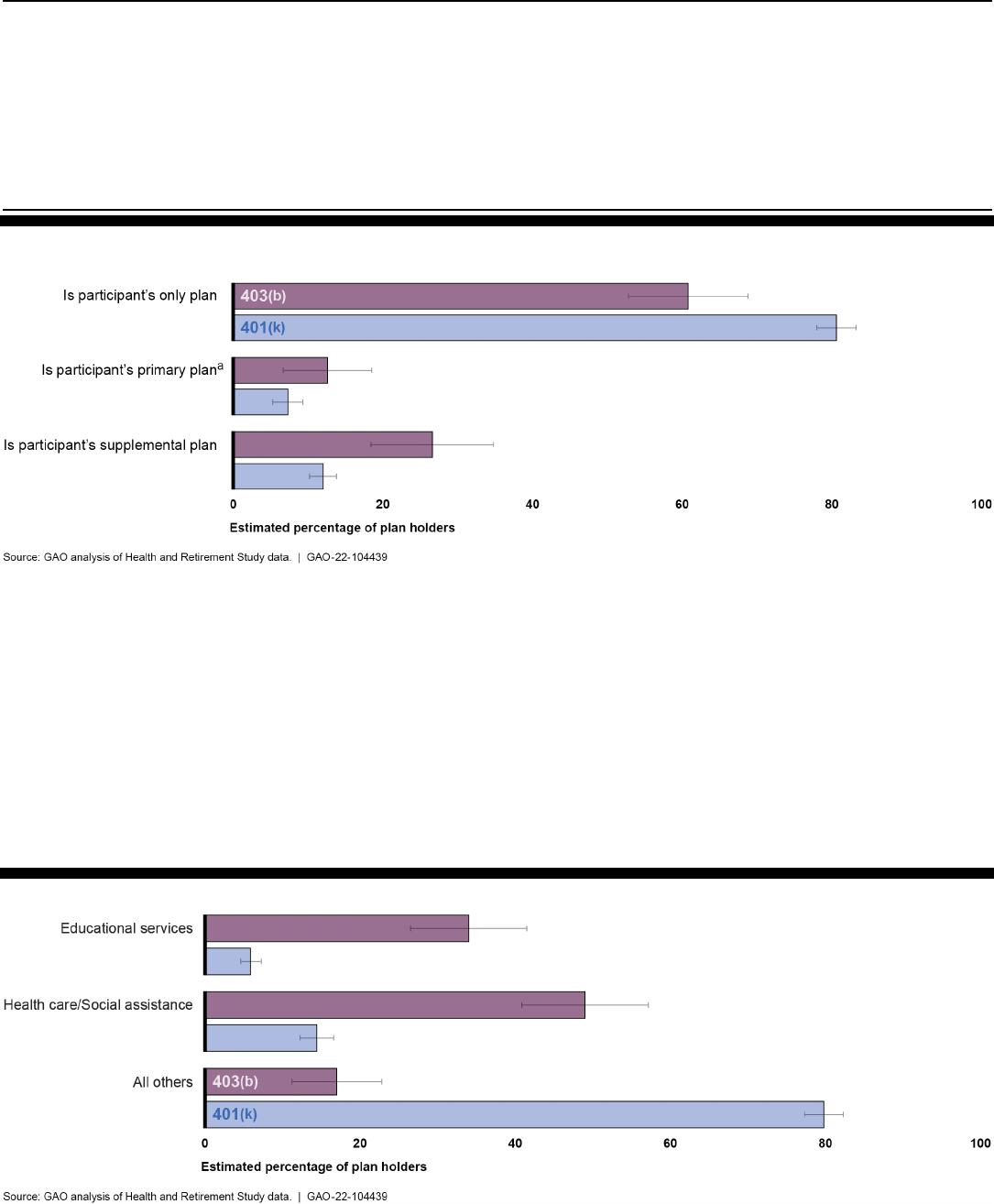
Appendix II: Detailed Findings from Analysis of
Health and Retirement Study Data
Page 64 GAO-22-104439 Defined Contribution Plans
Figure 10: Estimated Percentage of Individuals Who Reported Having a 403(b) or 401(k) Account as Their Only Plan, Primary
Plan, or Supplemental Plan, 2016
Note: By supplemental, we mean that the 403(b) or 401(k) plan does not have the largest reported
balance of multiple defined contribution plan types or if the respondent also reported a defined benefit
plan, e.g., the defined benefit plan is assumed to be primary. The estimated percentages and
associated margins of error at the 95 percent confidence level are as follows: 403(b) only plan, 60.9
percent +/-8.0 percent; 403(b) primary plan, 12.6 percent +/-5.9 percent; 403(b) supplemental plan,
26.5 percent +/- 8.2 percent; 401(k) only plan, 80.7 percent +/-2.6 percent; 401(k) primary plan, 7.3
percent +/-2.2 percent; 401(k) supplemental plan 12.0 percent +/-1.8 percent. 2016 is the most recent
year for which complete weighted Health and Retirement Study data are available.
a
The estimated difference for primary plans was not statistically significant at the 95 percent
confidence level.
Sector. We found that a higher percentage of 403(b) account holders
were in the education or health care and social assistance sectors,
compared to 401(k) retirement account holders (see fig. 11).
Figure 11: Estimated Percentage of Individuals Who Reported Having a 403(b) or 401(k) Account, by Employer’s Sector, 2016
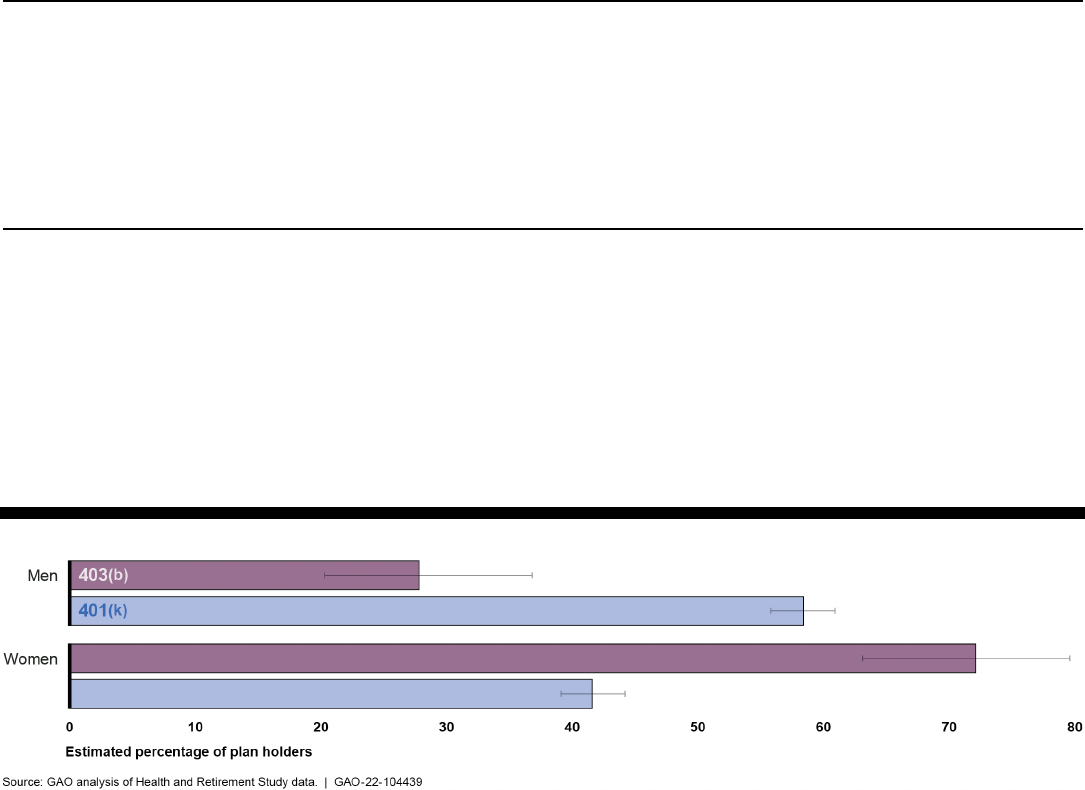
Appendix II: Detailed Findings from Analysis of
Health and Retirement Study Data
Page 65 GAO-22-104439 Defined Contribution Plans
Note: The estimated percentages and associated margins of error at the 95 percent confidence level
are as follows: 403(b) educational services, 34.0 percent +/-7.5 percent; 403(b) health care/social
assistance, 49.0 percent +/-8.2 percent; 403(b) all others, 17.0 percent +/- 5.8 percent; 401(k)
educational services, 5.8 percent +/-1.3 percent; 401(k) health care/social assistance, 14.4 percent
+/-2.2 percent; 401(k) all others, 79.8 percent +/- 2.5 percent. The Health and Retirement Study
follows the Census Occupational Classification System (Census) to identify a respondent’s industry.
We categorized as follows: educational services, Census code 14; health care and social assistance,
Census code 15; all others, Census codes 1-13, and 16-19. 2016 is the most recent year for which
complete weighted Health and Retirement Study data are available.
Gender. We found that a higher percentage of 403(b) account holders
were female, compared to 401(k) retirement account holders (see fig. 12).
Figure 12: Estimated Percentage of Individuals Who Reported Having a 403(b) or 401(k) Account, by Gender, 2016
Note: The estimated percentages and associated margins of error at the 95 percent confidence level
are as follows: 403(b) female, 72.0 percent +/-7.6 percent; 403(b) male, 28.0 percent +/-8.4 percent;
401(k) female, 42.6 percent +/-2.4 percent; 401(k) male, 57.4 percent +/-2.4 percent. 2016 is the
most recent year for which complete weighted Health and Retirement Study data are available.
Race. We estimated that 85 percent of 403(b) account holders were
White (see fig. 13). However, neither the estimated difference for this
group compared with 401(k) account holders for this estimate, nor our
estimated differences for 403(b) compared to 401(k) account holders for
Black or Other race categories were statistically significant at the 95
percent confidence level; as such, comparisons cannot reliably be made
for 403(b) account holders with 401(k) account holders by race.

Appendix II: Detailed Findings from Analysis of
Health and Retirement Study Data
Page 66 GAO-22-104439 Defined Contribution Plans
Figure 13: Estimated Percentage of Individuals Who Reported Having a 403(b) or 401(k) Account, by Race, 2016
Notes: None of these estimates were statistically significant at the 95 percent confidence level; as
such, no comparisons should be made between 403(b) and 401(k) account holders. The estimated
percentages and associated margins of error at the 95 percent confidence level are as follows: 403(b)
White, 84.8 percent +/-5.2 percent; 403(b) Black, 8.5 percent +/-3.6 percent; 403(b) other, 6.8 percent
+/-4.0 percent; 401(k) White, 81.1 percent +/-1.9 percent; 401(k) Black, 9.0 percent +/-1.6 percent,
401(k) other, 9.9 percent +/-2.2 percent.
a
HRS treats ethnicity separately from race; as such, Hispanic is not reported in these categories.
2016 is the most recent year for which complete weighted Health and Retirement Study data are
available.
Age. We estimated 17 percent of 403(b) account holders were 65 or older
(see fig. 14). Because neither of our estimated differences between
403(b) and 401(k) account holders by age were statistically significant at
the 95 percent confidence level, we cannot make comparisons with
401(k) account holders.
Figure 14: Estimated Percentage of Individuals Who Reported Having a 403(b) or 401(k) Account, by Age, 2016
Notes: None of these estimates were statistically significant at the 95 percent confidence level; as
such, no comparisons should be made between 403(b) and 401(k) account holders. The estimated
percentages and associated margins of error at the 95 percent confidence level are as follows: 403(b)
65 or older, 17.2 percent +/-6.0 percent; 403(b) under 65, 82.8 percent +/-6.0 percent; 401(k) 65 or
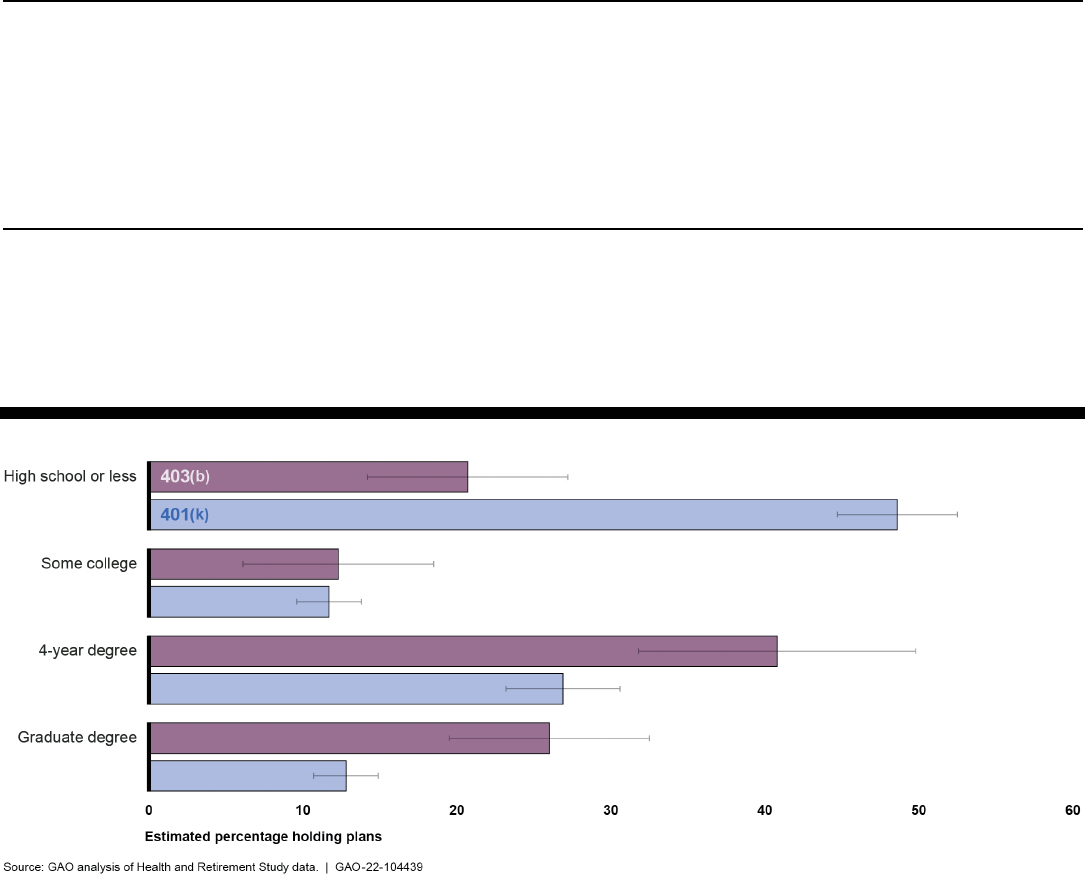
Appendix II: Detailed Findings from Analysis of
Health and Retirement Study Data
Page 67 GAO-22-104439 Defined Contribution Plans
older, 11.0 percent +/-1.9 percent; 401(k) under 65, 89.0 percent +/-1.9 percent. 2016 is the most
recent year for which complete weighted Health and Retirement Study data are available.
Education level. We found that a lower percentage of 403(b) account
holders had a high school diploma or less, compared to 401(k) retirement
account holders (see fig. 15).
Figure 15: Estimated Percentage of Individuals Who Reported Having a 403(b) or 401(k) Account, by Education Level, 2016
Note: We did not estimate a statistically significant difference at the 95 percent confidence level for
some college, 4-year degree, or graduate degree 403(b) and 401(k) account holders; as such, no
comparisons should be made between 403(b) and 401(k) account holders. The estimated
percentages and associated margins of error at the 95 percent confidence level are as follows: 403(b)
high school or less, 20.7 percent +/-6.5 percent; 403(b) some college, 12.4 percent +/-6.2 percent;
403(b) 4-year college degree, 40.9 percent +/-9.0 percent; 403(b) graduate degree, 26.1 percent +/-
6.5 percent; 401(k) high school or less, 48.6 percent +/-3.9 percent; 401(k) some college, 11.7
percent +/-2.1 percent, 401(k) 4-year college degree, 26.9 percent +/-3.7 percent; 401(k) graduate
degree, 12.8 percent +/-2.1 percent. 2016 is the most recent year for which complete weighted Health
and Retirement Study data are available.
Household assets. We found that a higher percentage of 403(b) account
holders had $300,000 or more in household assets, compared to 401(k)
retirement account holders (see fig. 16).

Appendix II: Detailed Findings from Analysis of
Health and Retirement Study Data
Page 68 GAO-22-104439 Defined Contribution Plans
Figure 16: Estimated Percentage of 403(b) Retirement Accounts’ Respondents Reported Household Assets, Compared to
401(k) Account Holders, 2016
Note: The estimated percentages and associated margins of error at the 95 percent confidence level
are as follows: 403(b) less than $300,000 household assets, 40.7 percent +/-9.6 percent; 401(k) less
than $300,000 household assets, 52.1 percent +/-4.3 percent; 403(b) $300,000 or more household
assets, 59.3 percent +/-9.6 percent; 401(k) $300,000 or more household assets, 47.9 percent +/-4.3
percent. 2016 is the most recent year for which complete weighted Health and Retirement Study data
are available.
Earnings. We found that a higher percentage of 403(b) account holders
earned between $50,000 and $100,000 per year, and were less likely to
be earning less than $50,000 per year, compared to 401(k) retirement
account holders (see fig. 17).
Figure 17: Estimated Percentage of 403(b) Retirement Accounts’ Respondents Reported Earnings, Compared to 401(k)
Account Holders, 2016
Note: The estimated percentages and associated margins of error at the 95 percent confidence level
are as follows: 403(b) $100,000 or more earnings, 28.1 percent +/-8.3 percent; 401(k) $100,000 or
more earnings, 27.0 percent +/-3.5 percent; 403(b) $50,000 to $100,000 earnings, 44.9 percent +/-7.2
percent; 401(k) $50,000 to $100,000 earnings, 35.2 percent +/-3.3 percent; 403(b) less than $50,000
earnings, 27.0 percent +/-6.6 percent; 401(k) less than $50,000 earnings, 37.8 percent +/-2.7 percent.
2016 is the most recent year for which complete weighted Health and Retirement Study data are
available.

Appendix II: Detailed Findings from Analysis of
Health and Retirement Study Data
Page 69 GAO-22-104439 Defined Contribution Plans
a
The estimated difference for earnings of $100,000 or more was not statistically significant at 95
percent confidence level.

Appendix III: Detailed Data on Fees from
Surveys of 403(b) Plan Sponsors and Service
Providers
Page 70 GAO-22-104439 Defined Contribution Plans
As noted earlier, we obtained data on fees through non-generalizable
surveys of 403(b) plan sponsors and service providers.
1
The tables below
show the data provided by each survey participants—a total of 26 plan
sponsors and 19 service providers—that reported data to us. Although it
is not comprehensive or representative of the general population, it
provides examples of the types and amounts of fees paid by 403(b) plan
sponsors. Table 5 shows reported types and amounts of fees paid by
403(b) plan sponsors. Table 6 shows reported types and amounts of fees
charged by 403(b) service providers.
Table 5: Retirement Plan Participant Counts, Assets, Numbers of Plan Investment Options, and Range of Fees and Expenses
for Plan Sponsors Surveyed by GAO
Description of
entity
Number of
plan
participants
a
Total 403(b) plan
assets (rounded
to nearest $1
million)
Number of
investment
options in
plan
Reported
recordkeeping
and
administrative
expenses
b
Other reported plan
expenses
Investment
option ex
pense
ratio range
(percentage)
c
State-
Sponsored
Plan A
33
3,000,000
21
0.06%
Wrap fees: 0.30%/year
0.02 – 0.88
State-
Sponsored
Plan B
8,775
1,146,000,000
26
0.0285%
Retirement Plan
Consultant:
$16,150/year; Other
Service Fees:
$5,000/year
0.02 – 0.76
State-
Sponsored
Plan C
13,800
492,000,000
14
0.0008%
Retirement Plan
Consultant:
$80,000/year;
Audit/Legal Fees:
$30,000/year
0.04 – 0.86
State-
Sponsored
Plan D
9,400
956,000,000
22
0.021%
Retirement Plan
Consultant:
$26,250/year; Other
Service Fees:
$5,000/year;
Investment
Management Fee:
0.35%/year (plan
reported average)
0.02 – 1.10
1
For the purposes of this report, we refer to all such record keepers, third-party
administrators, vendors, and others who provide administrative services to a plan as
403(b) service providers.
Appendix III: Detailed Data on Fees from
Surveys of 403(b) Plan Sponsors and
Service Providers
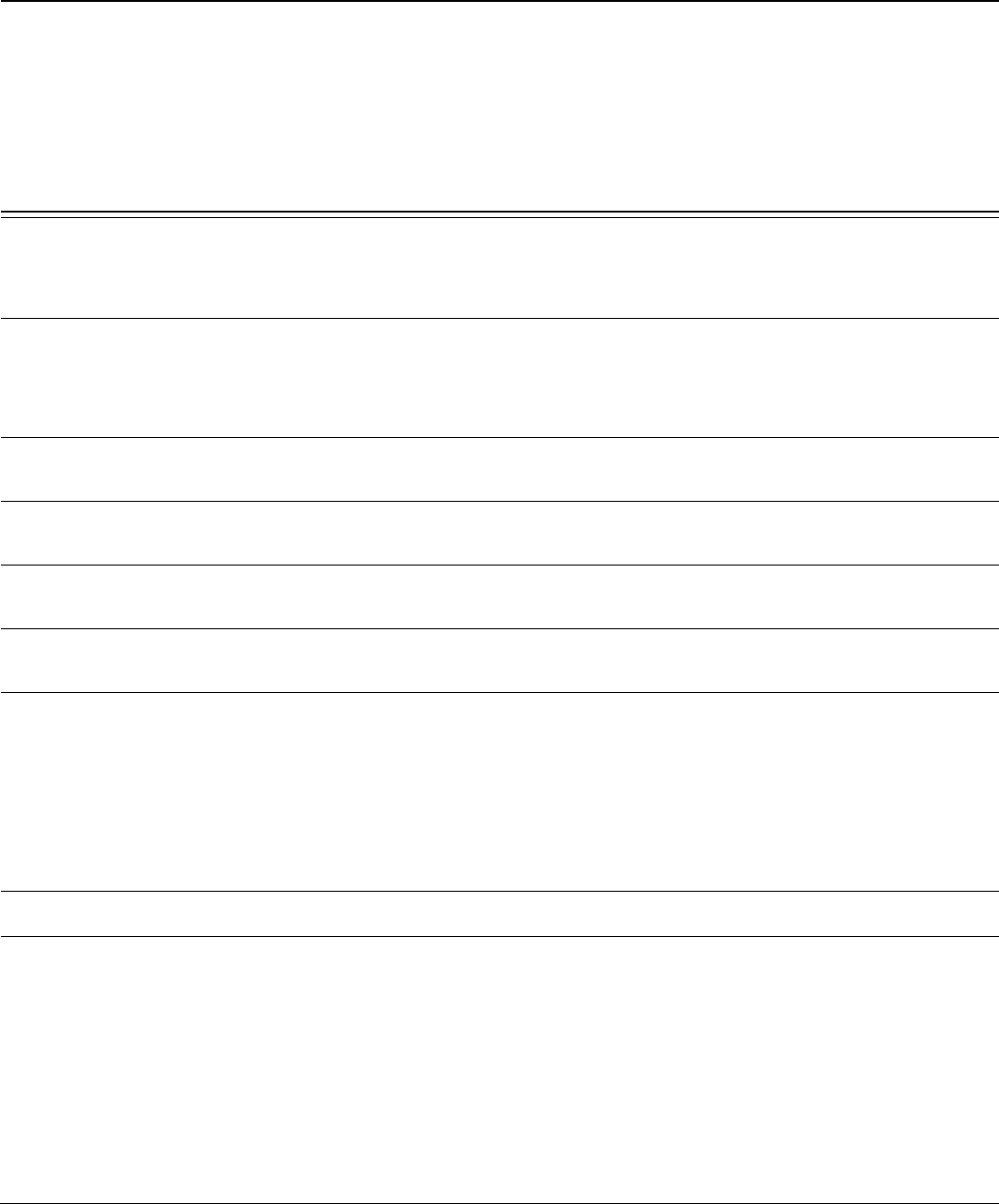
Appendix III: Detailed Data on Fees from
Surveys of 403(b) Plan Sponsors and Service
Providers
Page 71 GAO-22-104439 Defined Contribution Plans
Description of
entity
Number of
plan
participants
a
Total 403(b) plan
assets (rounded
to nearest $1
million)
Number of
investment
options in
plan
Reported
recordkeeping
and
administrative
expenses
b
Other reported plan
expenses
Investment
option ex
pense
ratio range
(percentage)
c
State-
Sponsored
Plan E
31,694
4,680,000,000
64
0 – 0.12%
Retirement Plan
Consultant:
$50,500/year;
Investment
Management Fees:
0.39 –
0.44% annually;
0.04 – 1.12
State-
Sponsored
Plan F
818
103,000,000
15
0.075%
State Board Fees,
0.045%/year
0.02 – 0.78
State-
Sponsored
Plan G
1,957
238,000,000
10
0.08%
Retirement Plan
Consultant:
$163,000/year
0.04 – 1.13
State-
Sponsored
Plan H
2,870
144,000,000
11
0.14%
DNR
0.04 – 0.63
Public
University Plan
A
315,000
22,000,000,000
15
DNR
Investment
Management:
0.04%/year
0.01 – 0.48
Large School
District
97,000
37,000,000,000
7
DNR
Retirement Plan
Consultant:
$2,795,000/year; Other
Service Fees:
$1,259,000/year;
Investment
Management Fee:
$105,474,000/year;
Transaction Costs:
$11,868,000/year
0.15 – 0.48
Large State
University Plan
43,200
6,300,000,000
42
d
0.035%
Legal Counsel:
$22,000/year
0.02 – 1.58
Religious
Organization
415
140,000,000
10
0.27%
Retirement Plan
Consultant:
$600,000/year;
Actuarial Consulting
Fees, $484,600/year;
Investment
Management Fees,
0.32%/year;
Investment Advisory
Fees,
$874,000/year;
Excess Commission,
0.003%/year;
Trading/Transaction
Costs, 0.02%/year;
0.30 – 0.76

Appendix III: Detailed Data on Fees from
Surveys of 403(b) Plan Sponsors and Service
Providers
Page 72 GAO-22-104439 Defined Contribution Plans
Description of
entity
Number of
plan
participants
a
Total 403(b) plan
assets (rounded
to nearest $1
million)
Number of
investment
options in
plan
Reported
recordkeeping
and
administrative
expenses
b
Other reported plan
expenses
Investment
option ex
pense
ratio range
(percentage)
c
Non-Profit
Organization
23
1,160,000
33
0.18%
Investment
Management Fees,
$2,022/year
DNK
Large School
District
57,600
3,194,000,000
DNK/35
a
0.018%
DNR
DNK/ 0.21 –
1.25
e
State-
Sponsored
Plan J
21,287
1,456,000,000
21
0.18%
DNR
0.02 – 1.19
Small School
District
2
DNK
DNK
DNK
DNK
DNK
Large School
District
19,637
783,000,000
DNK/20
e
DNR
DNR
DNK/0.06 –
2.37
e
Large School
District
21,000
872,000,000
DNK/14
e
DNR
DNK/0.06-1.76
e
Large School
District
20,831
694,000,000
DNK
0.072%
DNR
DNK
Non-Profit
Organization
81
701,000
48
DNK
Investment
Management Fees,
0.00-
0.93%/year;
12(b)(1) Fees, 0.00-
0.25%/year; Other
Expenses: 0.00-
0.46%/year: Acquired
Fee
Funds and
Expenses: 0.00-
0.77%/year; Expense
Waivers or
Reimbursements: 0.00-
0.30%/year; Net
Separate Account Fee:
0.75-
1.25%/year; Net
Compensation: 0.06-
0.43%/year
0.12 -1.23
Large School
District
15,000
1,345,000,000
30
DNK
DNR
DNK
Non-Profit
Organization
27
2,300,000
23
0.51 – 2.01%
DNR
0.51% - 1.93%
State-
Sponsored
Plan K
14,476
1,225,000,000
33
DNR
DNR
DNK
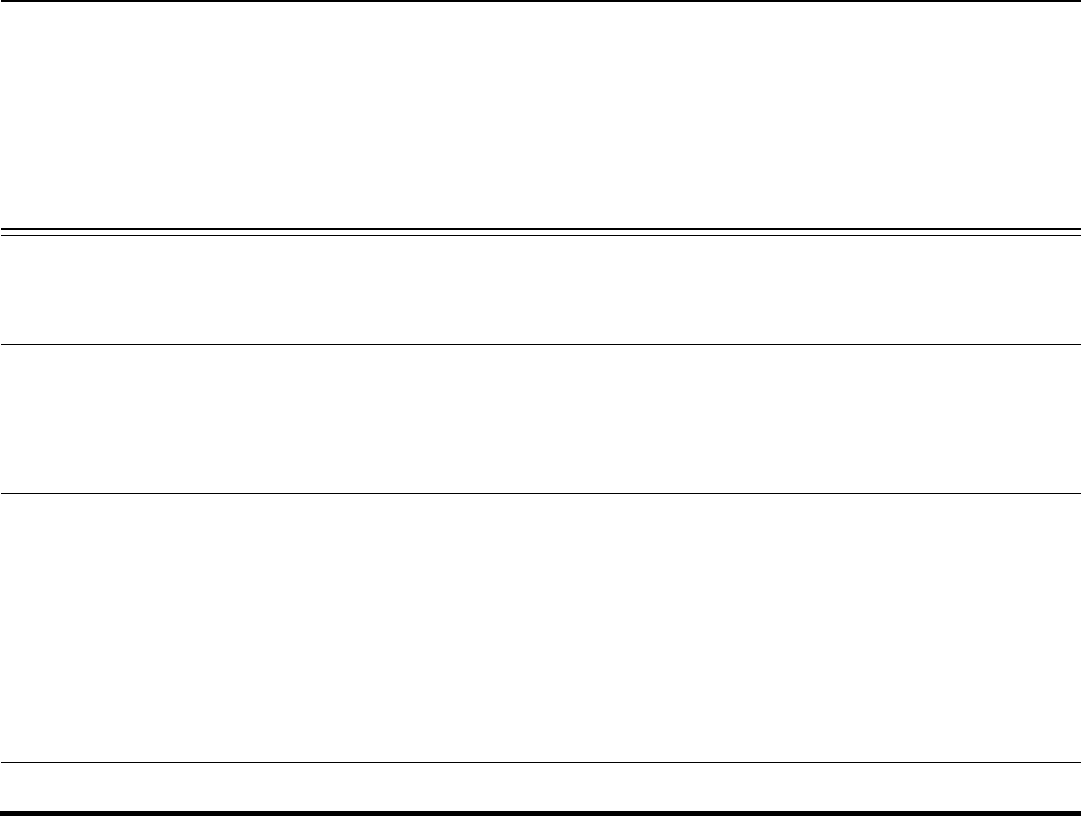
Appendix III: Detailed Data on Fees from
Surveys of 403(b) Plan Sponsors and Service
Providers
Page 73 GAO-22-104439 Defined Contribution Plans
Description of
entity
Number of
plan
participants
a
Total 403(b) plan
assets (rounded
to nearest $1
million)
Number of
investment
options in
plan
Reported
recordkeeping
and
administrative
expenses
b
Other reported plan
expenses
Investment
option ex
pense
ratio range
(percentage)
c
Non-Profit
Organization
222
13,700,000
28
0.145%
Retirement Plan
Consultant: 0.2%/year;
Audit Fees:
$12,000/year;
Investment
Management Fee:
0.4%/year
0.21 – 1.14
Large School
District
13,800
725,000,000
52
0.16 – 0.25%
Retirement Plan
Consultant:
0.03%/year;
Investment
Management Fee:
0.45%/year (0.15% if
account >$300K);
Investment Advisory
Fees: $500 plus
$100/year;
Trading/Transaction
Costs: $2/month or $25
for brokerage account
0.13 – 1.50
Non-Profit
Organization
12
474,915
DNR
DNR
DNR
DNK
Legend: DNK – Responded “Did Not Know”
DNR – Did not respond to this survey question; left blank
Source: GAO analysis of information collected from survey responses of state-sponsored, large, school, or small plan sponsors. | GAO-22-104439
Note: Information contained in this table came from a total of 26 survey responses that we received
from 403(b) plan sponsors. Duplicate counting of participants is possible in that some of the 403(b)
service providers that responded to our survey may be providing services to plan sponsors that
responded to our plan sponsor survey. We did not collect data to test for this possibility.
a
Plan participants include active participants who are currently contributing to the plan and inactive
participants who are no longer contributing to the plan.
b
Some respondents reported record keeping and administrative expenses as a percentage of total
assets on an annual basis. Other respondents reported those expenses in a dollar amount per year,
while others reported those expenses on a per participant basis per year. This column harmonizes
those numbers and expresses them as a percentage of total assets on an annual basis. Some
respondents instead reported a range of record keeping and administrative expenses per year and
we present those ranges as a percentage of total assets on an annual basis.
c
An expense ratio measures how much of a fund’s assets are used for administrative and other
operating expenses. An expense ratio is determined by dividing a fund’s operating expenses by the
average dollar value of its assets under management. Operating expenses reduce the fund’s assets,
thereby reducing the return to investors.
d
Plan sponsor reported this was an average across four platforms. The sponsor noted that its
program is based on annuities, so every participant has a direct account with its four investment
providers. As a result of this setup, the plan is unable to map assets, and while it has worked to
decrease the number of options to new participants to about 40, it unable to close accounts that are
invested in the legacy options. As such, other information provided by the plan sponsor showed the
total number of investment options for the plan was 216.
e
This survey respondent reported it did not know the number of investments in its plan or the expense
ratios associated with them; we found it elsewhere in statewide publicly available information.

Appendix III: Detailed Data on Fees from
Surveys of 403(b) Plan Sponsors and Service
Providers
Page 74 GAO-22-104439 Defined Contribution Plans
f
This plan sponsor reported an investment option with an expense ratio of zero, but we found that it
was a type of annuity investment whose fees would not be expressed in terms of expense ratio.
Table 6: 403(b) Retirement Plan Participant Counts, Total Assets, and Range of Fees and Expenses for 403(b) Service
Providers Surveyed by GAO
Description
of entity
(method of
obtaining
information /
source)
Number
of plans
Total
number of
participants
403(b) plan
assets (rounded
to nearest
$million)
Plan administrative expense
(specify type, and yearly,
quarterly)
Reported
direct and
indirect
fees
charged
range
Smallest and largest
example plans’
investment option
expense ratio
management fee range
Record
Keeper
1,671
204,277
14,427,000,000
Record keeping and
Administrative Fee:
$28,000,000/year; Investment
Advisory Fee: $991,000/year;
Other Fees (Loan Issue Fee,
Loan Maintenance Fee,
Locator Service Fee,
Mandatory Cash-
Out Fee,
Participant Maintenan
ce Fee,
Qualified Domestic Relations
Order Fee), $825,000/year
Direct Fees:
0.00 – 0.43
percent;
Indirect
Fees: 0.00 –
0.25 percent
Plans with <=$1 million
assets: .8%
Plan with >$1 billion
assets:$.5% 0.50 -
0.80%
Record
Keeper/Third-
Party
Administrator
442
161,776
4,839,000,000
Record keeping or
Administrative Fee: $4.50 per
participant/quarter
Other Fees: varies by vendor
and product
Direct Fees:
0.00 – 0.40
percent;
Indirect
Fees: 0 -
$24 fixed fee
for year
a
0.04 – 0.89%
Product
Vendor
DNR
15,269
1,100,000,000
Wrap Fees: 2.10 percent/year
DNK
DNR
Record
Keeper
23,369
4,890,068
498,063,000,000
DNK
DNK
Plans with <=$1million in
assets: 0.42 – 0.50%
Plans with >$1billion in
assets: 0.19 – 0.34%
Record
Keeper
91
347,360
33,566,000,000
DNK
DNK
Plans with <=$1 million
in assets: 0.14-25%
Plan with >$1 billion in
assets: 0.14%
Record
Keeper
840
3,345,922
289,973,000,000
DNR
DNK
DNR
Investment
Advisor
14
DNK
20,375,000,000
DNK
DNK
DNR

Appendix III: Detailed Data on Fees from
Surveys of 403(b) Plan Sponsors and Service
Providers
Page 75 GAO-22-104439 Defined Contribution Plans
Description
of entity
(method of
obtaining
information /
source)
Number
of plans
Total
number of
participants
403(b) plan
assets (rounded
to nearest
$million)
Plan administrative expense
(specify type, and yearly,
quarterly)
Reported
direct and
indirect
fees
charged
range
Smallest and largest
example plans’
investment option
expense ratio
management fee range
Product
Vendor
5,232
307,386
9,360,000,000
Administrative Charge:
$100/plan/month, plus $1-
4/participant/month
(depending on number of
participants), and includes
0.22% standard record
keeping expense; Account
Expenses: 0.25-
1.65%
(depending on account size);
DNK
a
0.39-2.40
Record
Keeper
1,157
57,141
2,300,000,000
DNK
DNK
DNR
Record
Keeper
6,000
100,000
6,500,000,000
Record Keeping and
Administrative Fees:
0.015%/year
Other Fees: $40/year
Direct Compensation: 5-
21
bps; Indirect Compensation: 0-
50 bps
Direct Fees:
0.05 – 0.21
percent;
Indirect
Fees: 0 –
0.50 percent
DNK
Product
Vendor
11,993
115,792
6,995,000,000
$30 maintenance fee per
participant/year for accounts
under $50,000; Transfer Agent
Fee of
$17.60/shareholder/year +
asset-based fee of .01%-
.03%/year, depending on
investment option;
Contingent
Deferred Sales Charge of 0-
1%; Front End Sales Load 0 –
5.50%; Processing Fees $20
($75 for Loan Initiation)
DNR
a
0.40 – 3.92
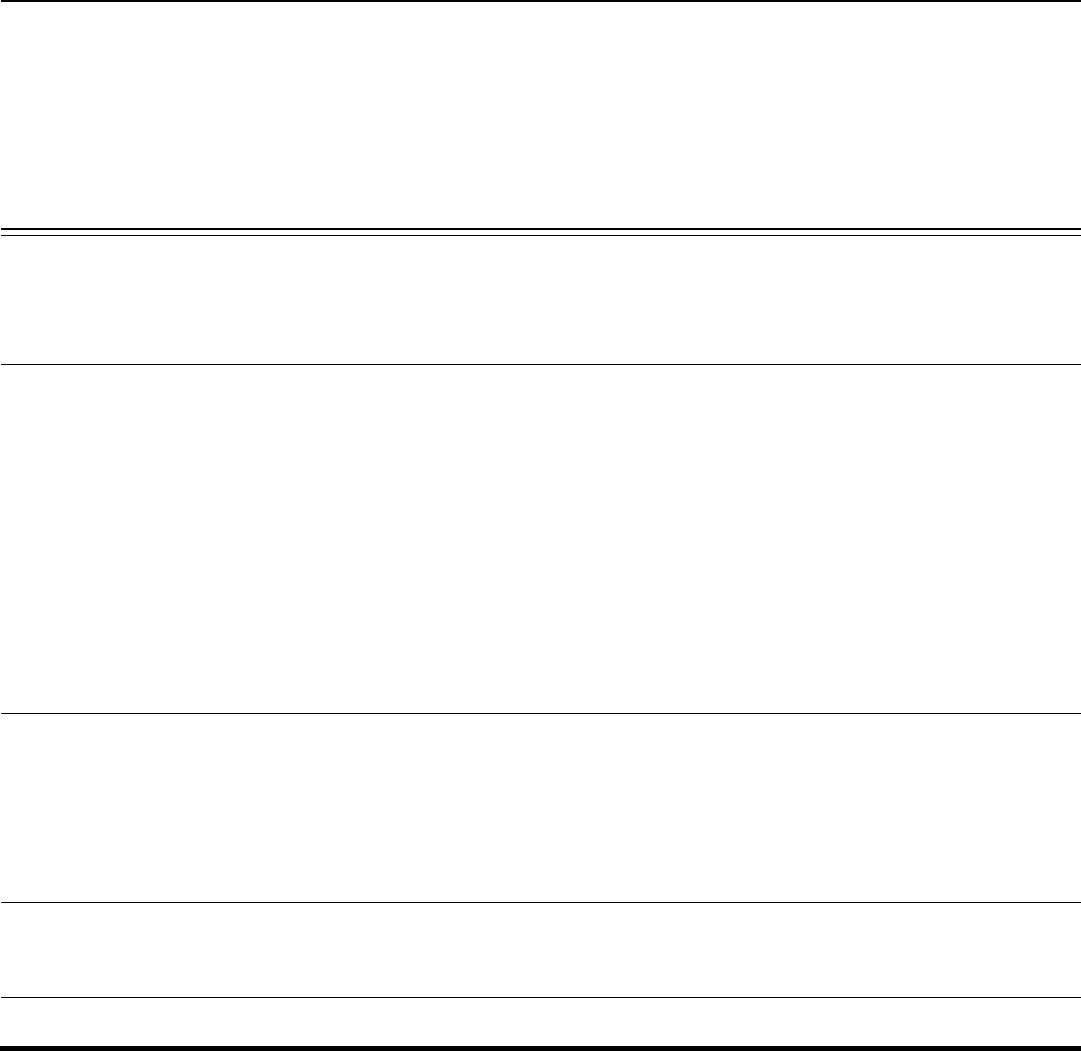
Appendix III: Detailed Data on Fees from
Surveys of 403(b) Plan Sponsors and Service
Providers
Page 76 GAO-22-104439 Defined Contribution Plans
Description
of entity
(method of
obtaining
information /
source)
Number
of plans
Total
number of
participants
403(b) plan
assets (rounded
to nearest
$million)
Plan administrative expense
(specify type, and yearly,
quarterly)
Reported
direct and
indirect
fees
charged
range
Smallest and largest
example plans’
investment option
expense ratio
management fee range
Record
Keeper
5,032
190,150
8,055,000,000
Administrative Service Fee: $0
– $1250/year; Per Participant
Fee: $0 -
$20/year; Minimum
Contribution Fee: $0 -
$1000/year; Contribution
Census System Non-
Usage
Fee: $1,000/year;
Administrative/Record keeping
Work: $100/hour; Advanced
Plan Compliance Work:
$200/hour; Special Plan
Services: $1000/event ;
Distribution,
$40/part
icipant/year; Loan
Initiation: $75/participant/year;
Loan Administration:
$24/participant/year
Direct Fees:
0 – 1.25
percent
Indirect
Fees: None
a
0.02 – 1.75 percent
Record
Keeper
2,031
368,276
18,808,000,000
For plans under $1M, charges
can be 0.4% or 0.5% plus a
flat fee of $2,600 and a $25
per participant fee. For most
plans with assets in excess of
$1million, we calculate a
record keeping fee that is
customized to the client based
on many factors.
DNK
Plan
s with <=$1 million
in assets: 1.21 - 1.95%
Plan with >$1 billion in
assets: $0.24%
Record
Keeper
1,125
328,494
23,529,000,000
DNK
DNK
Plans with <=$1 million
in assets: 0.06 – 0.66%
Plans with >$1 billion in
assets: 0.18 – 0.36%
Third-Party
Administrator
5,219
1,330,376
97,000,000,000
$24/year/account, plus
$36/participant
DNR
DNR
Legend: DNK – Responded “Did Not Know”
DNR – Did not respond to this survey question; left blank
Source: GAO analysis of information collected from survey responses of 403(b) service providers. | GAO-22-104439
Note: Information in this table came from 15 survey responses we received from 403(b) service
providers. Four other service providers who responded to our survey requested we not include this
information in this appendix. For the purposes of this report, we will refer to all such record keepers,
third-party administrators, vendors, and others who provide administrative services to a plan as
403(b) service providers.
a
The expense ratio information provided by this service provider represents the actual high and low
annual expense ratio management fee charged by this plan; it is not reported for selected plans only.

Appendix IV: Reported Surrender Fees and
Short-Term Trading Fees by 403(b) Plan
Sponsors and Service Providers Surveyed
Page 77 GAO-22-104439 Defined Contribution Plans
As we reported earlier, we obtained data on fees through surveys of
403(b) plan sponsors and service providers.
1
We received responses
from a total of 26 plan sponsors and 19 service providers. Surrender fees
are fees charged for selling or withdrawing money from an investment
before a set period of time. Individual schedules for the phase out period
vary by specific plan, but generally involve a reduction of 1 to 2 percent
per year until the surrender fee is no longer charged. For example, an
annuity with a 10-year, 10 percent surrender fee would charge 10 percent
the first year to cancel plan participation, 9 percent the second year, and
so on, until there is no surrender fee charged after the 10-year period.
Short-term trading fees are fees charged to an investor when shares are
sold from a fund, and typically are only applied within a certain time
frame, in order to discourage short-term trading.
Tables 7 and 8 below show the data provided by each survey respondent
that reported data to us. The data presented are not comprehensive or
representative of the general population. Table 7 shows the surrender
fees for any annuities in plans as reported by 403(b) plan sponsor
respondents.
Table 7: Summary of Surrender Fee Information Obtained From Plan Sponsor Survey Respondents
Surrender fee status
Survey respondents
Surrender fees
7 of 26 plan sponsors that reported some of the investment options contained in their plans that
charge a surrender fee:
Respondent #1: 10% of annuities have surrender fees, with a maximum of 2% and phase out
period of 0.5 years
Respondent #2: 5% of annuities have surrender fees, with a maximum of 5% and phase out
period of 5 years
Respondent #3: 90% of annuities have surrender fees, with a maximum of 5% and phase out
period of 7 years.
Respondent #4: 90% of annuities have surrender fees, with a maximum of 5% and phase out
period of 7 years.
Respondent #5: 60% of annuities have surrender fees, with a maximum of 10% and phase out
period of 6 years. [Note: This plan sponsor also reported that the plan does not currently offer
annuities.]
Respondents #6 and #7 reported that their assets contain annuities subject to surrender fees, but
not know the details about those fees.
No surrender fees
9 of 26 plan sponsors reported that their assets do not contain annuities, and no assets are
subject to surrender fees.
1
For the purposes of this report, we refer to all such record keepers, third-party
administrators, vendors, and others who provide administrative services to a plan as
403(b) service providers.
Appendix IV: Reported Surrender Fees and
Short-Term Trading Fees by 403(b) Plan
Sponsors and Service Providers Surveyed
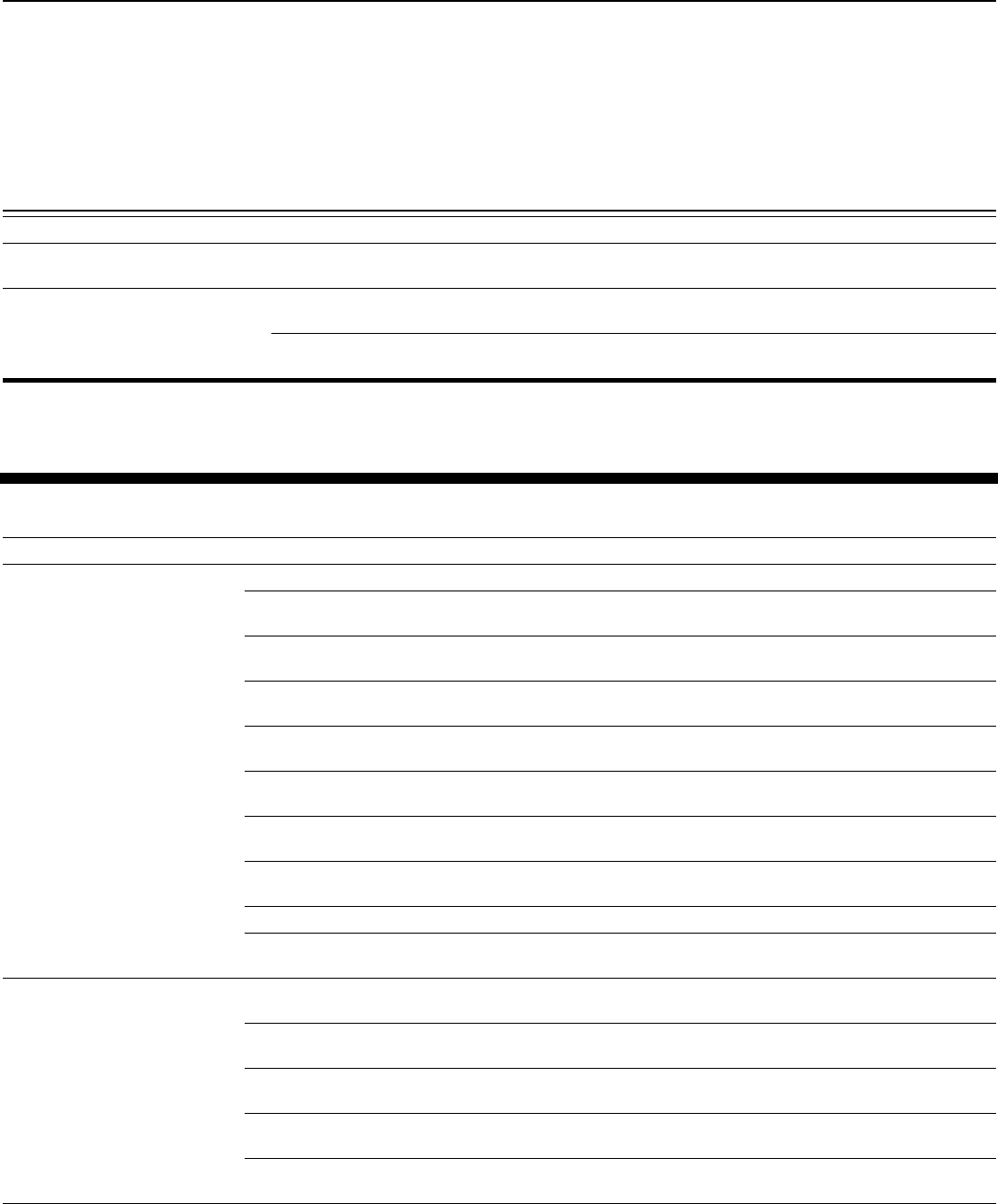
Appendix IV: Reported Surrender Fees and
Short-Term Trading Fees by 403(b) Plan
Sponsors and Service Providers Surveyed
Page 78 GAO-22-104439 Defined Contribution Plans
Surrender fee status
Survey respondents
4 of 26 plan sponsors reported that their assets contain either fixed or variable annuities, but that
those assets are not subject to surrender fees.
Do not know
4 of 26 plan sponsors reported that their assets contain annuities, but did not know whether or
not their assets carried surrender fees.
2 of 26 plan sponsors reported not knowing whether they had annuities, or whether they had
assets that carried a surrender fee.
Source: GAO analysis of survey data. l GAO-22-104439
Table 8: Summary of Surrender and Short-Term Trading Fee Information Obtained From 403(b) Service Provider Survey
Respondents
Surrender fee status
Survey respondents
Surrender fees
10 of 19 service providers reported the plans they provide services to charge surrender fees.
Respondent #1: 75% of annuities have such surrender fees, with a maximum of 10% and phase out
period of 10 years.
Respondent #2: 100% of annuities have such fees charges, with a maximum of 7% and phase out
period of 5 years.
Respondent #3: 7% of annuities have such surrender fees, with a maximum of 6% and phase out
period of 15+ years.
Respondent #4: 90% of annuities have such surrender fees, with a maximum of 5% and phase out
period of 6 years.
Respondent #5: 14% of such products have such surrender charges, with a maximum of 10% and
phase out period of 10 years.
Respondent #6: 100% of annuities have such surrender charges, with a maximum of 5% and phase
out period of 1 year.
Respondent #7: 18% of such products have surrender charges with a maximum of 5% and a phase
out period of 5 years.
Respondent #8: 28% of annuities carry surrender fees, otherwise unspecified.
Respondents #9: and #10 Reported that some annuity products carried surrender charges, but did
not specify the percentage of such annuities or their terms.
Short-term trading fees
6 of 19 record keepers reported the plans they provide services to charge short-term trading fees for
mutual funds.
Respondent #7 (Same as #7 above) Reported that less than 1% of mutual fund products have short-
term trading fees, with a maximum of 2% and a phase out period of 6 months.
Respondent #8 (Same as #8 above) Reported that 29% of mutual fund products have short-term
trading charges, but did not specify their terms.
Respondents #9 and #10: (Same as #9 and #10 above) Reported that some mutual fund products
carried short-term trading charges, but did not specify the percentage of such products or their terms.
Respondent #11: 2% of mutual fund products have short-term trading charges, with a maximum of
1%; this respondent did not specify the phase out period.
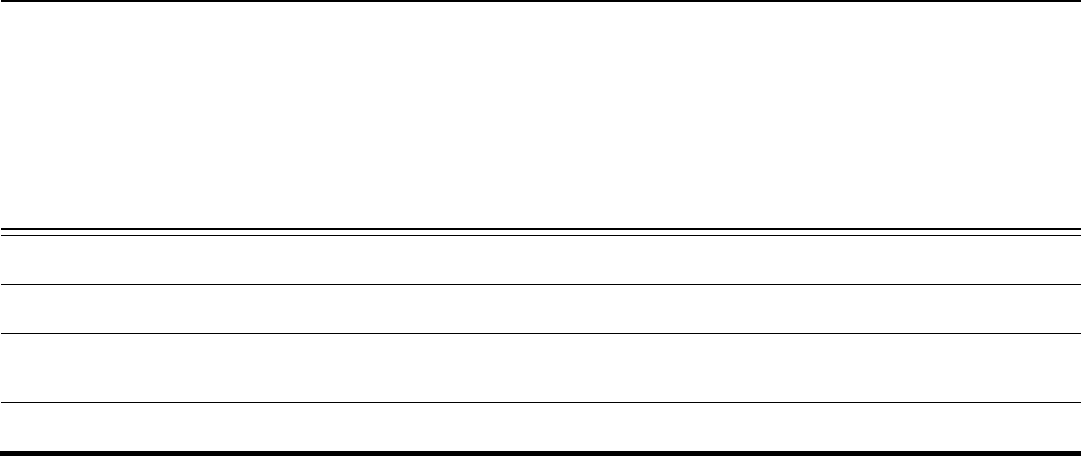
Appendix IV: Reported Surrender Fees and
Short-Term Trading Fees by 403(b) Plan
Sponsors and Service Providers Surveyed
Page 79 GAO-22-104439 Defined Contribution Plans
Respondent #12: 1% of mutual fund products have short-term trading charges, with a maximum of
1% and a phase out period of 1 year
Either surrender or short-term
trading fees
2 of 19 service providers reported that some of the investment options carried either surrender fees
or short-term trading fees, but neither respondent provided further details.
No surrender fees
5 record keepers who did not report charging surrender fees, including 3 of 19 service providers
reported not charging surrender fees or short-term trading fees; and 2 of 18 record keepers reported
charging short-term trading fees but not surrender fees.
Do not know
2 of 19 service providers reported that they did not know whether any of the investment options in
the plans for which they provided services carried either surrender or short-term trading fees.
Source: GAO analysis of survey data. l GAO-22-104439
Note: For the purposes of this report, we refer to all such record keepers, third-party administrators,
vendors, and others who provide administrative services to a plan as 403(b) service providers.
Responses do not sum to 19 because some respondents were included in two or more categories.

Appendix V: GAO Contact and Staff
Acknowledgements
Page 80 GAO-22-104439 Defined Contribution Plans
In addition to the individual named above, Sharon Hermes (Assistant
Director), Michelle Munn (Analyst in Charge), Andrew Bellis, Abigail
Loxton, Dae Park, and Timothy Young made key contributions to this
report. James Bennett, Ramona Burton, Nancy Cosentino, Justin Fisher,
Joseph Maher, Michael Naretta, Jessica Orr, Elizabeth Spurgeon,
Alexandra Squitieri, Rachel Stoiko, Frank Todisco, Walter Vance, and
Adam Wendel also provided support.
Appendix V: GAO Contact and Staff
Acknowledgements
GAO Contact
Staff
Acknowledgments
(104439)
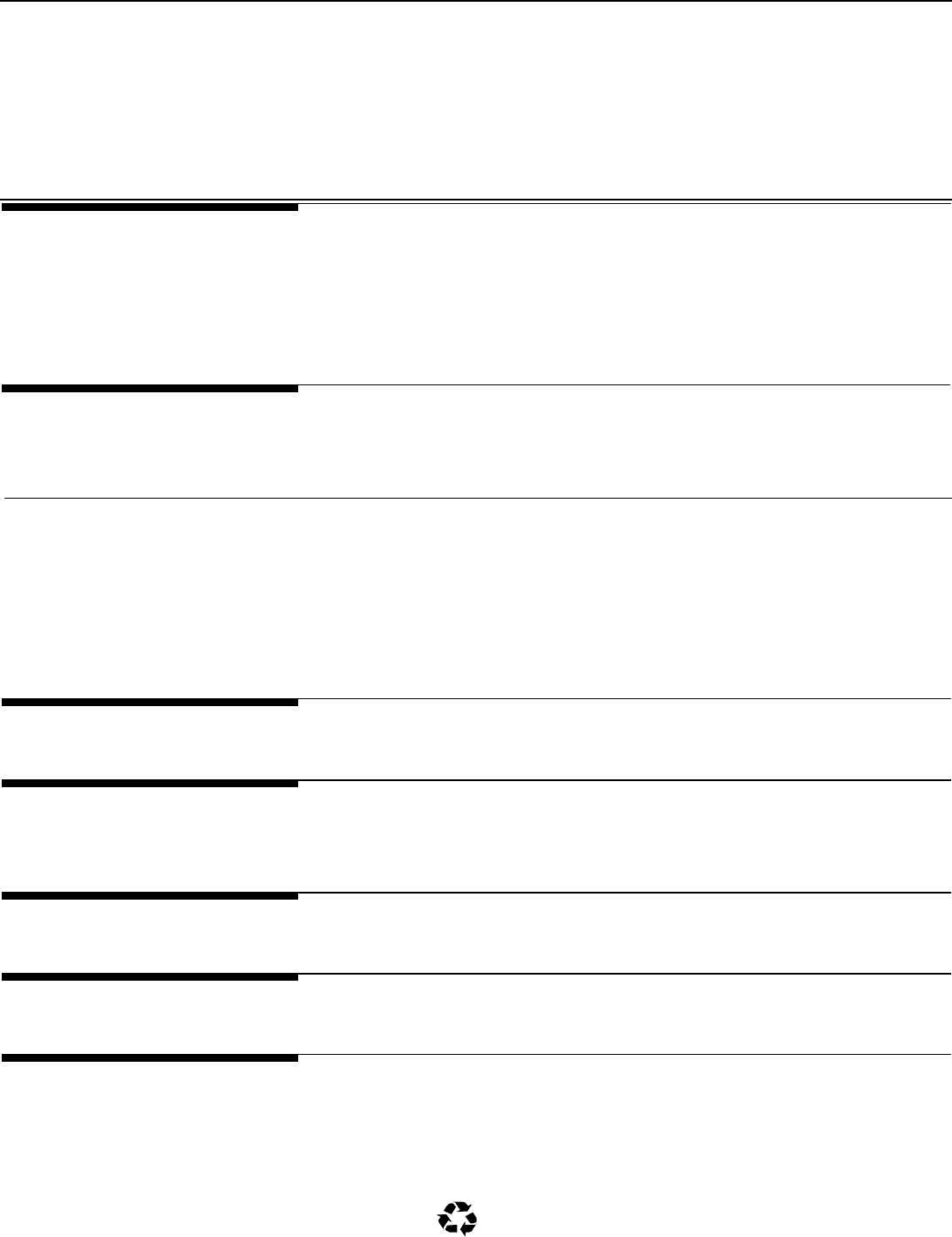
The Government Accountability Office, the audit, evaluation, and investigative
arm of Congress, exists to support Congress in meeting its constitutional
responsibilities and to help improve the performance and accountability of the
federal government for the American people. GAO examines the use of public
funds; evaluates federal programs and policies; and provides analyses,
recommendations, and other assistance to help Congress make informed
oversight, policy, and funding decisions. GAO’s commitment to good government
is reflected in its core values of accountability, integrity, and reliability.
The fastest and easiest way to obtain copies of GAO documents at no cost is
through our website. Each weekday afternoon, GAO posts on its website newly
released reports, testimony, and correspondence. You can also subscribe to
GAO’s email updates to receive notification of newly posted products.
The price of each GAO publication reflects GAO’s actual cost of production and
distribution and depends on the number of pages in the publication and whether
the publication is printed in color or black and white. Pricing and ordering
information is posted on GAO’s website, https://www.gao.gov/ordering.htm.
Place orders by calling (202) 512-6000, toll free (866) 801-7077, or
TDD (202) 512-2537.
Orders may be paid for using American Express, Discover Card, MasterCard,
Visa, check, or money order. Call for additional information.
Connect with GAO on Facebook, Flickr, Twitter, and YouTube.
Subscribe to our RSS Feeds or Email Updates. Listen to our Podcasts.
Visit GAO on the web at https://www.gao.gov.
Contact FraudNet:
Website:
https://www.gao.gov/about/what-gao-does/fraudnet
Automated answering system: (800) 424-5454 or (202) 512-7700
A. Nicole Clowers, Managing Director, [email protected], (202) 512-4400, U.S.
Government Accountability Office, 441 G Street NW, Room 7125, Washington,
DC 20548
U.S. Government Accountability Office, 441 G Street NW, Room 7149
Washington, DC 20548
Stephen J. Sanford, Managing Director, [email protected], (202) 512-4707
U.S. Government Accountability Office, 441 G Street NW, Room 7814,
Washington, DC 20548
GAO’s Mission
Obtaining Copies of
GAO Reports and
Testimony
Order by Phone
Connect with GAO
To Report Fraud,
Waste, and Abuse in
Federal Programs
Congressional
Relations
Public Affairs
Strategic Planning and
External Liaison
Please Print on Recycled Paper.
